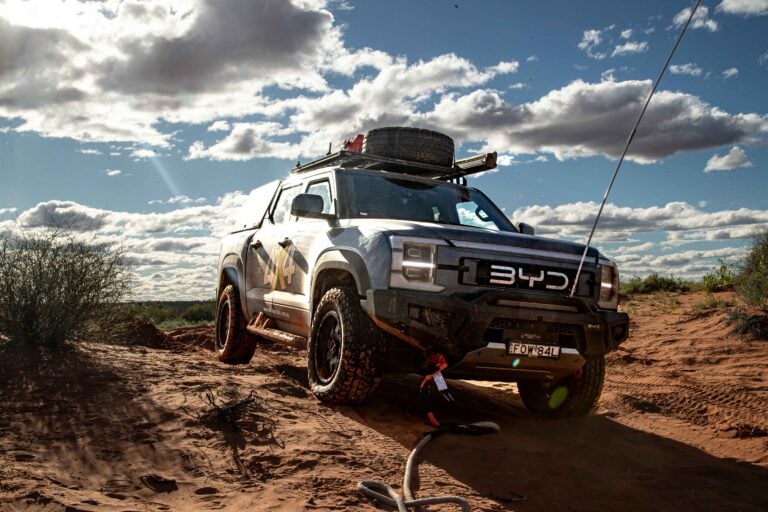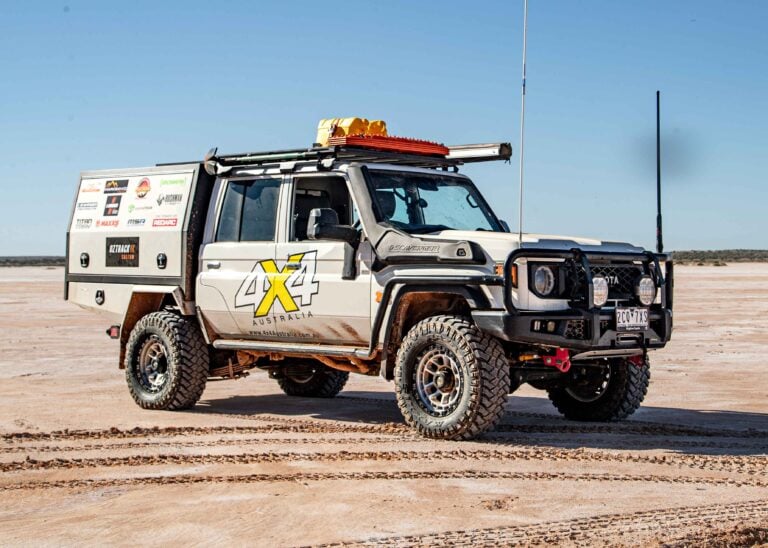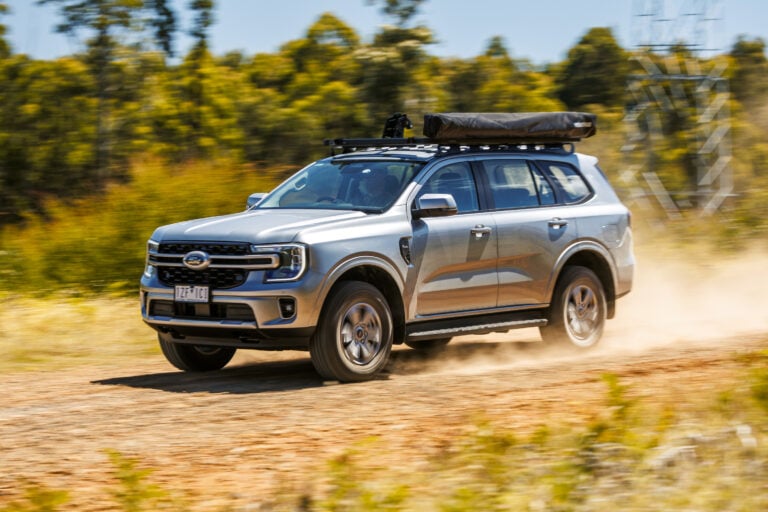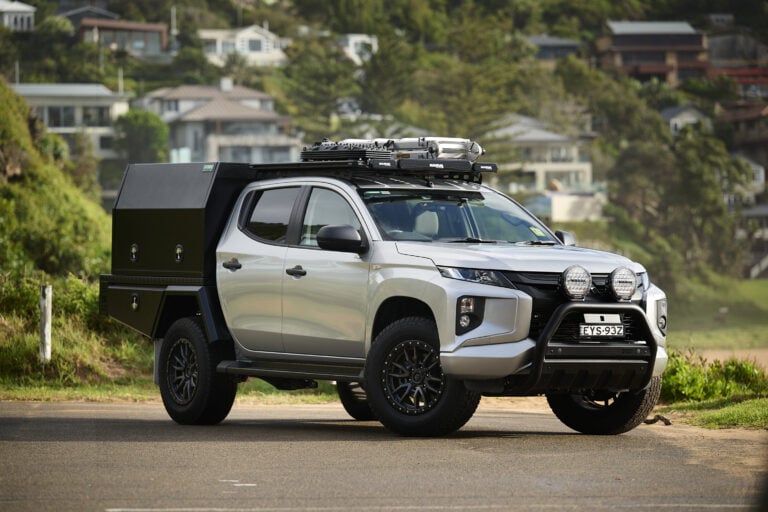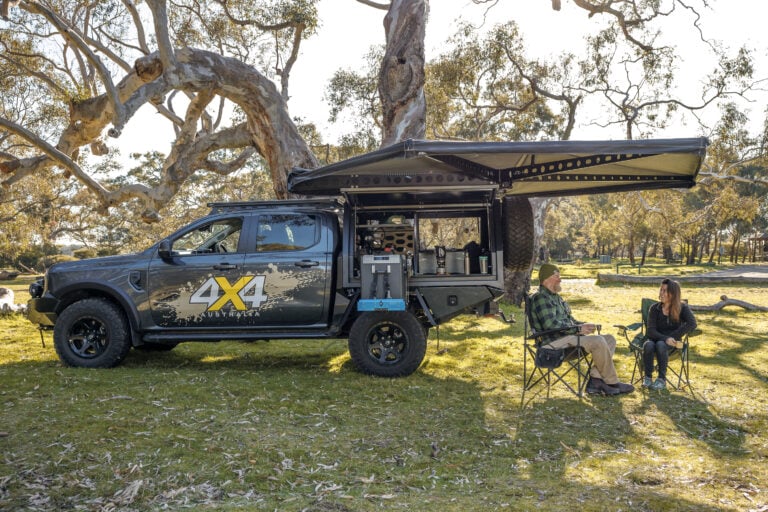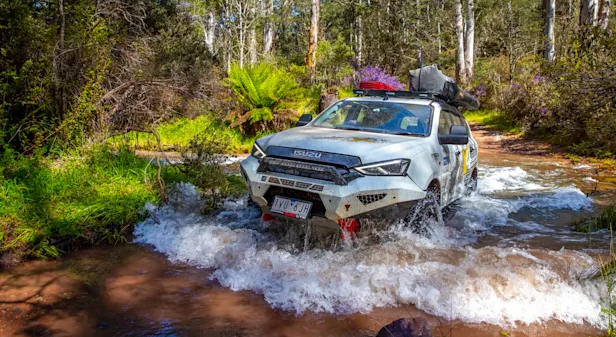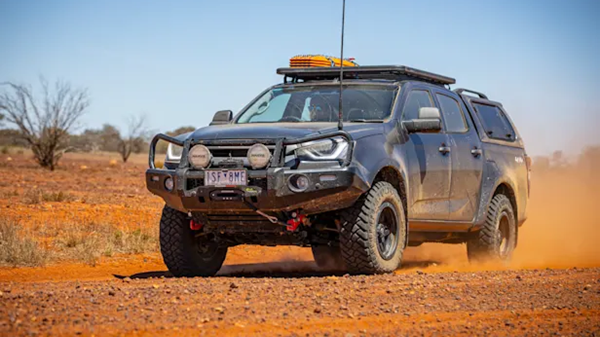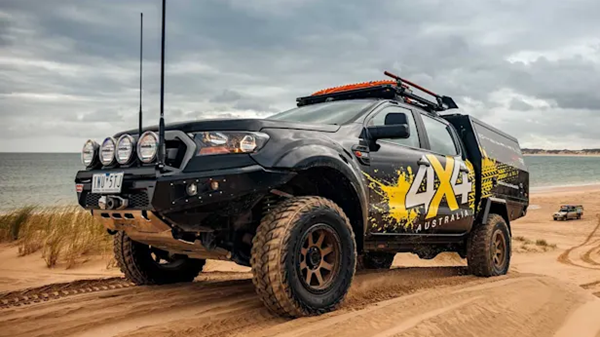- Drive with your lights on. Blind corners and dust are a bad combo – don’t make it more dangerous than it needs to be, eh?
- The road and track in is full of twisties – aka motorbike heaven, so keep an eye out. Most riders are fairly cautious but we’ve seen more than one travelling at speed into a blind corner.
- Polarised sunnies FTW. Easier to read the track and watch for fish in the river, especially around structure if you’re into flicking lures at trout and the odd redfin.
- It’s not 100 per cent necessary to drop tyre pressures but knocking a few psi out will make the ride a lot less shaky, rattly and rolly (looking at you, fellow leaf spring enthusiasts).
- It gets real warm in summer and real cold in winter. Don’t rock up mid-August in the stubbies and singlet. You’ll have a bad time.
- It’s narrow and two-way. You know what we’re going to say here. Approach corners carefully and scan the track ahead for oncoming vehicles whenever possible.
- The major campsites are signposted and give you an idea of the difficulty of access. If you’re in a high clearance 4×4 you should be sweet (although after heavy rain check water crossings carefully). If you’re in more of a soft-roader, stick to the easier accessed spots (there are plenty of ’em).
- It gets busy on the weekends and holidays. The usual etiquette rules apply. Don’t be the guy shouting to his mates two metres away while pumping the Luke Bryan at 11 and generally exhibiting full throttle “yiew!” behaviour. You’re better than that.
- Hill End pub (aka The Royal Hotel) is a great way to top off your trip with a cold one and a feed.
Running wiring from your roof rack into your 4×4 can be a pain in the butt, particularly with modern vehicles and all the complexities they bring.
You might need to run wiring from the roof for all manner of items you may have up there; not just light bars but reversing and camp lights, and any solar connections that you have running to panels on the rack. You could end up with a thick wad of cables needing to run down to power and switches.
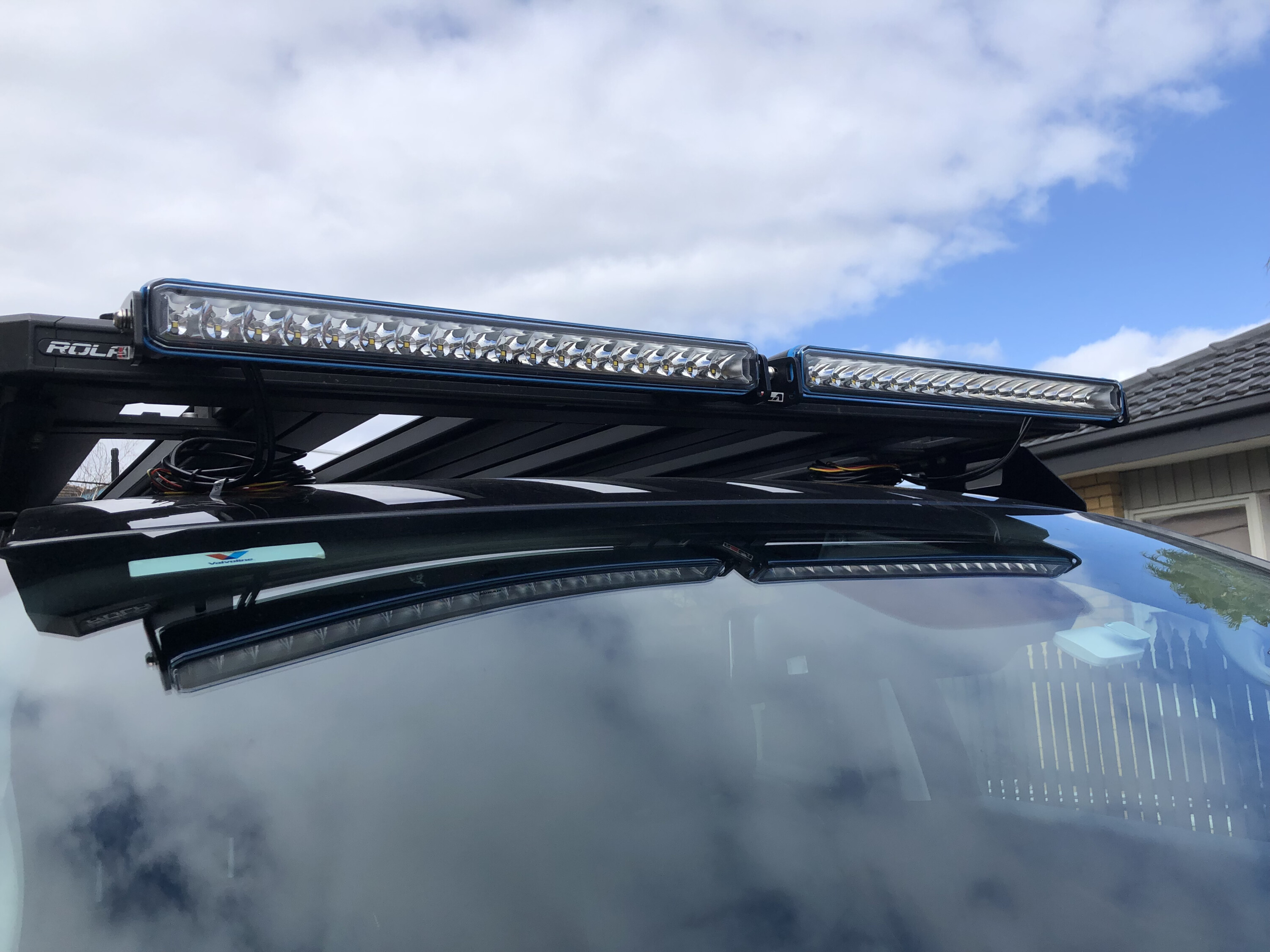
There are all manner of ways of doing this from drilling holes in your roof (not recommended) to running them down through the tailgate on a wagon, tapping into your intake snorkel and running them to the engine bay that way, or just running them down the inside external edge of your snorkel.
When we fitted the Narva EX2 light bars to the Rola Titan Tray on our Ranger, we used this clever wiring concealer from Stedi. It is simply a 1200mm strip of rubber moulding just like you’d find on OE door seals, which you cut to the desired length and stick to the edge of your windscreen with the supplied adhesive tape.
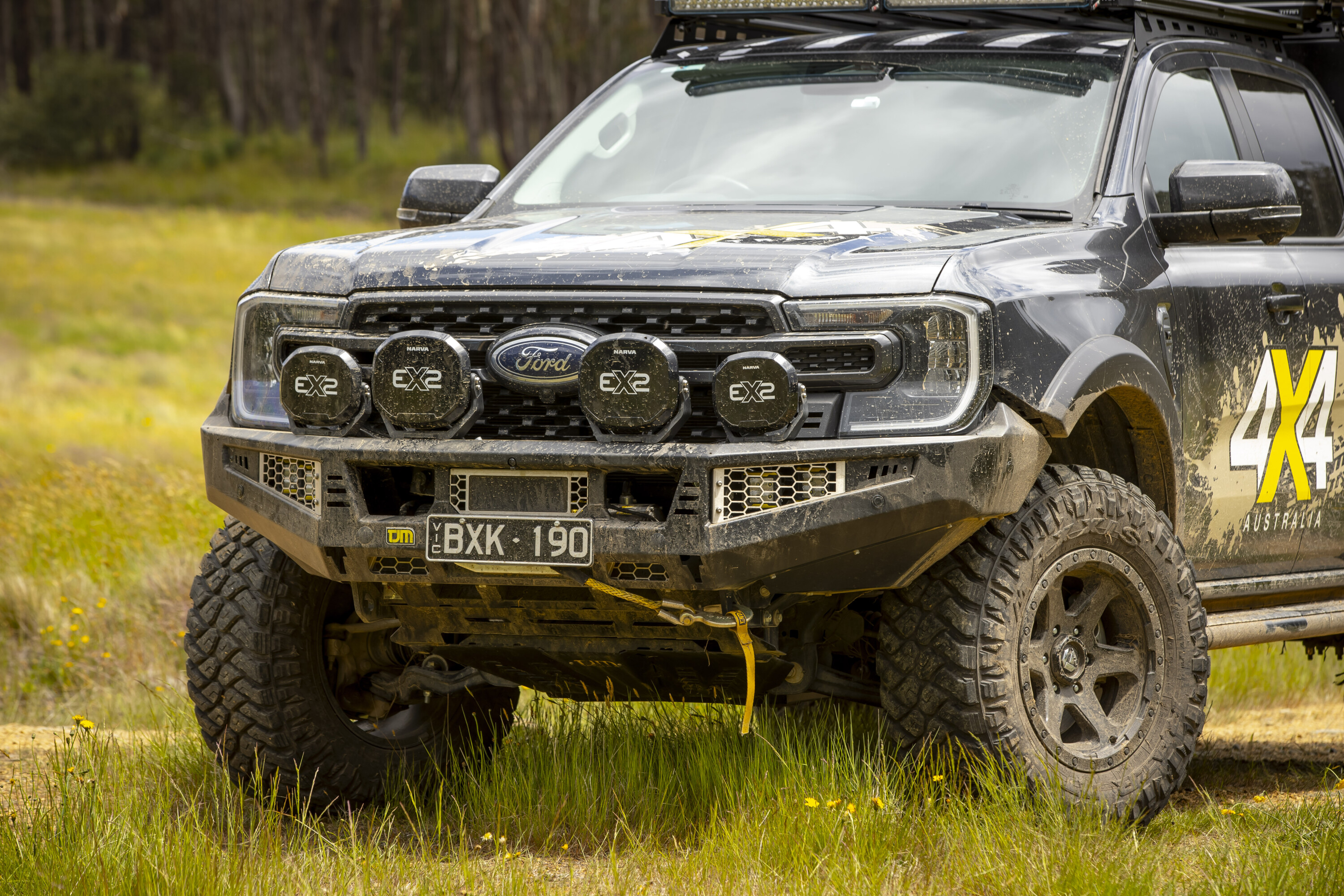
You run your wires down through it and into your engine bay where you can pick up a power source. The channel has around 10mm of inside diameter so you can get a few wires though there, and it locks closed once you tuck it in. It really couldn’t be any easier and the black rubber strip is barely noticeable where it runs down the side of the screen.
We picked the concealer up from our local Repco store for $30, or you can buy it online directly from Stedi or a host of other auto parts retailers.
Mitsubishi is in the midst of a product offensive, with the recently launched 2024 Triton ute to be followed by a host of new metal – including, potentially, a new Pajero.
Snapshot
- X Force Concept & Nissan Patrol-inspired Pajero designs rendered
- Mitsubishi wants a new Pajero, but will it happen?
- It’ll have to be a hugely capable off-roader to carry the Pajero name
One of the already confirmed new Mitsies is a monocoque large SUV. Some have speculated that model will debut as a Toyota Kluger rival – but could it be a 2025 Pajero? Perhaps.
Previously mooted as a platform-share reboot with the Nissan Pathfinder, Mitsubishi executives have since shown an unwillingness to compromise the Pajero’s tough image with a soft-roader reimagining.
Instead, if the Pajero name is to come back – something described as “a wonderful dream” by Mitsubishi president Takato Kato – it’ll be a serious piece of kit.
To whet the appetite (and perhaps even inspire Mitsubishi itself), our mate Theottle has spun up a couple of potential Pajeros inspired by existing products in the Mitsubishi and broader alliance portfolio.
Let’s take a look.
1) Outlander lends its looks to papa Pajero
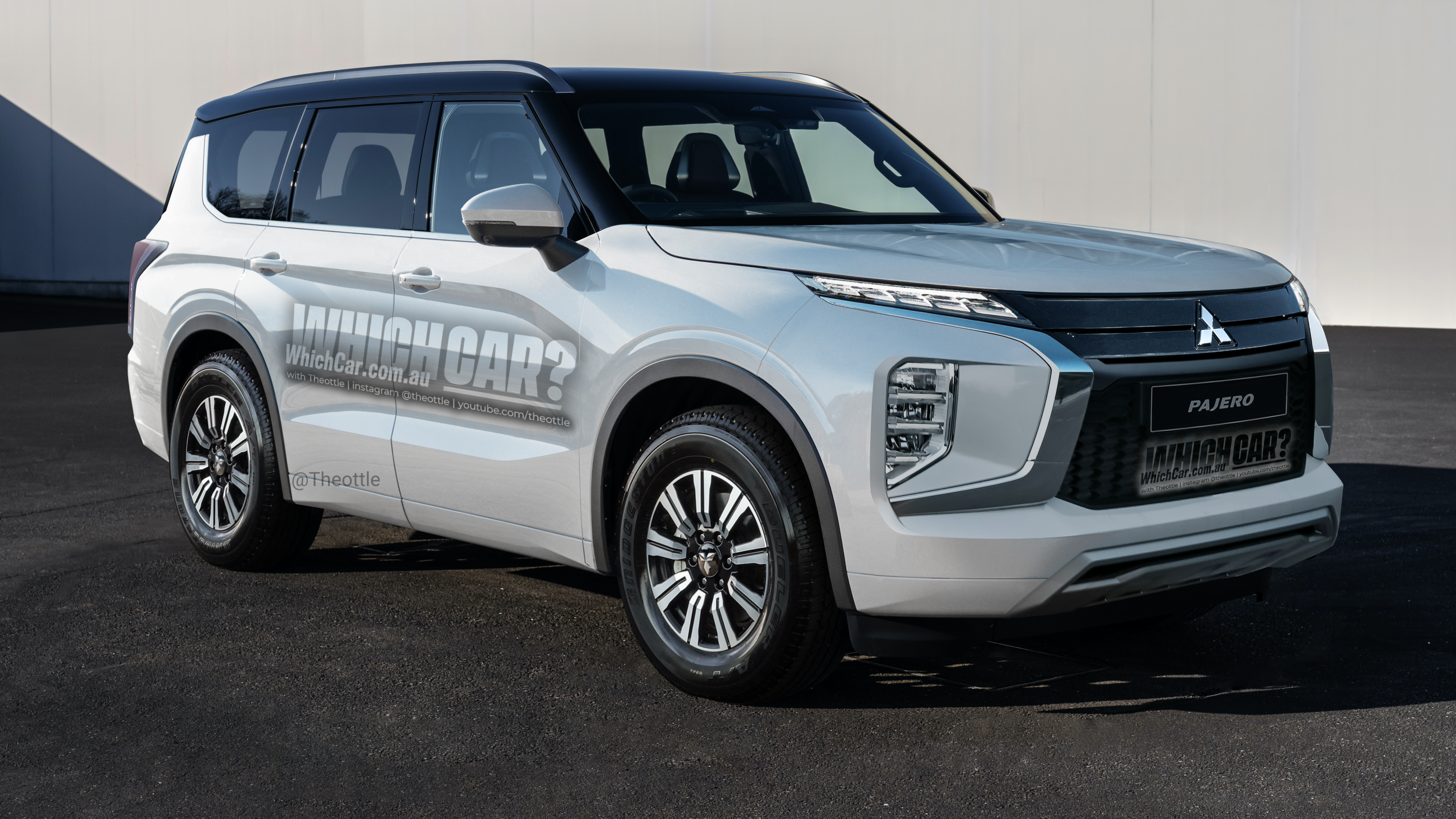
The first of Theo’s concepts takes its cues from the new Infiniti QX80, known to be a preview for the next Nissan Patrol.
To give it a Mitsu edge, Theottle has gone the obvious route of stretching and re-shaping the popular Outlander midsize SUV to suit the proportions and intent of the Pajero.
There’s a clear family connection here to not only the Outlander but also the brutish new Triton – so it could be just the ticket for a new-generation ‘Padger’.

2) XForce expands to large SUV
The second is a burgundy beaut’, with a look inspired by the compact XForce concept revealed in 2023.
If that’s the next ASX, could it also be a hint of Mitsu’s next design direction?
Given such an evolution, we could expect the new Pajero’s ‘Dynamic Shield’ front end and signature lighting to make a distinct leap away from the brand’s current look.
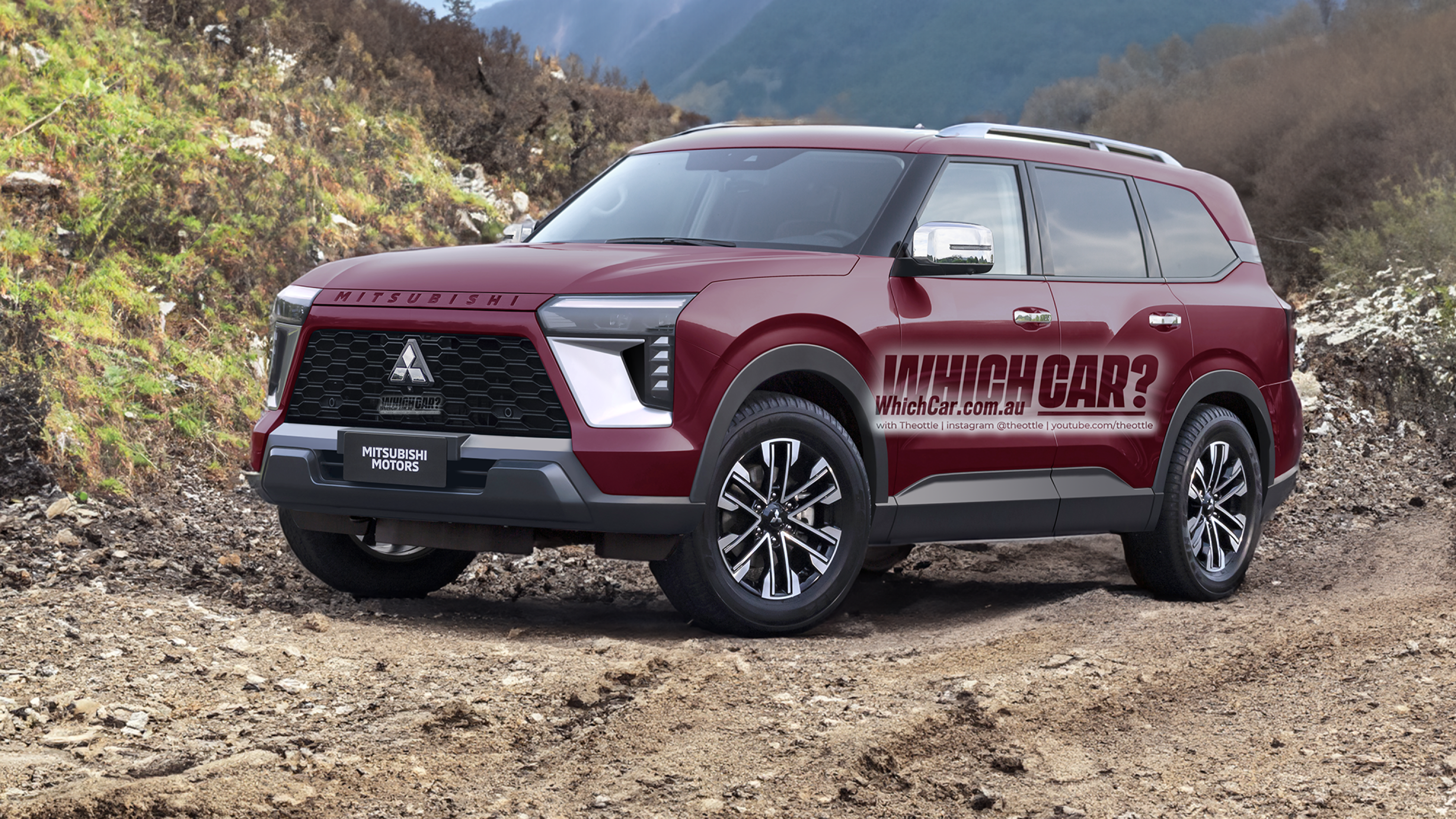
For its proportions, we’ve looked to a combination of the outgoing Nissan Patrol and, again, the big new Infiniti QX80 – or more specifically, the earlier Infiniti QX Monograph.
The rear end, too, carries QX Monograph dimensions and broad shoulder line though it’s accessorised with Mitsubishi-style LED tail lights and alloy wheels from the Pajero Sport ladder-frame SUV.
It is, of course, a huge departure from the last Pajero that first went on sale in 2006 and had various life-cycle updates that kept the monocoque 4×4 going until its plant closure in 2020.
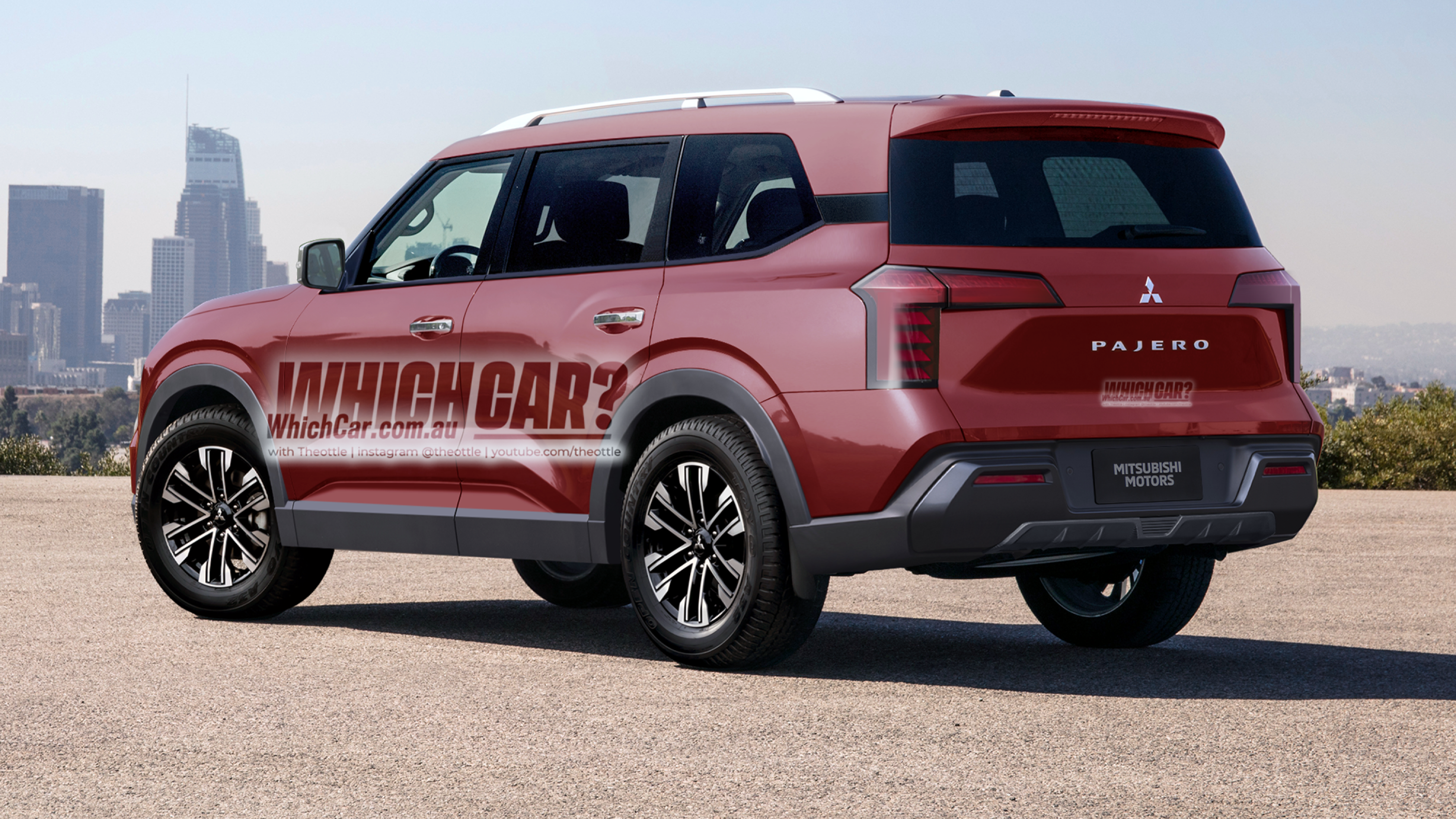
Which would you prefer?
“if we do it, we want to control everything”
Although our imagined Pajero concepts borrow much of their overall shape from Nissan, Mitsubishi’s Pajero (if it comes to be) won’t just be a Patrol clone.
“A vehicle like Pajero? That’s our brand”, Koichi Namiki, general manager product strategy division told 4×4 Australia, adding “if we do it, we want to control everything.”
That could mean the new Pajero would transition to being a body-on-frame vehicle like the LandCruiser 300 Series and Nissan Patrol, utilising a modified version of the Triton’s ladder frame chassis.
It would certainly take the vehicle away from its heritage, but for towing, loading and off-roading, the ladder frame solution could work. Mitsubishi would also be able to better integrate battery-electric or plug-in hybrid powertrains from the ute.
What do you think of our Pajero imagination? Have your say in the comments!
Reading through this feature on the Bridle Track brought back plenty of memories and reminded me you don’t need to go heavy duty off-roading to have a great weekend away from the city.
Back when we were in Sydney, the Bridle Track was a regular route for testing new vehicles; and as we were driving more light-duty SUVs back then, this was the perfect location. The Bridle Track is a place you can enjoy in just about any car, without the need for low range or off-road tyres.
With an early start out of town we could do the drive in a day, including stopping for photography and checking out the sort of things we do when testing new cars. However, the track was always more enjoyable when we scheduled it as an overnighter and had more time to spend on it.
With so many great campsites along the river as you traverse the track, you are spoilt for choice when looking for a camp, especially if you’re out there mid-week when there are fewer people using it. We enjoyed plenty of great nights around a campfire there, extolling the virtues of whatever vehicles we were driving over a couple of coldies.
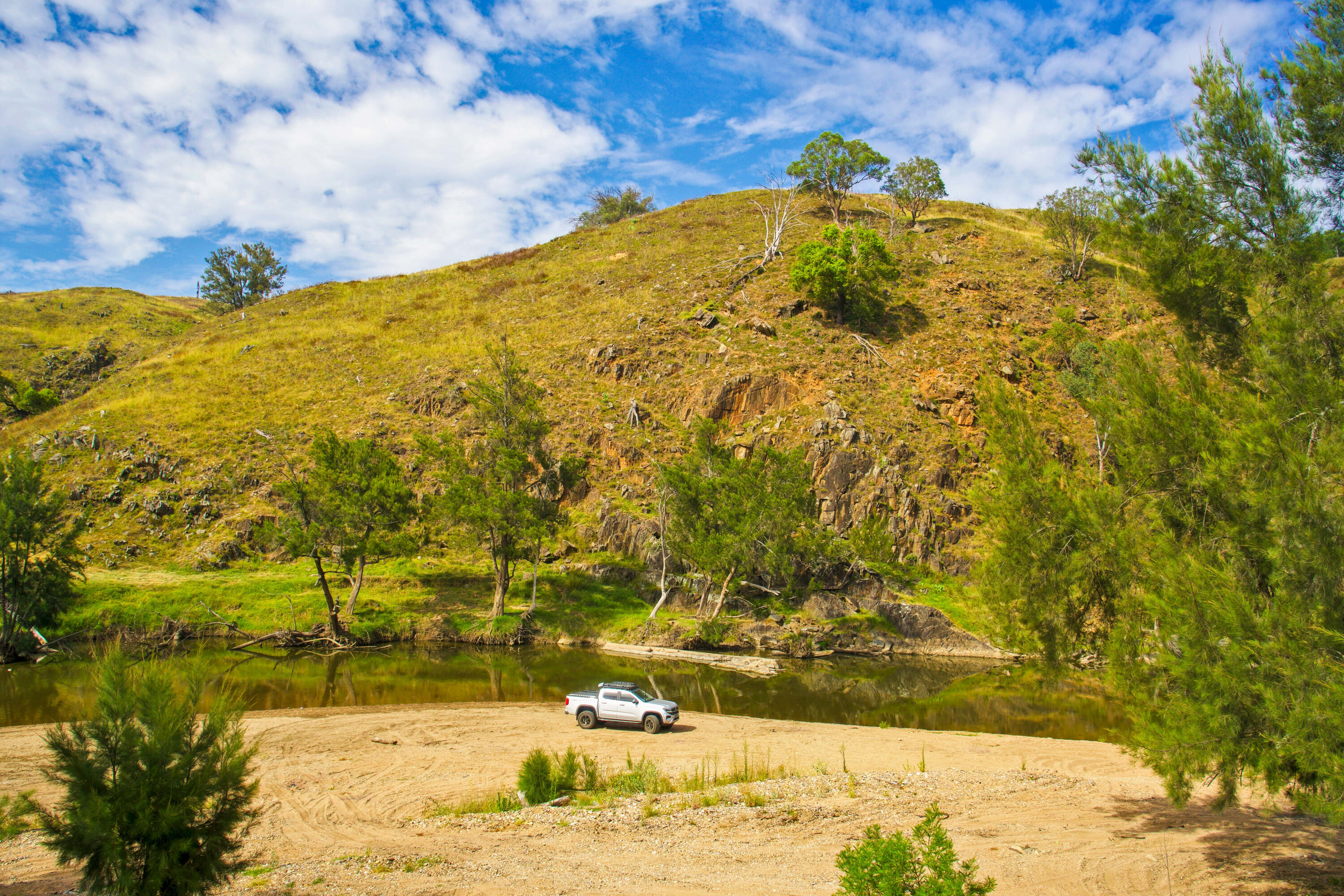
Now that we are based in Melbourne and the Victorian High Country is a comparable distance from us to what the Bridle Track was back then, we tend to head straight up there for its exciting tracks. The Alps also have plenty to offer for owners of soft-roaders; certainly plenty to give you a taste for the adventures on offer and make you think about getting a more capable 4×4 with more ground clearance and low range.
It doesn’t matter what you are driving, there are locations within cooee of all the capital cities that will offer you the chance to escape the rat race, enjoy some fresh air, cool off in a flowing river, and see some amazing sights.
Yes, we see the news stories and photographs of people attempting to take their soft-roaders to places they shouldn’t and failing, but with a bit of research and some common sense (yeah, I know) there’s a world out there to explore without getting into trouble.
The Toyota HiLux has taken the number-one spot as Australia’s most popular vehicle many times in recent years, but this is a ute that has been part of life for generations of Australians for much longer than that.
We talk to three owners for whom the Toyota HiLux has served their family as a reliable, and durable, companion that has kept on exceeding expectations.
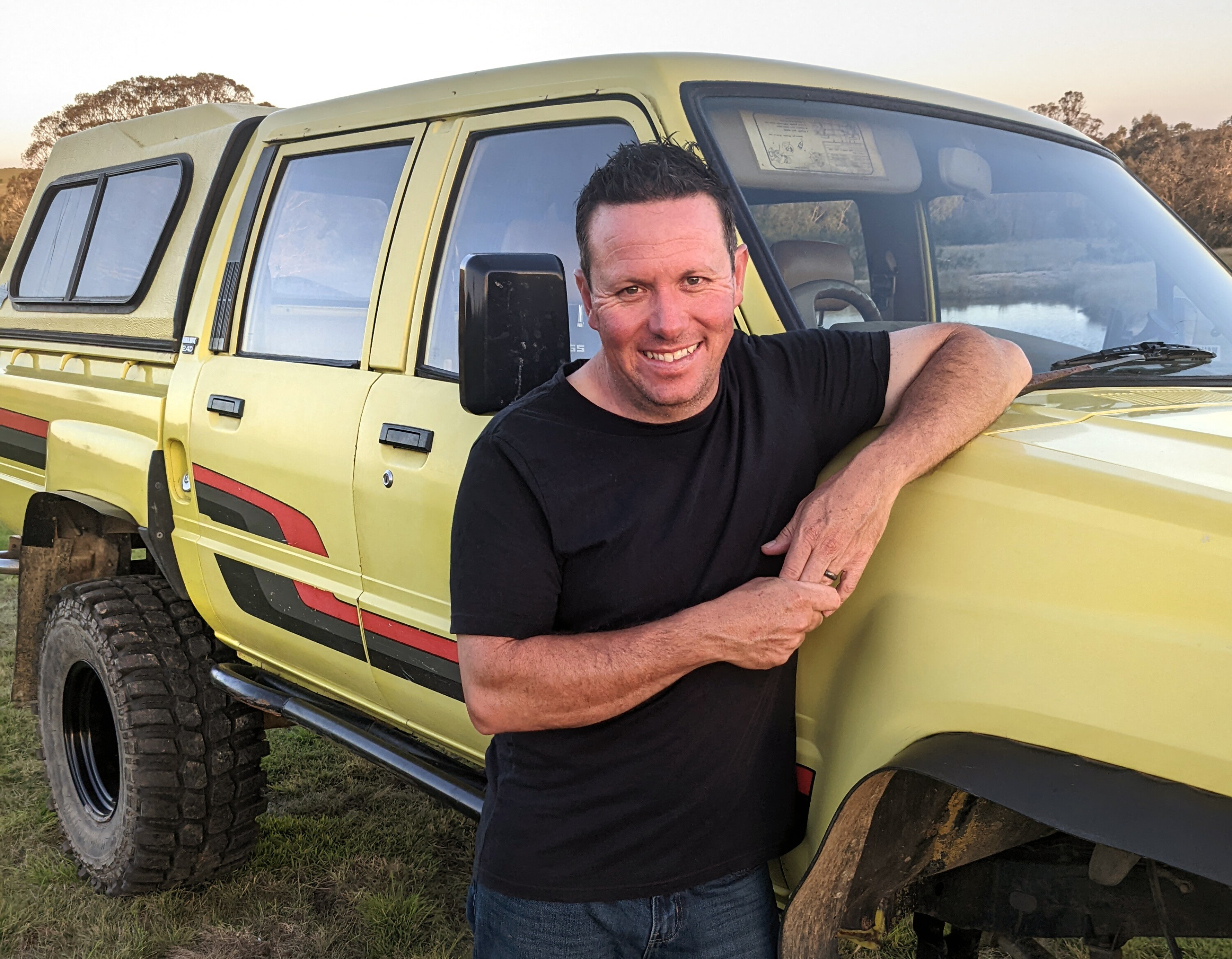
Lawrence’s 1987 HiLux dual-cab
For Lawrence De Pasquale, from Yass River NSW, 1970s and 1980s HiLuxes are what he is most drawn to, even if his family also owns more ‘modern’ Toyotas.
Like many, Lawrence’s HiLux story started young. When he was growing up, he travelled in the back seat of his parents’ 1985 HiLux dual-cab on family holidays deep into remote Australia.
“My parents had a 1985 LN65 dual-cab that we used to travel central Australia and the Victorian High Country with; that’s what started my passion for the HiLux all those years ago,” says Lawrence.
Lawrence bought his first own HiLux – a 1981 model – about 15 years ago and now owns four of them. Two of the utes (both RN46 1981 models) are part of a restoration project while an RN65 serves as a parts vehicle.
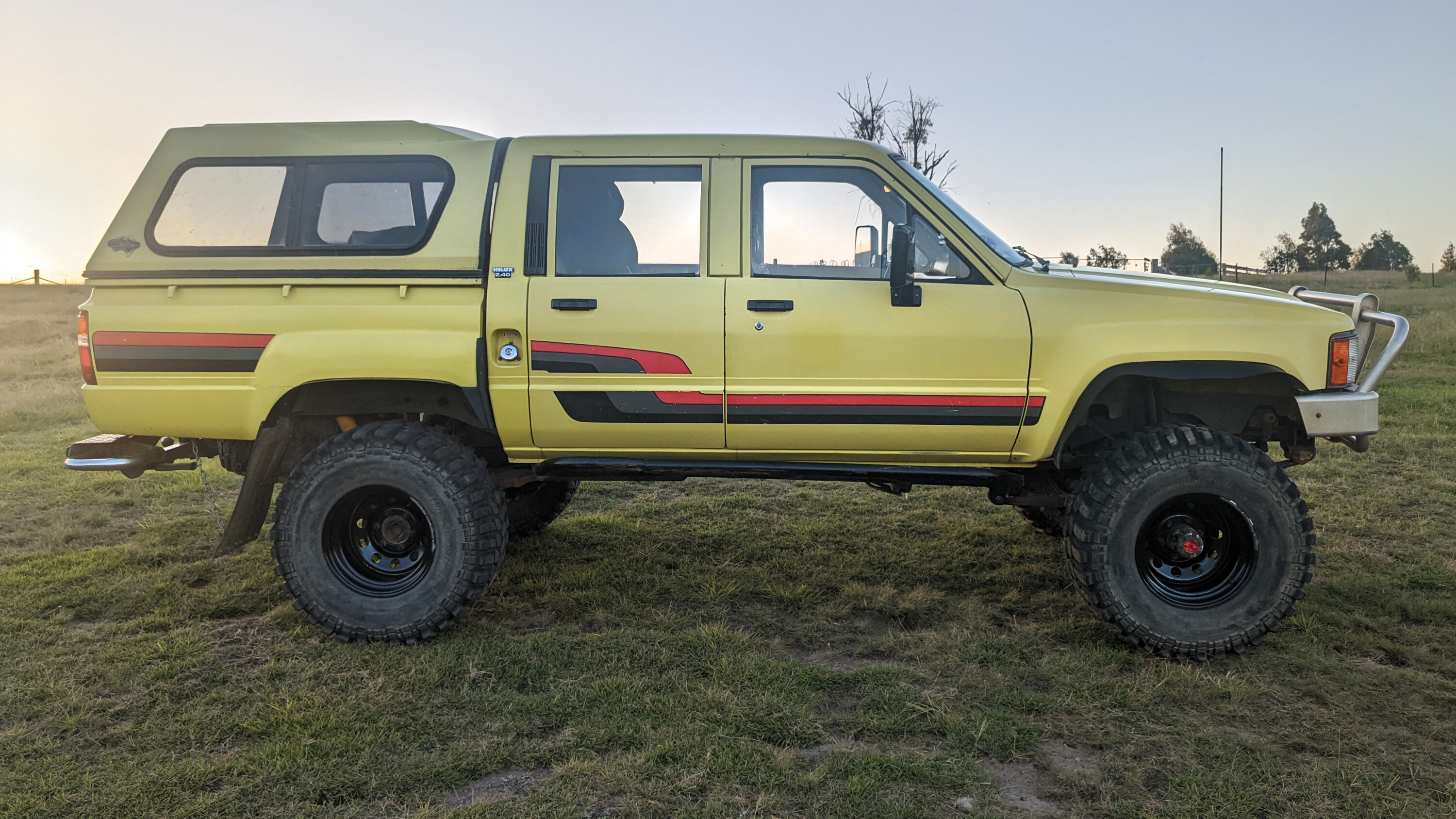
Taking pride of place in Lawrence’s collection is an LN65 1987 HiLux dual-cab, which he has owned for five years.
“It belonged to a guy I worked with. I hounded him to sell it to me for about seven years! Eventually, he did, and I used it as a daily [driver] to begin with.”
The reason Lawrence has so many HiLuxes (and has no plans to move any of them on)?
“I like [HiLuxes] because they’re easy to work on and they’re reliable. Off-road, it’s just the lightness of them, they’re just more nimble, and don’t slide off the track as easily as a bigger, heavier vehicle.”
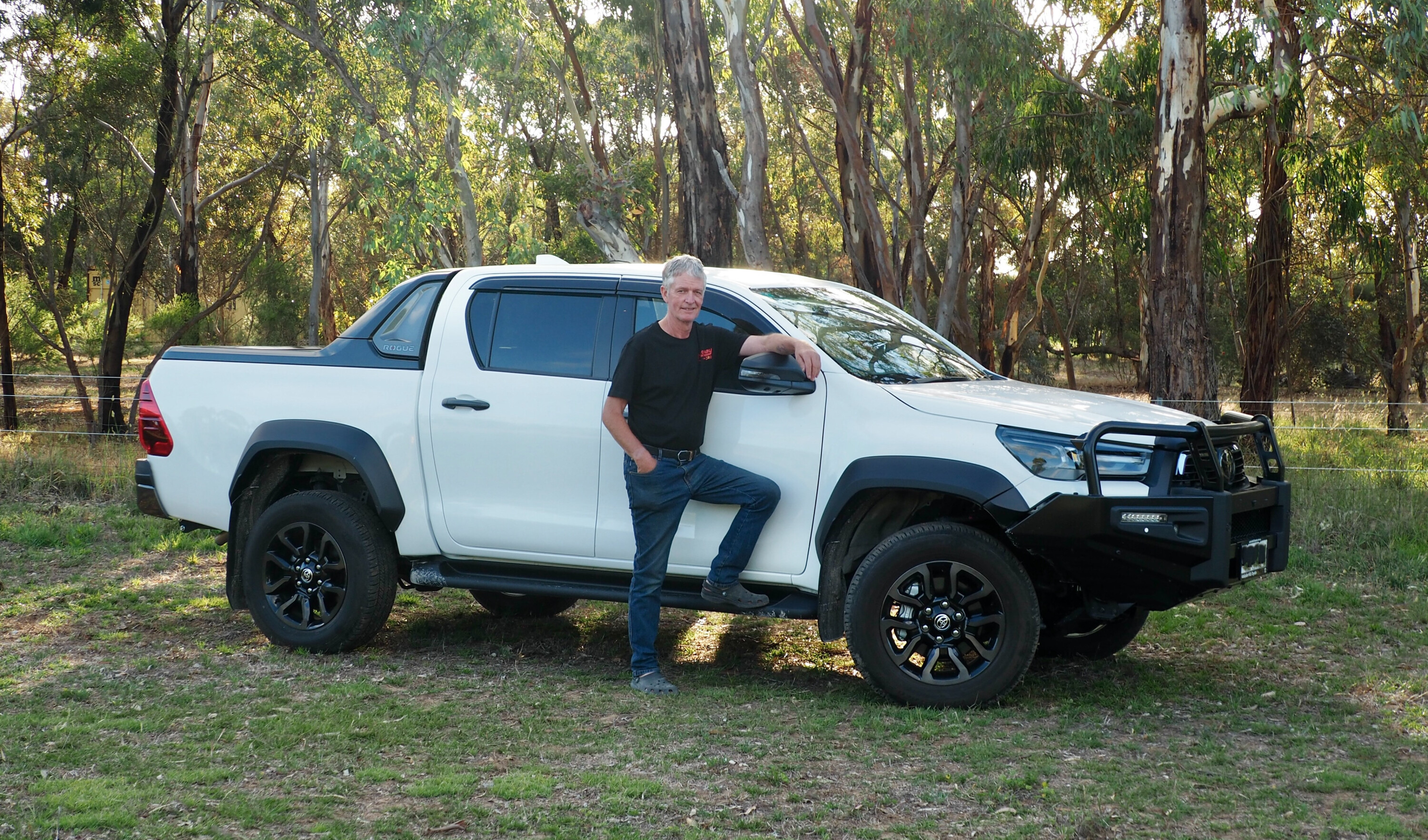
Chris’s 2023 HiLux Rogue
Chris Frizell from country South Australia doesn’t have a large HiLux collection, but it’s a model he has returned to time and again over more than 40 years.
From his first HiLux in 1980, Chris is now up to his fourth – a new HiLux Rogue.
He says what drew him to Toyotas initially was the sheer number of them around him in his formative years.
“When I was growing up, everyone I knew had a Toyota. It goes back a long way. It seemed like just about everyone back then had a yellow Corolla.”
Chris didn’t buy a HiLux as his first vehicle, but it was close. As he knew many people with good Toyota experiences, it seemed natural that his first car was a Toyota Celica. Chris would later buy another Celica, which proved to be just as good as the first.
But when Chris was 19 and working as a merchant seaman, he saw a new 4WD HiLux on the docks at Port Adelaide that ended up being transported on a ship he was working on.
With Chris becoming more interested in doing some camping and off-road motorcycling, he decided to have a closer look at the new 4WD HiLux – a more practical alternative to his Celica. That curiosity began a life-long appreciation for the HiLux that continues today.
Not long after, Chris walked into CMI, the local Toyota dealer, and bought a new 1980 2.0 18R petrol HiLux SWB (short wheelbase), one of the first ‘shorties’ in South Australia.
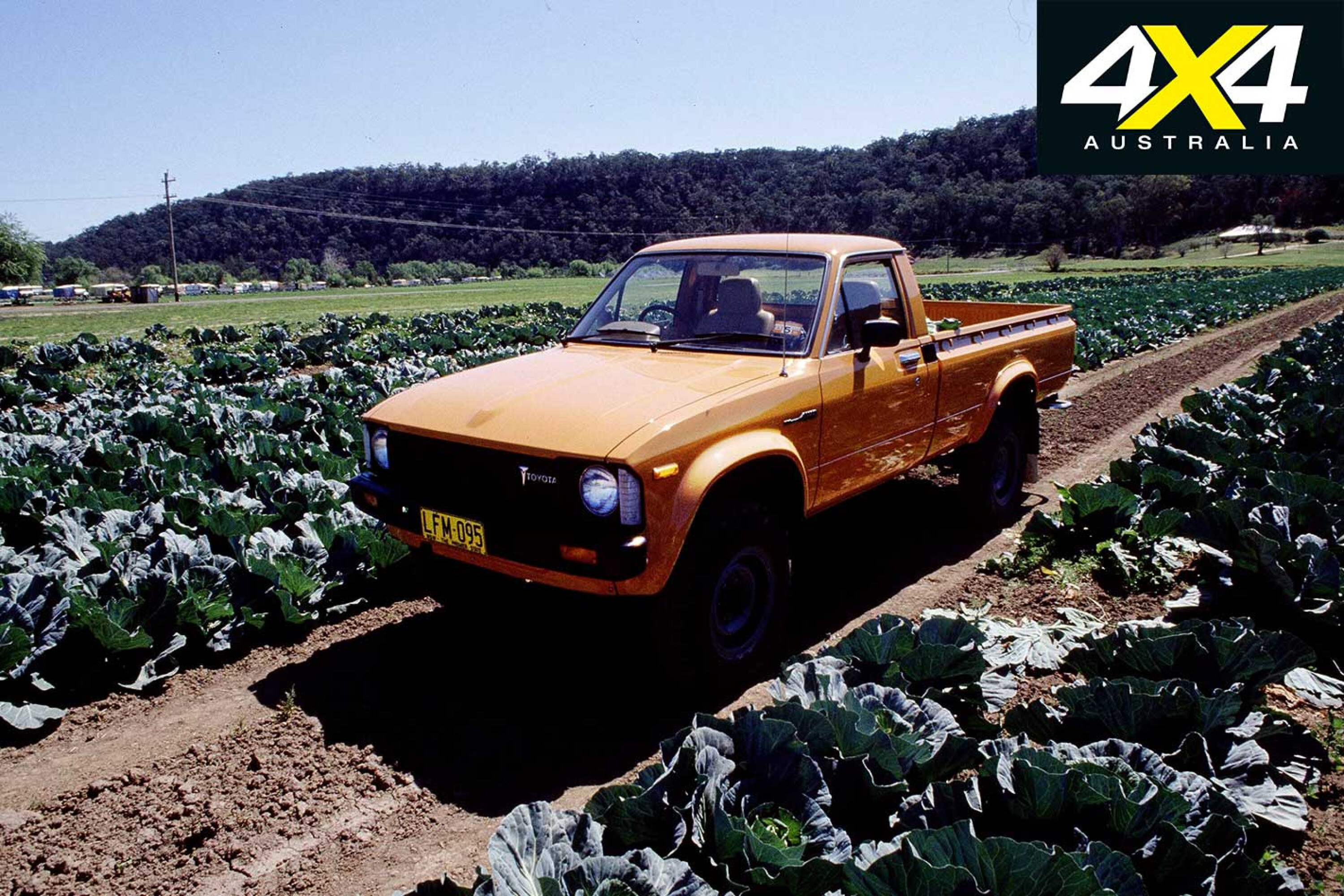
Chris would end up being hugely impressed by the HiLux’s reliability and durability.
“I did 200,000-plus kilometres in that thing and didn’t spend a cent on it for extra maintenance.”
One thing that the HiLux has done for Chris is open the door wide to the great Aussie bush. His HiLux regularly took him all around the bush tracks of South Australia, including the Flinders Ranges and Gammon Ranges.
“It opened up possibilities for fishing, camping, getting out on the motorbike. You could go anywhere.”
“In the late 1980s, I traded that in on the HiLux Extra Cab. That was also a petrol – a 2.2-litre [with] five-speed [transmission] and very reliable. That sort of experience brought me back to Toyotas. Then around 2005, I bought another HiLux: a Twin Cab 3.0 turbo-diesel. That was a good car, too.”
After a time driving other vehicles from other brands, Chris recently bought a 2023 Toyota HiLux Rogue. “I just keep going back to the HiLux. This Rogue I just bought will be my last car I reckon; it’ll last me until I can’t drive anymore, that’s for sure.”
What drew Chris back to the HiLux is his experience with the model over many years.
“I’ve been all over the place, done various things in HiLuxes and I’ve never had any dramas with them. I never had a problem mechanically, and I’ve given them a fair old hiding over the years – especially the first one,” he says.
Chris has seen big changes with the HiLux since he first walked into that CMI showroom all those years ago – except for in one area.
“I think what has changed the most is the technology and safety features,” he says. “From the 1980s petrol four-speed manual with nothing but seatbelts to the Rogue with four-wheel discs, [crash] avoidance technology, driver aids and the sound system. Still tough, but much, much better.”
What Chris likes most about his HiLux experience is that he knows the ute is going to do exactly what is says on the tin, every time. “Basically, I know I can get in [a HiLux], drive it, and it’s not going to let me down; they don’t fall apart. It’s been a good journey.”
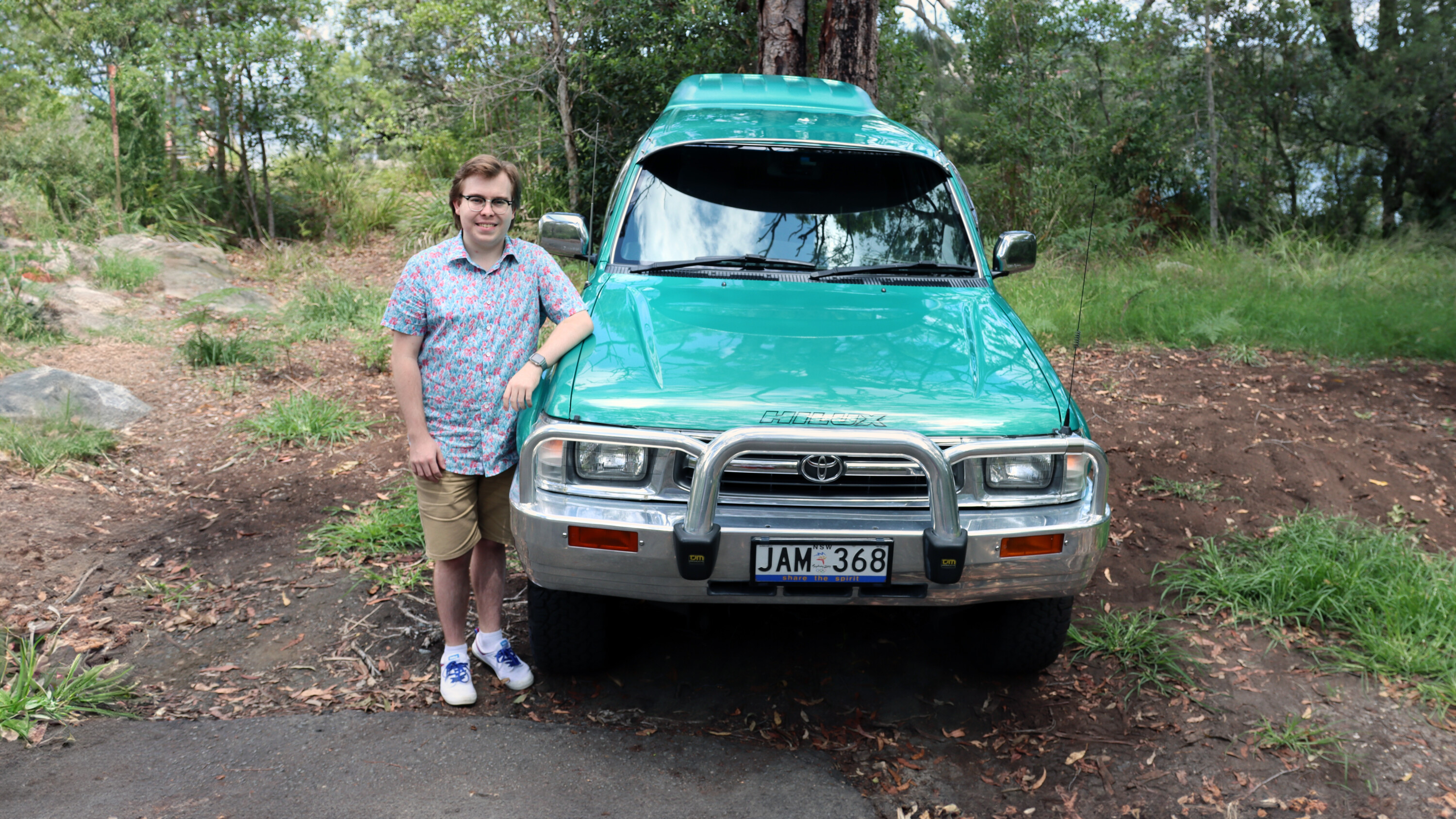
Charlie’s 1998 HiLux SR5
For Sydneysider Charlie Munns, his mum’s 1998 HiLux SR5 has become more than just the family car. It has been around so long that it has become part of the family, as he explains.
“It was the first car I ever knew. Mum bought it brand new in Sydney in 1998, before I was born. It’s been the main family car we’ve had ever since. Mum decided that she liked that model through friends who had them, while dad had a previous-generation live-axle single-cab HiLux for his work, and that’s what solidified the reputation for the model. She wanted something reliable and dependable.”
Charlie said the ute was one that the family expected to keep a long time, so they wanted something a little different, a little special. “It was a car that was hard to find in that Opal Metallic Green colour; in fact, that was the only one at that time in the country. It was sourced from the Bathurst area.”
The Munns’ HiLux has been used as an urban run-about and holiday tow-hauler ever since.
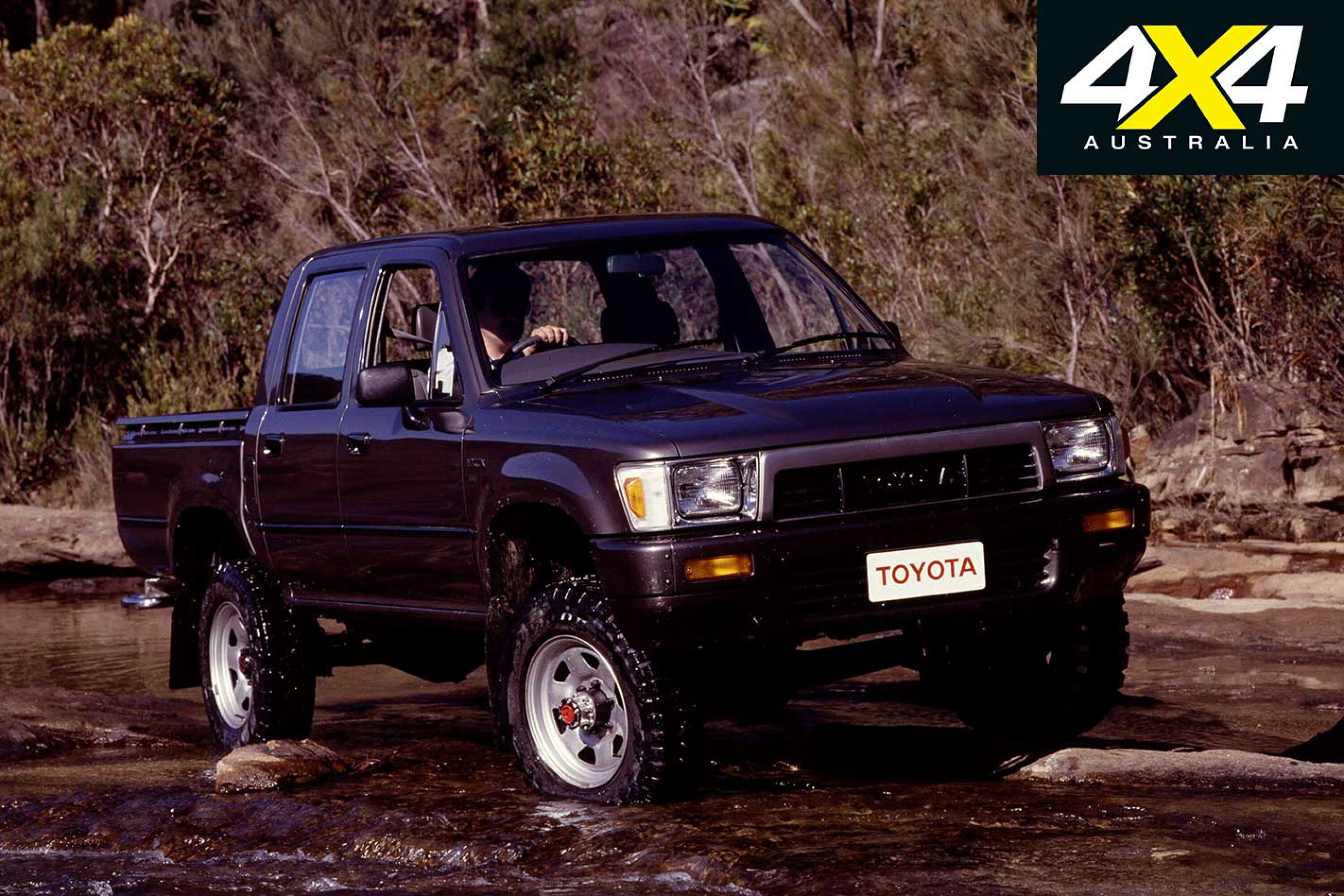
“We used to tow our sailfish catamaran to Port Stephens and back for the annual holidays for 20 years,” Charlie says.
“When I was young I was quite ill, and that car got us to the hospital and back, even at three in the morning – we could rely on the car. It’s got a bit of family fabric to it.”
The HiLux has just less than 290,000km on the odometer now, and while Charlie says it’s had a bit of a cosmetic birthday, it’s mostly original.
Charlie sums up what it’s like to live with a HiLux for as long as he can remember.
“From a lifetime experience, we’ve had the same Toyota for 25 years, and it’s not just a car, it’s become a dependable part of the family. It’s always been the go-to car if we need to get something done.”
“The idea is that I’ll take over ownership of the HiLux in many years’ time, and for it to stay in the family. There are no plans to sell.”
If you’ve been into four-wheel driving for more than a few minutes, chances are you’ve heard of this place.
A couple hours northwest of Sydney, just out of Bathurst, the roughly 50km-long Bridle Track was the place to go if you were just cutting your teeth in the off-road scene. Or at least it was up until 2010 when a colossal rockslide at Monaghan’s Bluff shut the track down for the next decade and a bit. Fast forward to 2023 and the track (finally) re-opened and it’s still a fantastic place to spend a sneaky night or two.
It’s not so much about the off-road driving – to be honest you could drive a fair percentage of it in your grandad’s Camry – it’s more about marvelling at the landscape, the wildlife and finding that beaut little campsite that you and the family will remember for the rest of your lives.
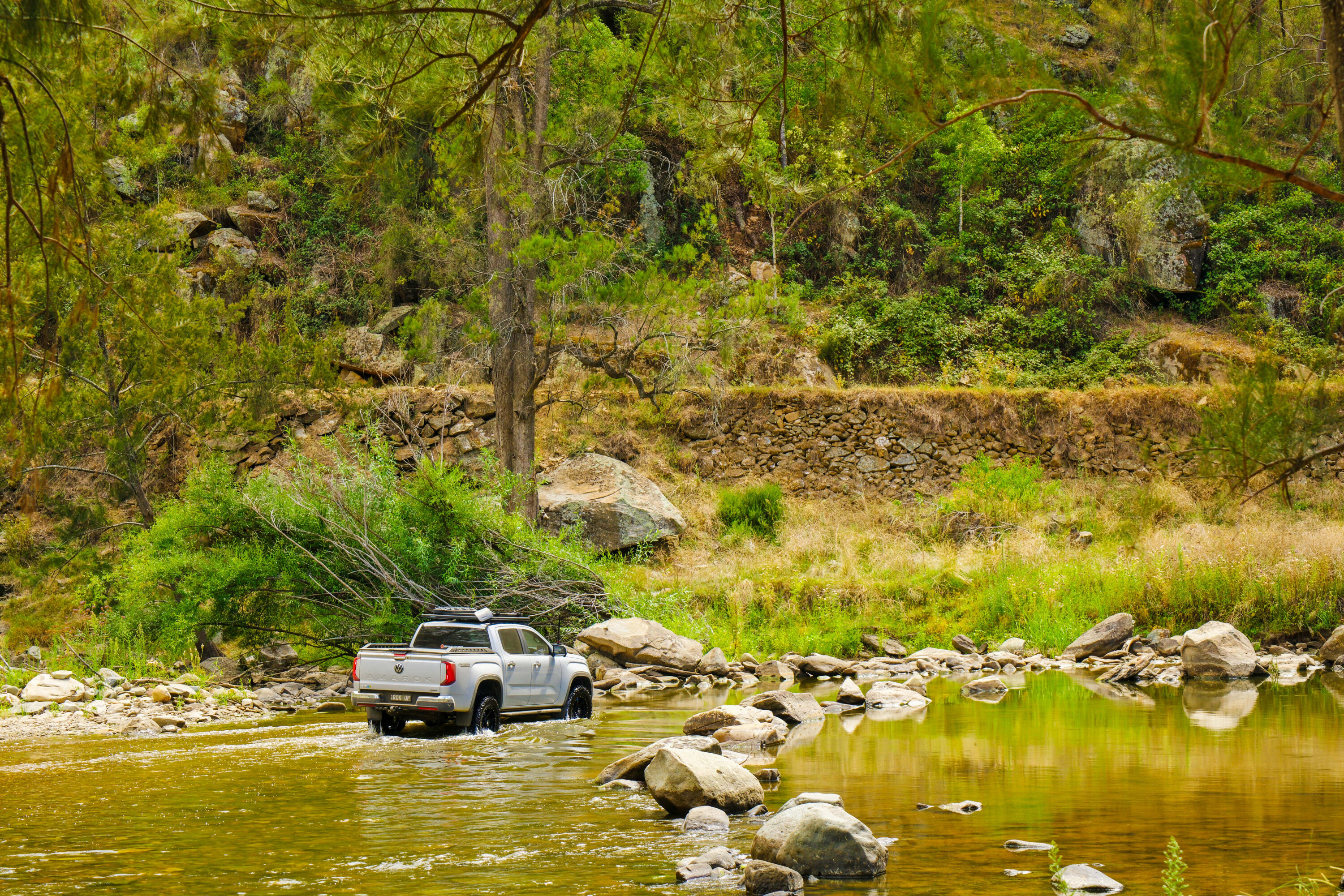
The history of the joint
The track was opened for gold miners to get from Hill End to Bathurst in the mid-1800s without having to go via Sofala.
It was coined because it was so narrow you had to lead your horse by its bridle, and the name stuck. By 1870 it had been widened to allow passage of carriages and by the 1930s it had become a tourist drive, predominantly for motor vehicles.
You will notice a lot of evidence of the mining history dotted along the track, including tunnels, or adits if you want to get technical, that can still be accessed by the non-claustrophobic adventurer.
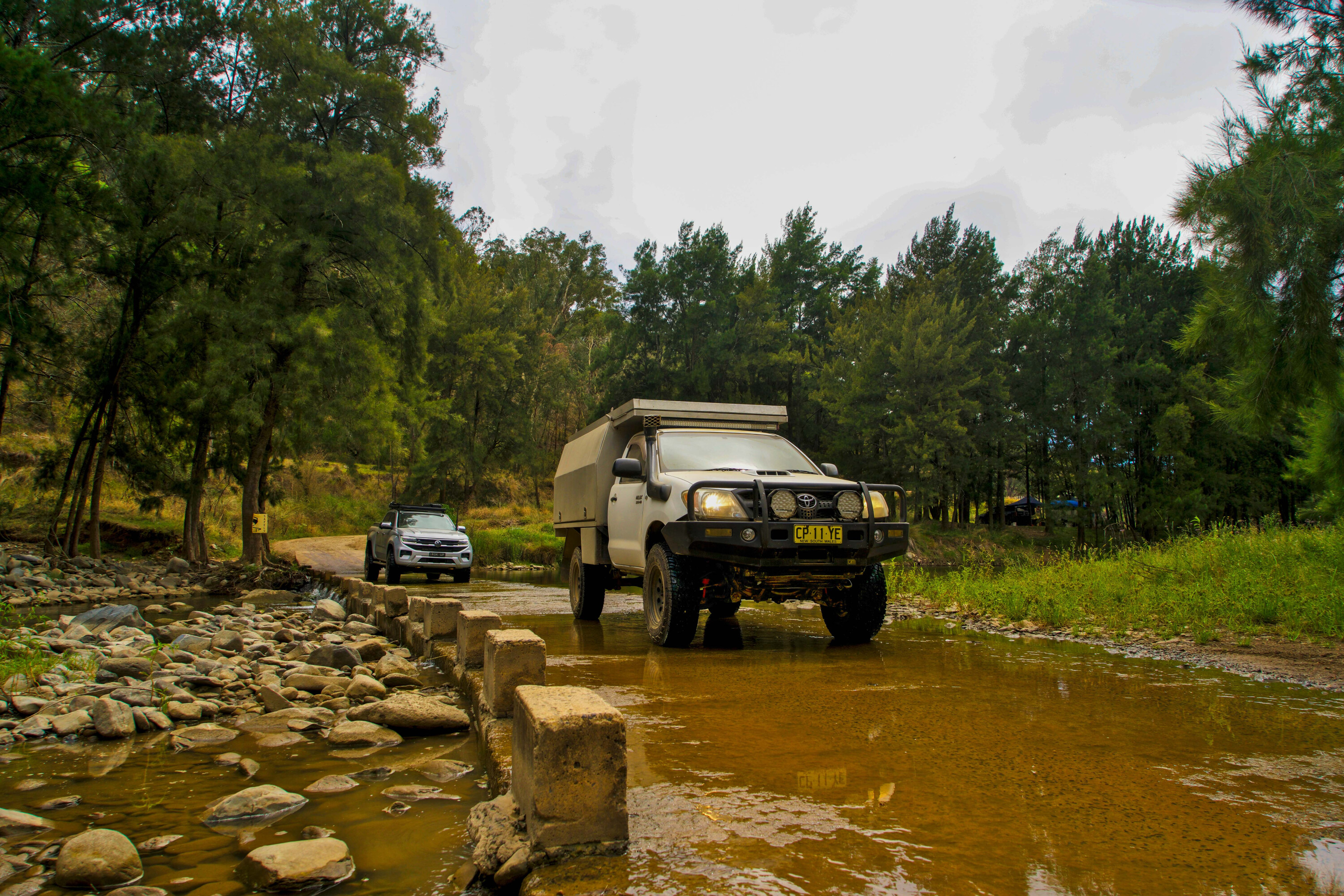
Getting there
If you’re navigating by the stars, head northwest out of Sydney till you hit Bathurst, then hang a right up Duramana Road for a few kays until you see a big ol’ sign saying “Bridle Track”.
Or, if you like doing things the non-difficult way, just slap Bridle Track into your GPS and let it do the heavy lifting. It’s a gazetted track and well signposted. There are probably easier tracks to find, but we can’t think of too many.
Day trips are a possibility and would be great for the kids (big or little) given the abundance of flora, fauna and swimming holes on offer.
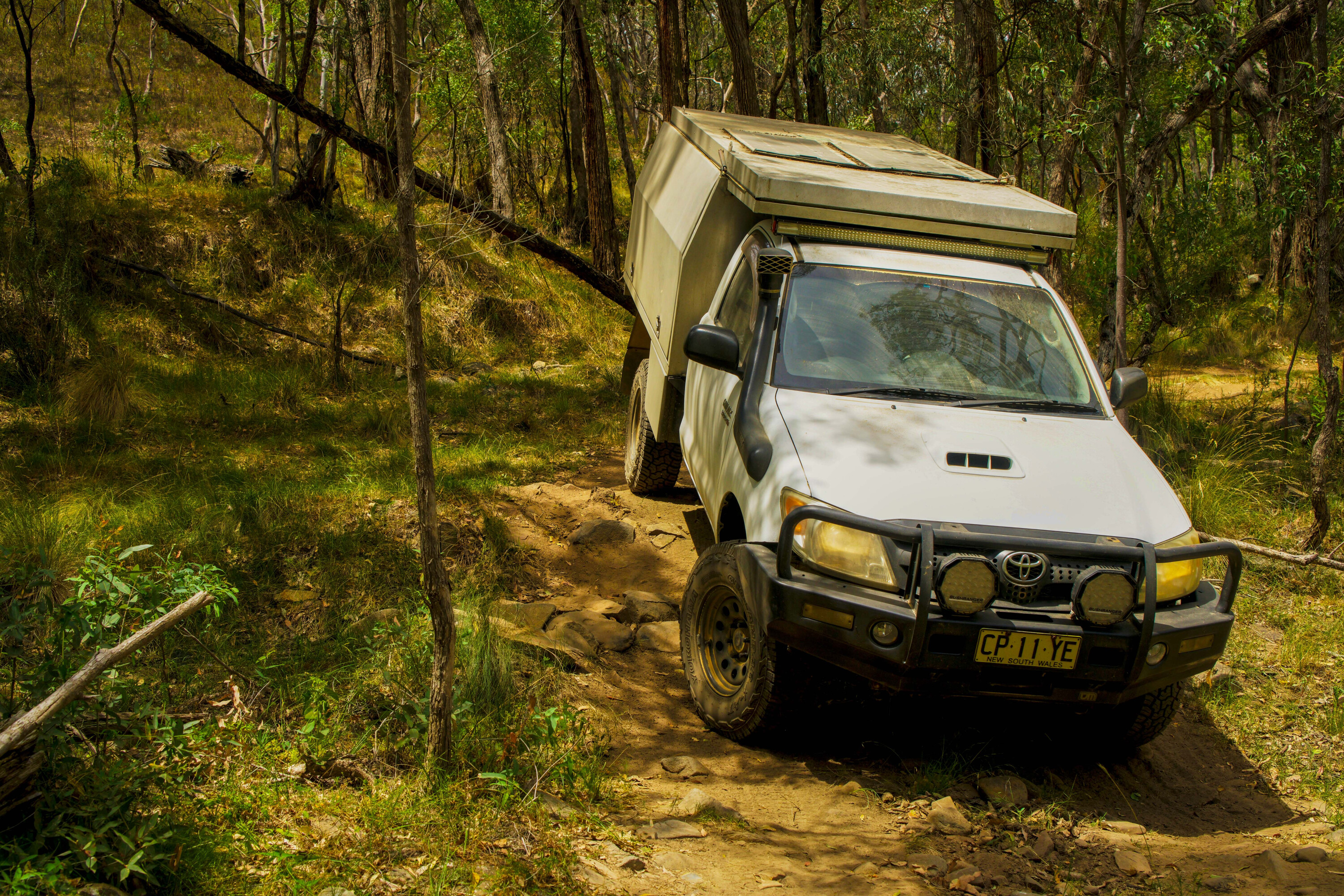
However, you’d be missing out on a huge part of what makes this place so special – the camping. It’s seriously up there with some of the best in the country.
Right on the river, easily accessed and all pre-paid via your taxes. It’s spot on for bringing the tin lids and letting them run wild on the high-fructose corn syrup that’s pumped into everything these days, or equally ideal for a few mates to knock the top off a few Denzel Frothingtons after a busy week.
There are even toilets and if you have a more modified vehicle, there are quite a few campsites off the map that don’t get the influx of people.
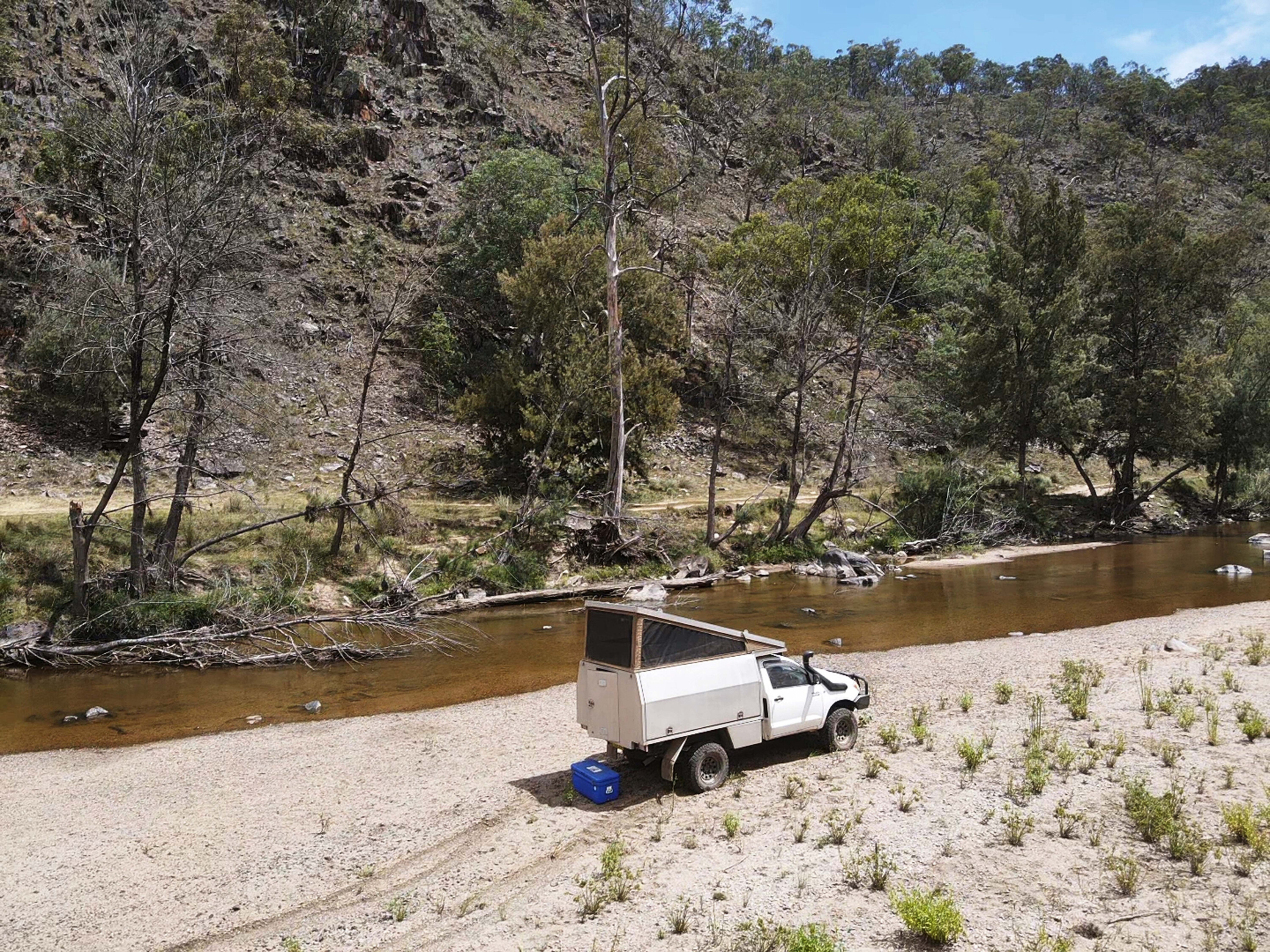
Recommended gear
This is an excellent overnighter for people with stock or lightly modified 4x4s. While there are a few tricky-ish side tracks, don’t expect your LS-swapped, 37-inch tyre sporting Patrol to be particularly challenged.
But that’s not what this place is about. It’s about easy access, idyllic camping on the banks of a crystal-clear river system (well, two river systems, the Macquarie and the Turon, but who’s counting?) within a couple hours’ drive of a major metropolitan centre. If you can’t find something to like about that then who are we to judge? Still, you seem kind of cranky; is everything okay at home?
Anyway, bring your camping gear, enough food and drinks for your trip and maybe throw in a snatch strap or two if you like being super-prepared.
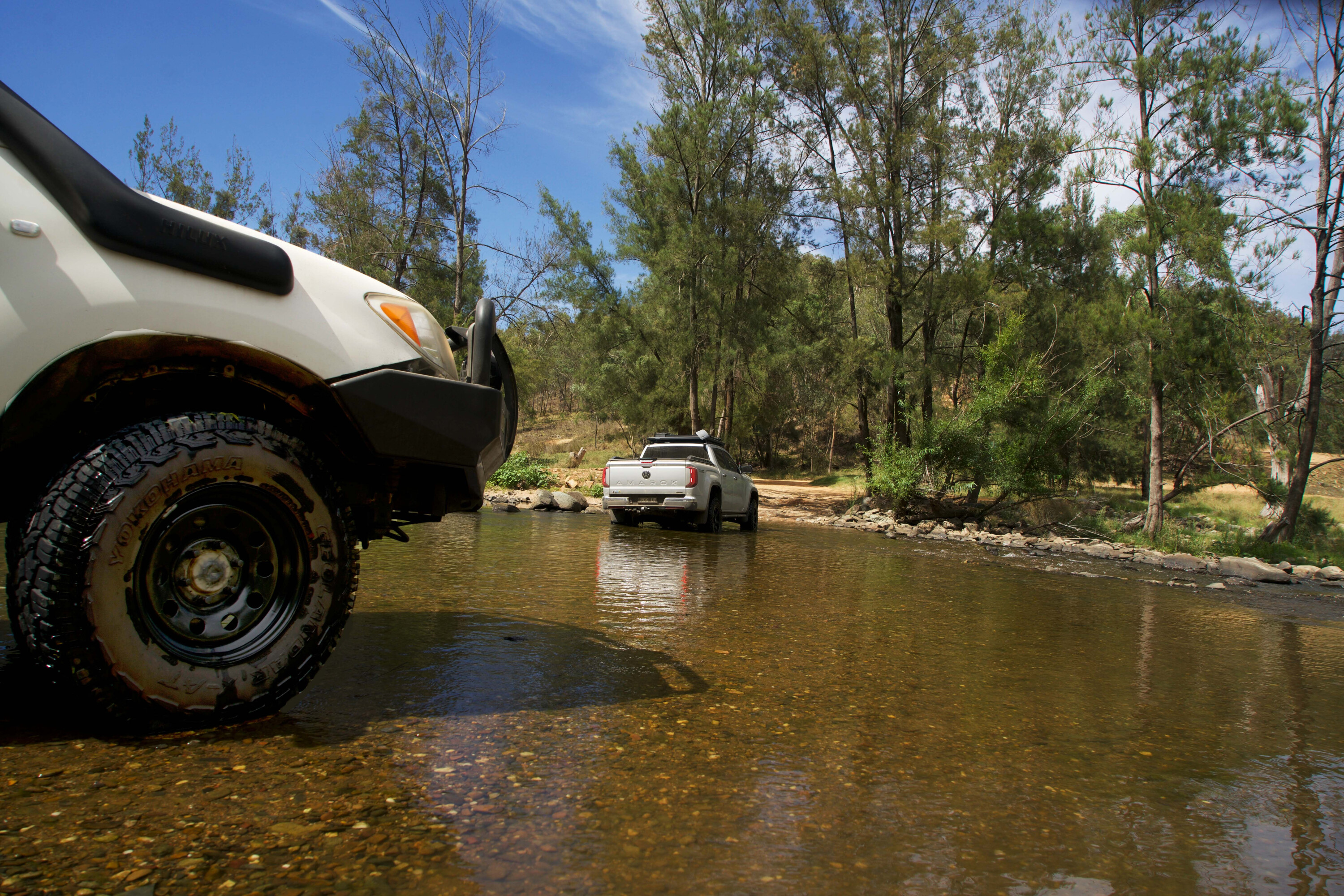
Camping access
As mentioned, it’s predominantly 2WD or high-range 4×4 touring, but conditions are more variable than Australian Prime Ministers over the last decade, so bring your wits and keep ’em about you.
Heavy rains the previous week can affect big changes in river depth and flow, and the trickle you camped next to last month may be closer to a raging torrent this time around.
With that said, this is one of the best beginner trips within cooee of Sydney (or Bathurst, duh) and while the wheeling is far from what you’d call difficult, the conditions can easily catch you out if you’re not ready.
Realistically though, there’s so much to see and do. The main sites are well signposted and well-appointed with plenty of room for everyone.
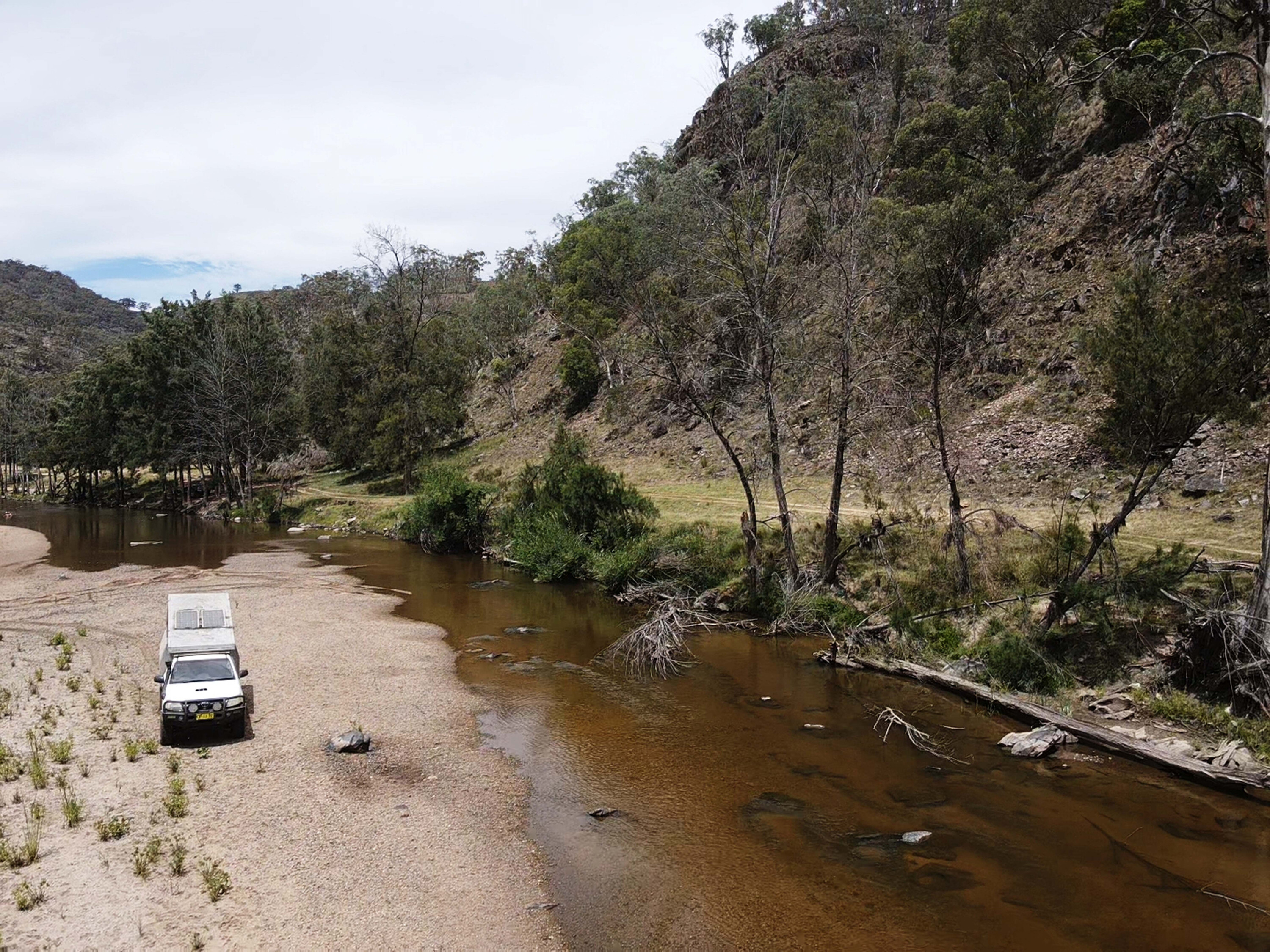
Firepits and long drops are provided at regular intervals too, which is a far cry from the usual NSW National Parks over-bollarding of anywhere remotely cool, but we digress…
In truth, the most difficult decision you’ll have to make is whether to go for a site on some lush green grass or head for the soft loamy beach, a literal pebble toss from the water.
This time around we camped at the bottom of an unmarked track (Sammys Hole), which was steep and rutted enough to require low range and some judicious wheel placement. The payoff was that we had the place to ourselves a couple of metres from the river. For a cruisy drive a couple hours from the ’burbs this is as good as it gets.
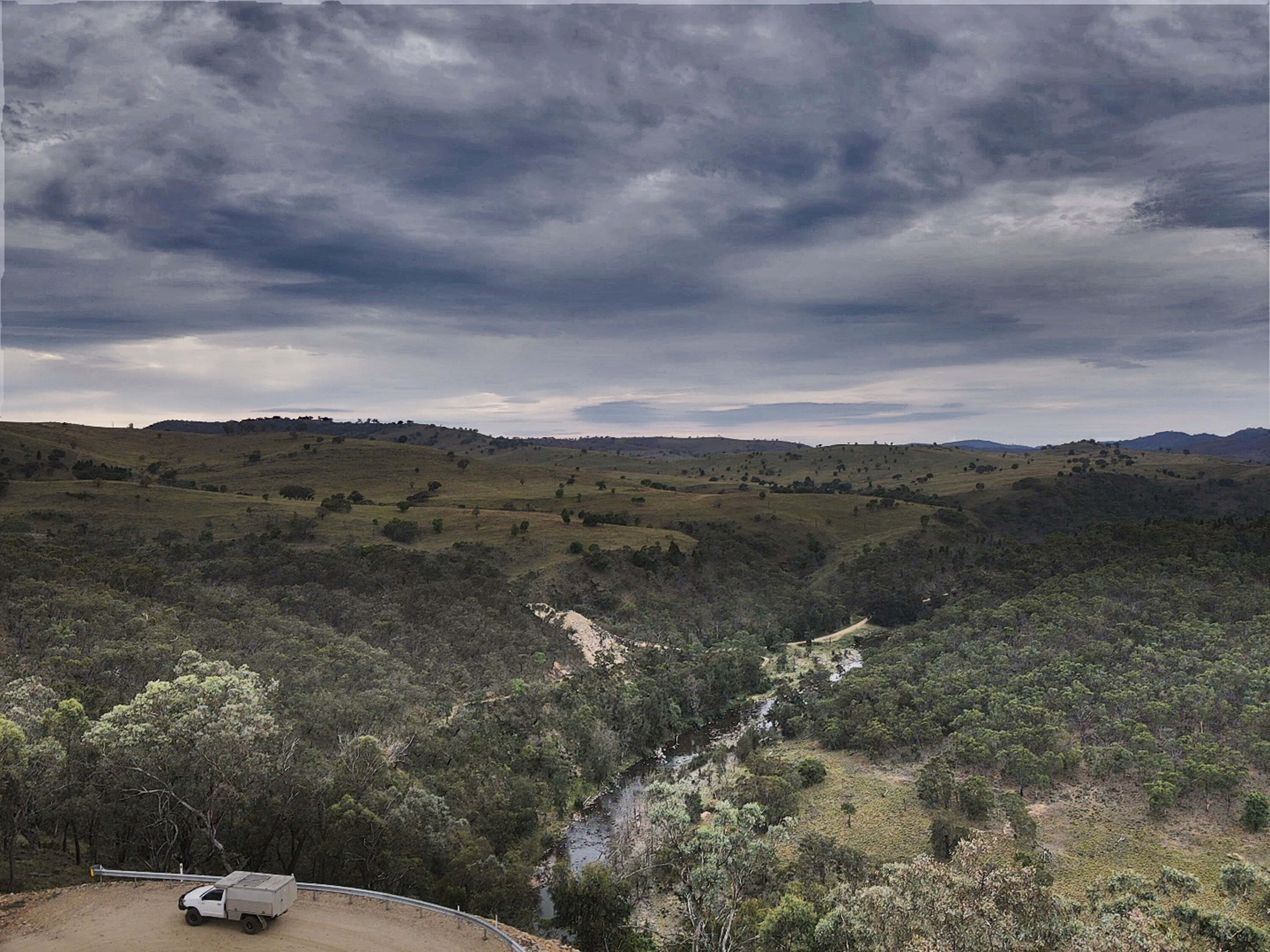
When to go
The track is open year-round and is essentially always accessible (huge mountains falling over the track notwithstanding).
Given that it’s less than half a day’s drive from several major urban centres it understandably gets pretty chockers on the weekends and holidays. Best time to come would be out of school holidays and, if possible, during the week.
With that said, there is really a metric buttload of camping available here, both marked and unmarked, so there’s a better than average chance of you finding a suitable spot.
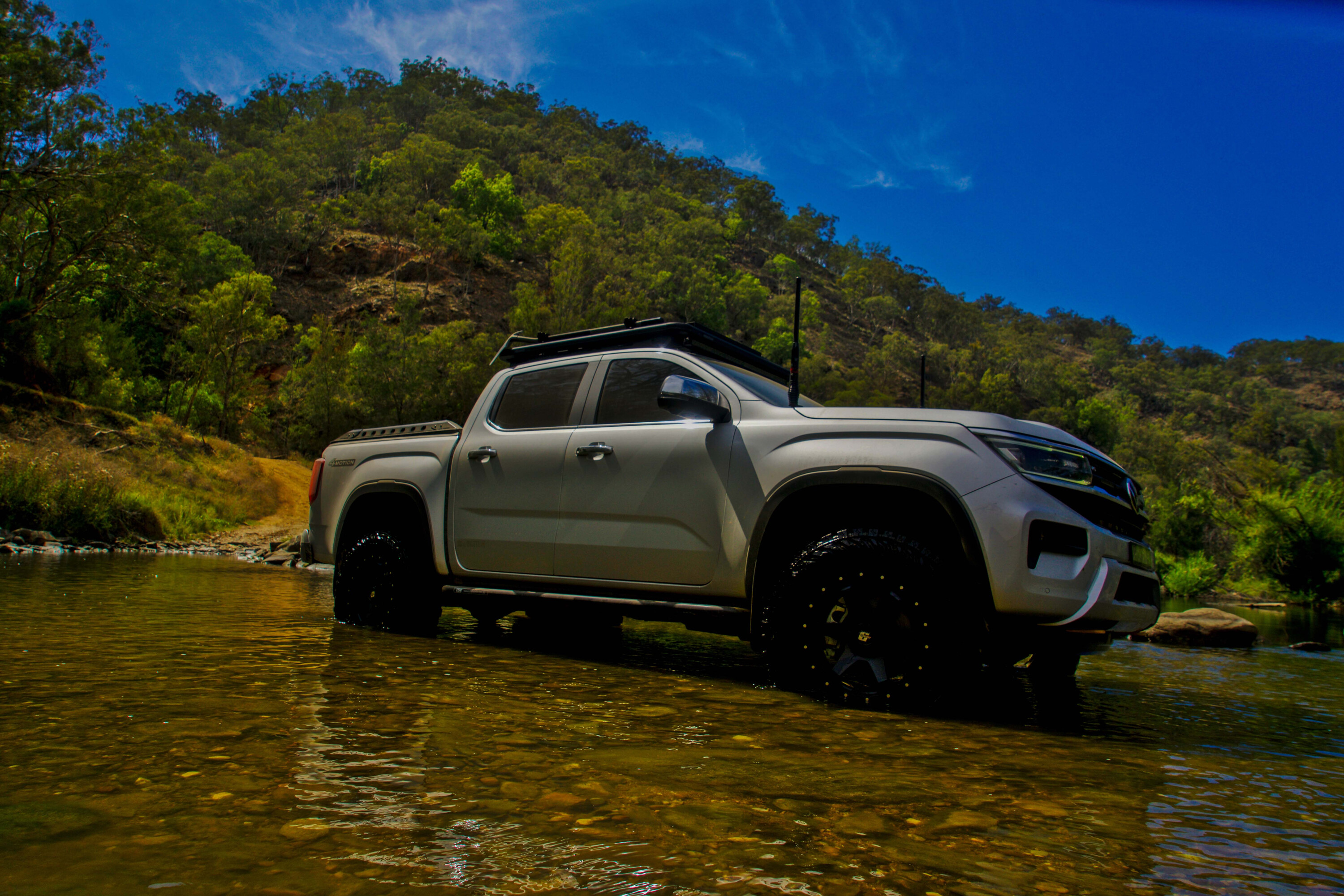
It’s advised that trailers are left at home due to the narrow track, but people do bring their campers (probably a bit too narrow for caravans) and there’s no shortage of spots to set one up.
Also, the Bridle Track is a bit of a rite of passage for 4x4ers. The terrain is nothing short of spectacular.
First you’re tracking along the river bank asking yourself “how’s the serenity?”, nek minute you’ve climbed 100m-plus up the ridge and are all wide-eyed at the topography of the peaks and valley systems of the area. It’s a magical place like that.
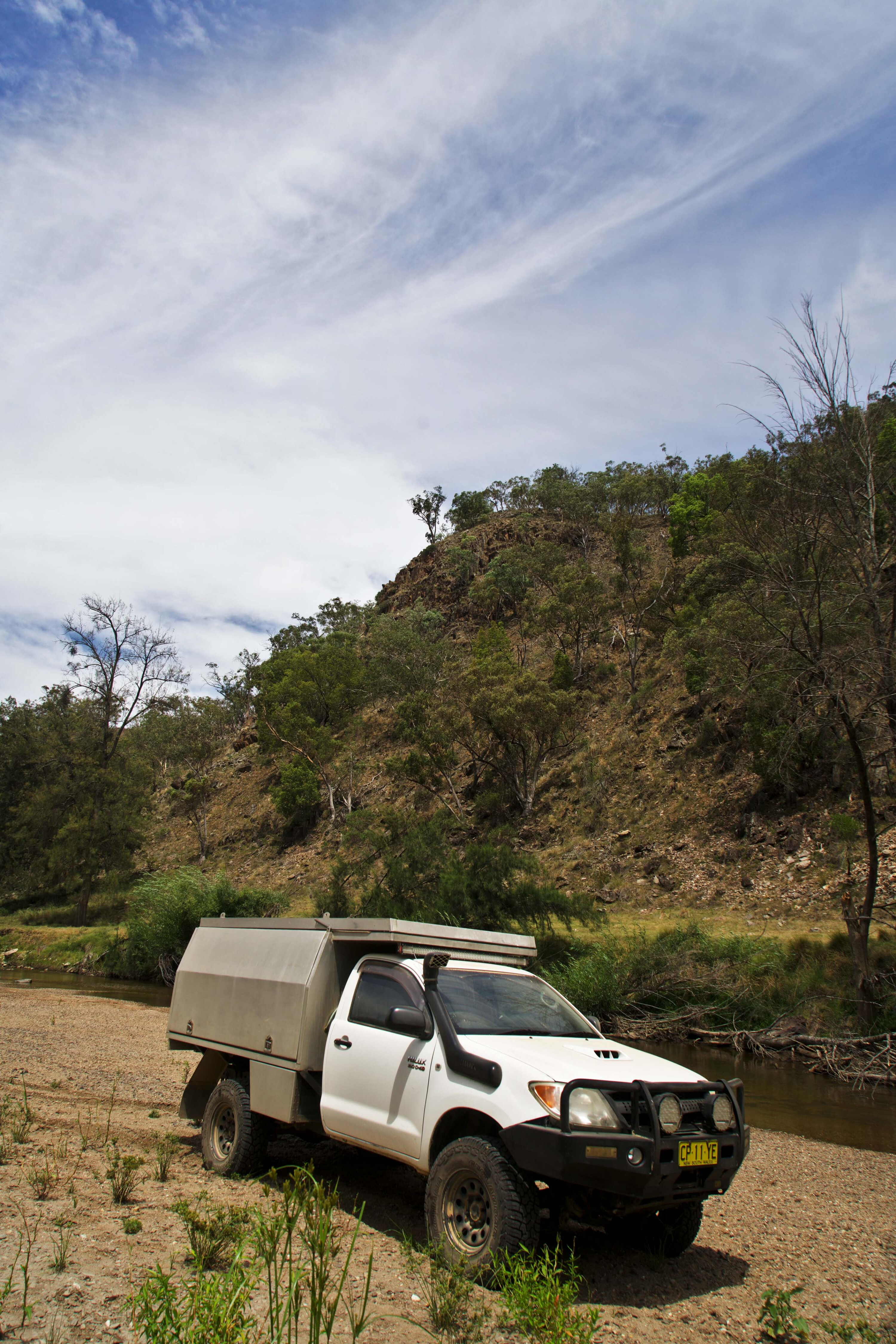
One last thing
Look, selling you on this place is not difficult. Yeah, the off-road driving is not on par with the Cape or the High Country, but that’s not necessarily a bad thing for a lot of folks.
The truth is that this is one of those parts of the world that’s just begging to be explored. There are so many campsites and so many tracks in the region to poke your nose down, and the Bridle Track is just one of them.
In the same area you’ve got the Turon River system, Dixons Long Point, the Coxs River run, Sunny and Dark Corner to name just a few. Fair dinkum, we’ve been driving and camping here for over 20 years and have barely scratched the surface.
If you live in this neck of the world, this is your backyard. Come and find it.
Pro tips
- Drive with your lights on. Blind corners and dust are a bad combo – don’t make it more dangerous than it needs to be, eh?
- The road and track in is full of twisties – aka motorbike heaven, so keep an eye out. Most riders are fairly cautious but we’ve seen more than one travelling at speed into a blind corner.
- Polarised sunnies FTW. Easier to read the track and watch for fish in the river, especially around structure if you’re into flicking lures at trout and the odd redfin.
- It’s not 100 per cent necessary to drop tyre pressures but knocking a few psi out will make the ride a lot less shaky, rattly and rolly (looking at you, fellow leaf spring enthusiasts).
- It gets real warm in summer and real cold in winter. Don’t rock up mid-August in the stubbies and singlet. You’ll have a bad time.
- It’s narrow and two-way. You know what we’re going to say here. Approach corners carefully and scan the track ahead for oncoming vehicles whenever possible.
- The major campsites are signposted and give you an idea of the difficulty of access. If you’re in a high clearance 4×4 you should be sweet (although after heavy rain check water crossings carefully). If you’re in more of a soft-roader, stick to the easier accessed spots (there are plenty of ’em).
- It gets busy on the weekends and holidays. The usual etiquette rules apply. Don’t be the guy shouting to his mates two metres away while pumping the Luke Bryan at 11 and generally exhibiting full throttle “yiew!” behaviour. You’re better than that.
- Hill End pub (aka The Royal Hotel) is a great way to top off your trip with a cold one and a feed.
Last year marked the 75th anniversary of Ford’s iconic F-series trucks as well as the re-introduction of the model to Australian Ford showrooms.
As always for passionate F-truck people, there was a lot to be excited about, particularly with the introduction of the 2023 F-150 Tremor boasting a V8 engine as standard, with the option of going to the 3.5L EcoBoost.
However, for Australians, this beast remains a distant dream, as the Tremor, along with its V8 engine, apparently won’t make their way Down Under.
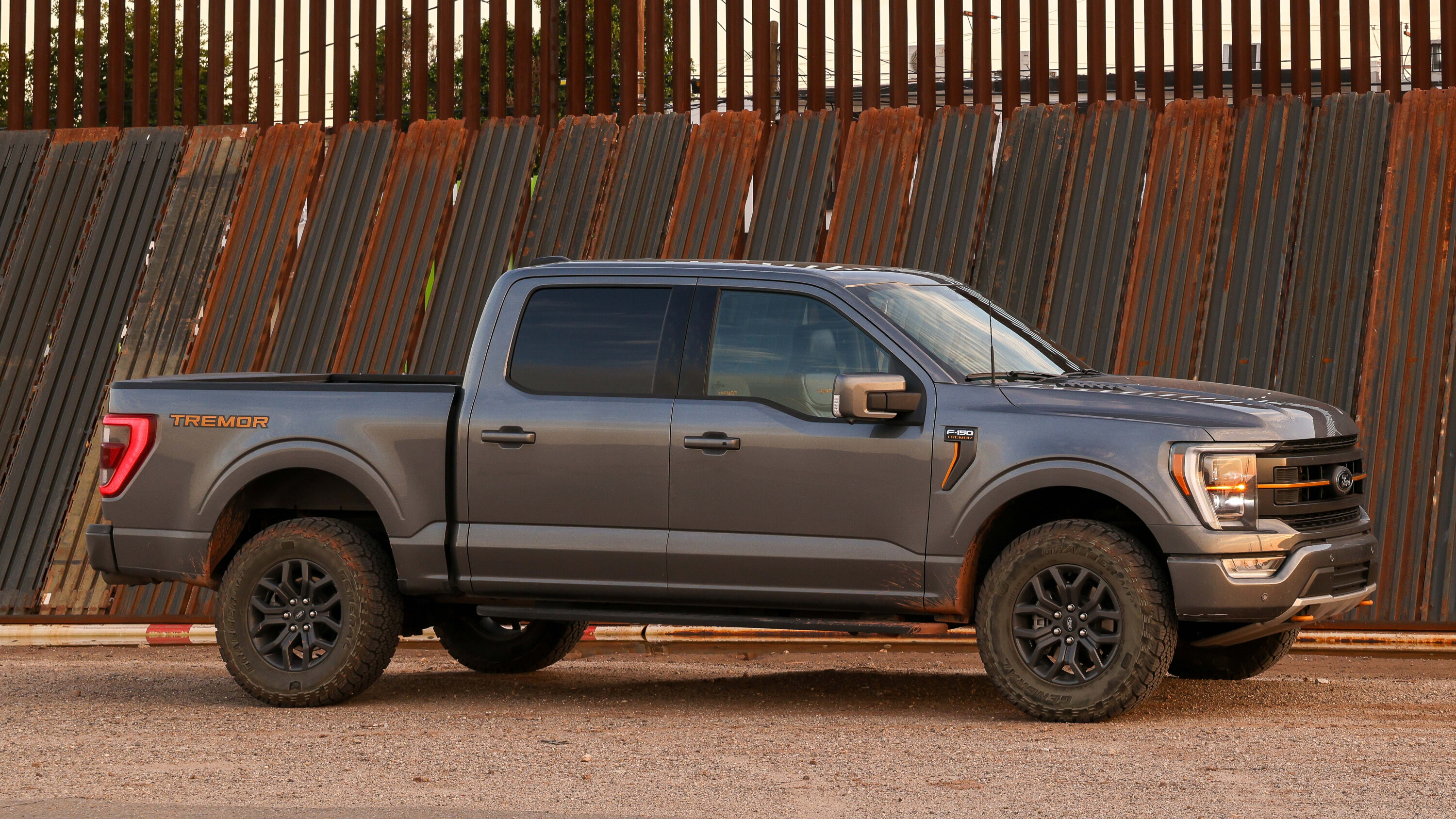
Due to its enormous population, the US market is graced with 8 different variants of the F-150, all with countless options for comfort, styling, drivetrain and aesthetics, plus a grand total of seven different engine options.
The coolest is definitely the High-Output 5.2L Supercharged V8 which comes standard in the F-150 Raptor R, or can be optioned up in the regular Raptor.
Somehow, even though I know the Raptor R would have been loads of fun to drive on my recent US road trip, my bank balance after visits to the petrol pump is much happier having opted for the 5.0L Coyote-powered Tremor.
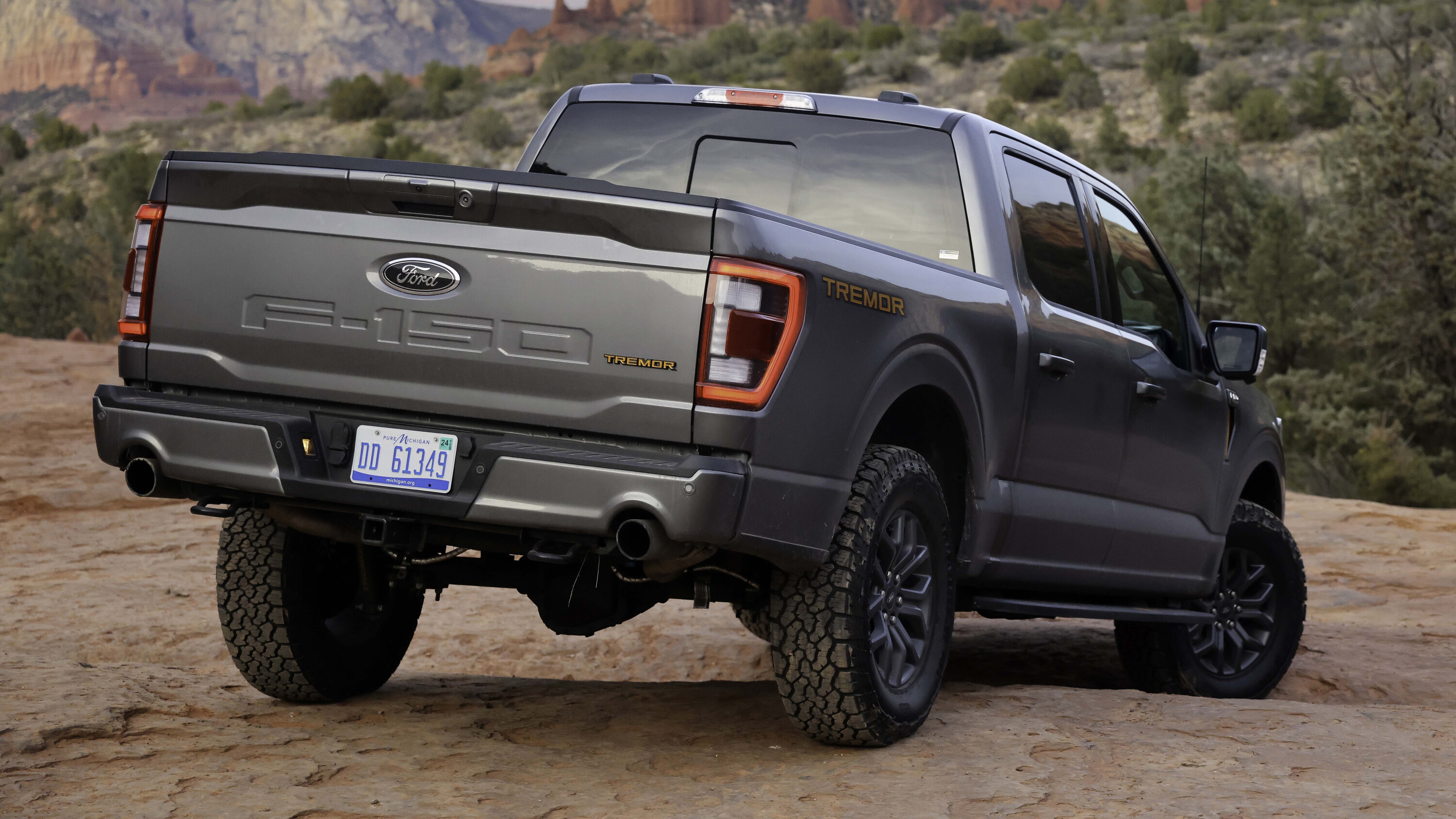
What is it?
Some call the F-150 Tremor the ‘Baby Raptor’ and you’d be forgiven if you hadn’t noticed that it’d moved in on the FX4 model, which has disappeared from the current F-150 line-up in the USA.
Before you option it up, the Tremor starts at US$61,330, which means it’s still more than the XLT and Lariat (models sold here in Australia), but a few grand cheaper than the King Ranch and Platinum luxury-style trucks.
Surprisingly though, the base Raptor is only around US$15,000 dearer, so if you had the choice and the funds you’d probably go for a Raptor. Above that is the luxury Limited model.
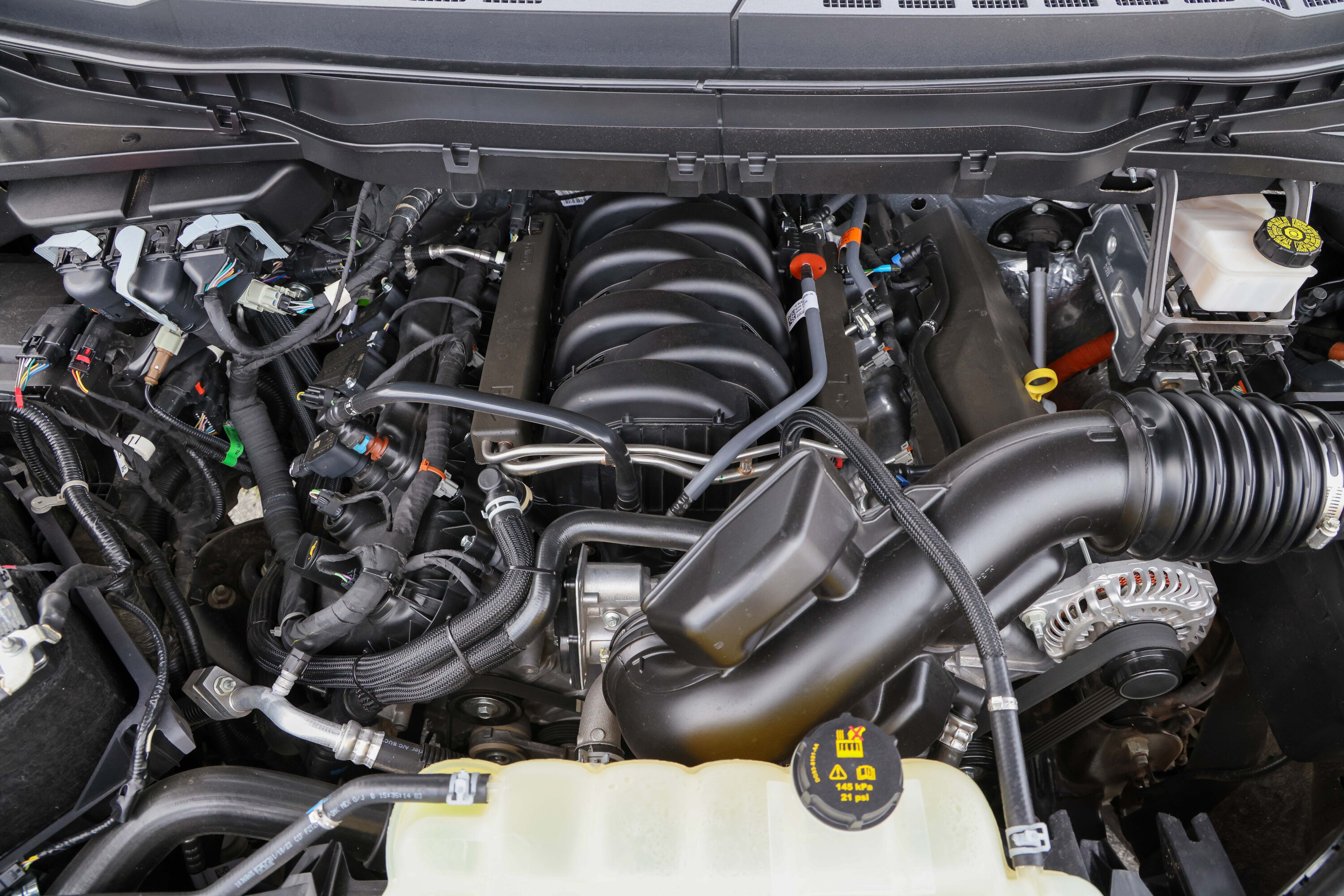
What sets the Tremor apart from the other road going F-150s is its off-road package and subtle Raptor-esque styling.
Mechanically, the Tremor comes standard with a rear locking diff which is also available in the Raptor, but unlike the Raptor and every other model, the Tremor has a robust 9.75-inch rear axle. It also comes as standard with the fancier electronic 10-speed transmission as opposed to the unique Hybrid HEV 10-speed transmission that is standard in the lower models.
What does this mean? Well from the point of view of driving the car, it’s extremely smooth and effortless, and it also gives you all of the driving modes that the Raptor comes with, except instead of Baja, it has Deep Snow/Sand.
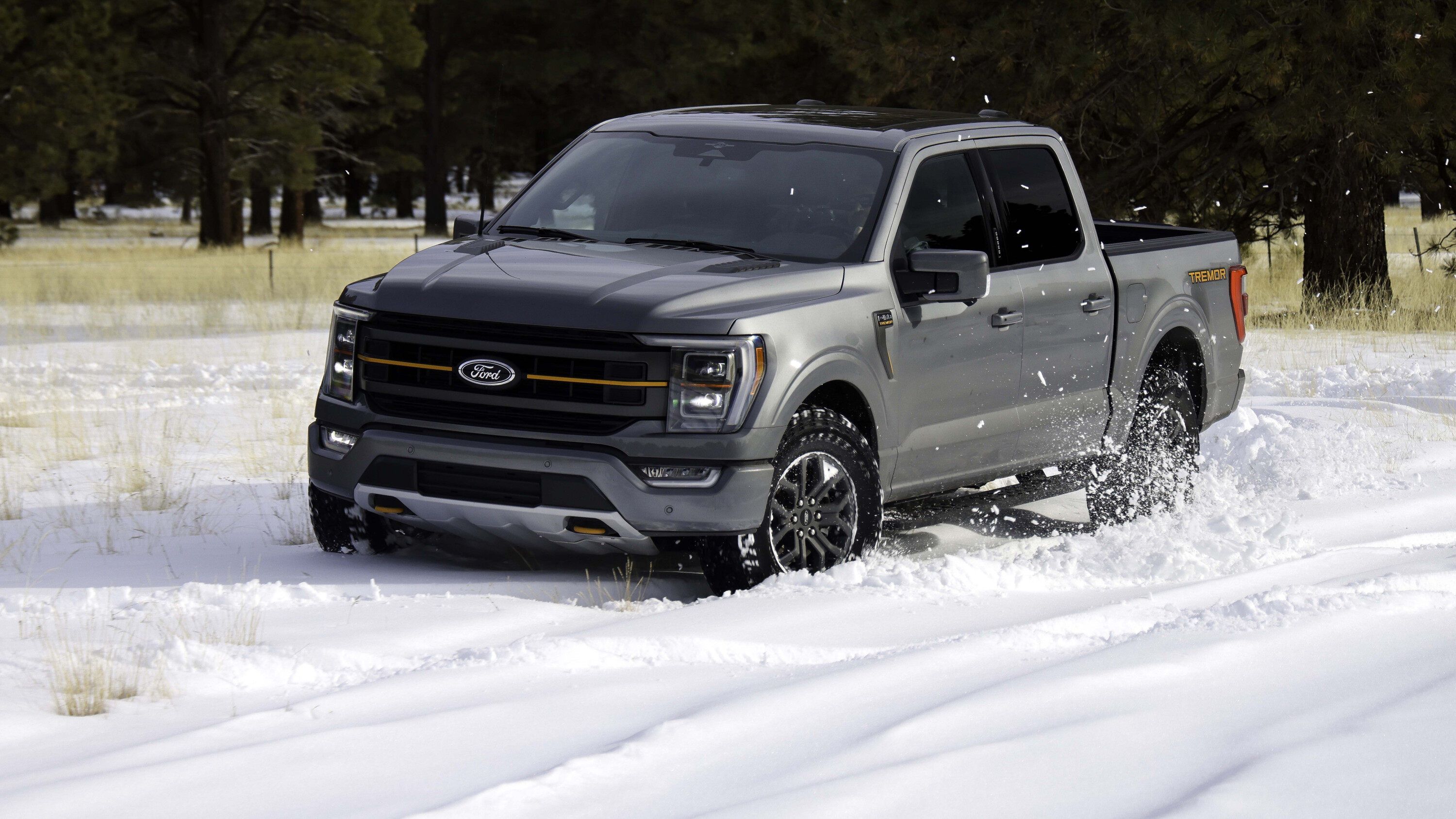
4×4 system
Funnily enough I was lucky to find snow as we headed south from Nevada into Flagstaff Arizona.
I was a tad nervous at first as I dipped the front wheels into it, but the Tremor ate it up and I actually ended up having a bit of fun in the white stuff. The standard transfer case behind the transmission is a part-time 4×4 system with high and low range (2H, 4H and 4L), but the vehicle I was driving was equipped with the optional two-speed Hi-Lock transfer case, which essentially adds a 4A mode added on-road traction (2H, 4A, 4H and 4L).
I tackled some rocky trails in Rock Crawl mode and found the Tremor to be extremely capable at getting up some reasonably tricky tracks.
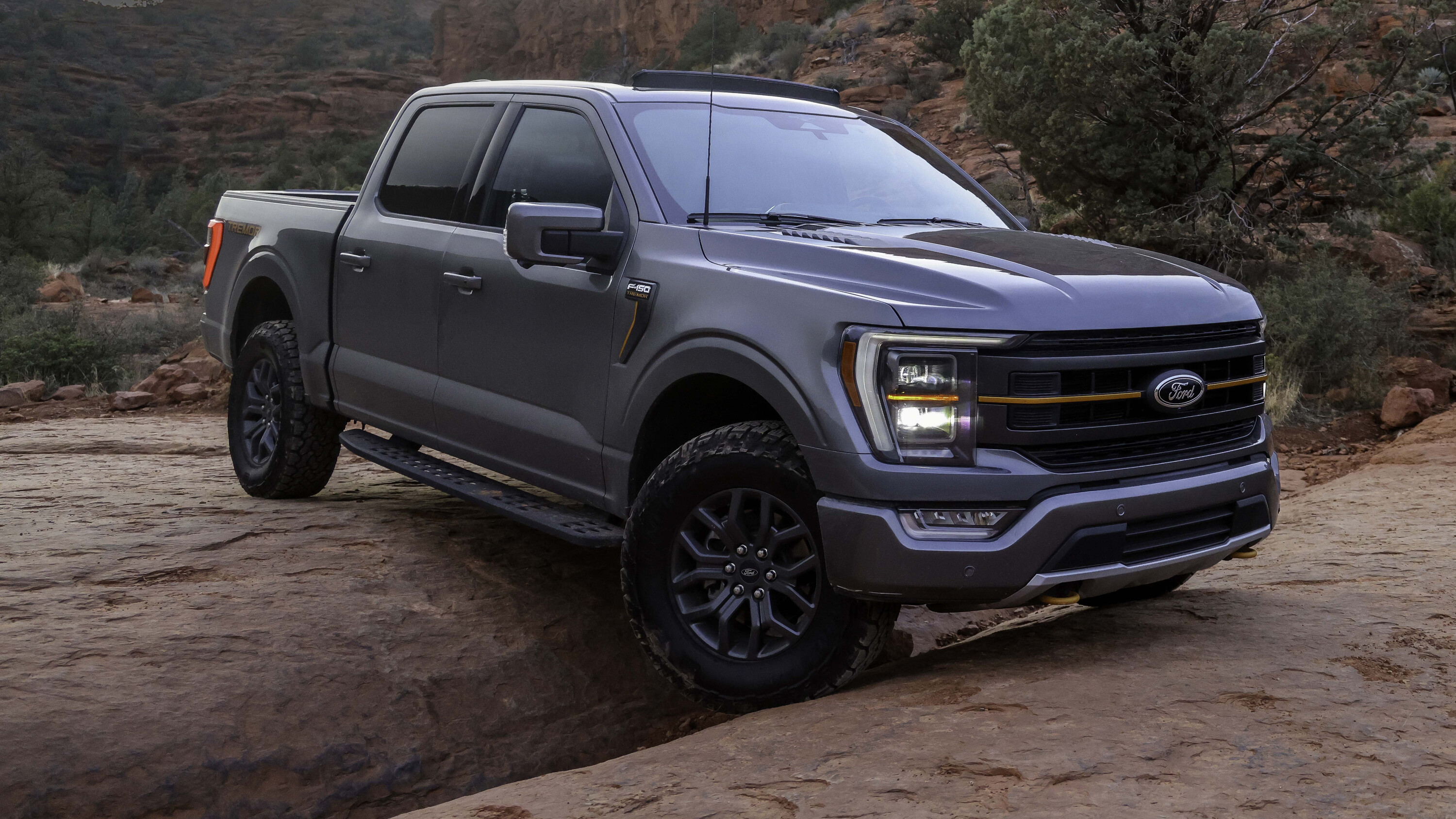
The Tremor is also equipped with additional bash plates and rugged side steps that make it suitable and capable in standard form for getting away on the weekends.
The area we’d stumbled upon turned out to be a well known 4X4 stomping ground in Sedona known as Broken Arrow, and if you’re ever in that area, I highly recommend it.
On a couple of occasions I used the Slippery Mode on some icy roads in Arizona, and when driving through torrential rain in San Diego. Each time it was very stable and gave me a great deal of confidence in the vehicle.
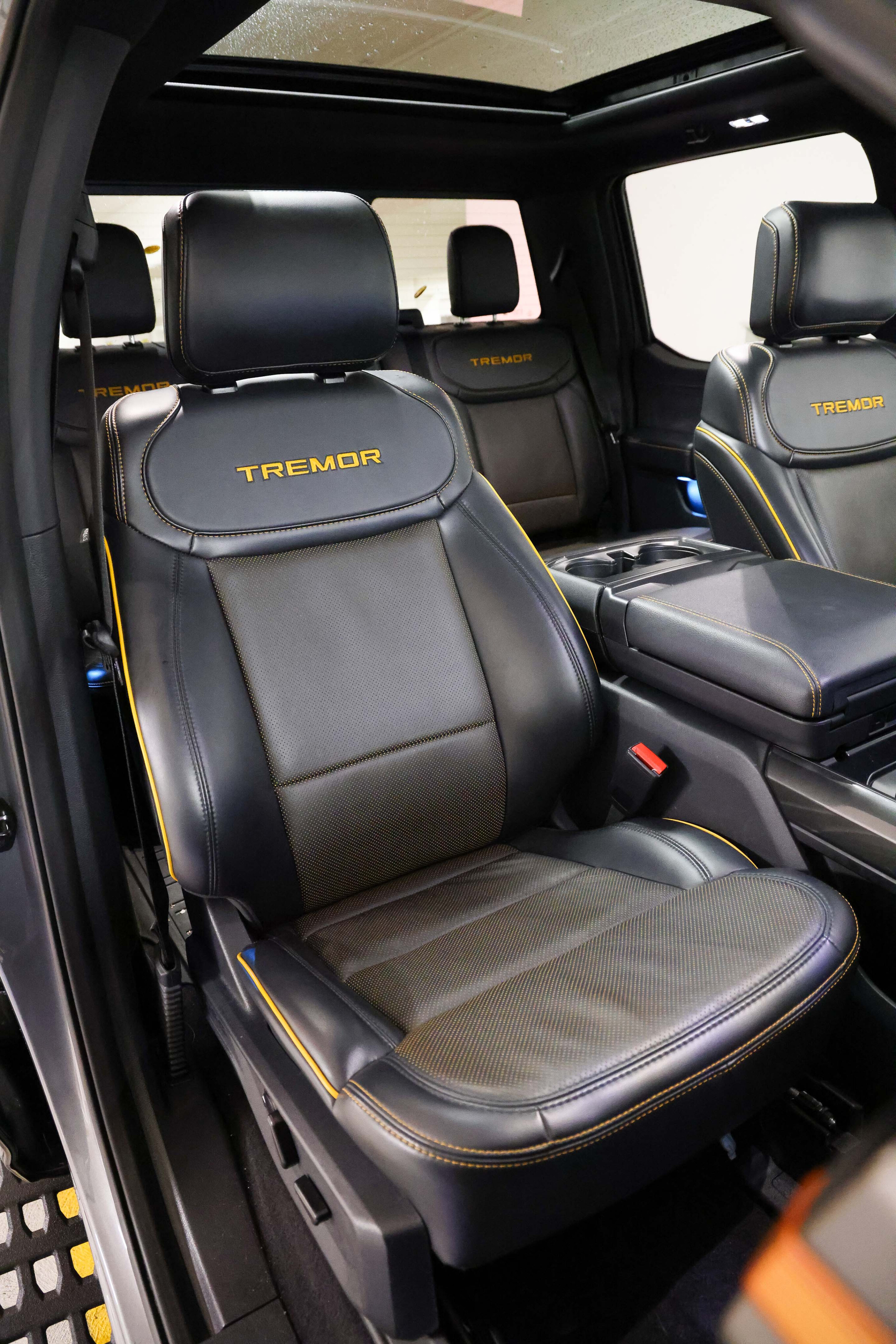
This was also the case when we hit some dirt roads east of Phoenix where I decided to have a bit of play and went for Sport mode.
To be honest, I thought it would be a bit more out of control, but the Tremor, with its unique-to-this-model off-road suspension package, felt planted and confidence inspiring.
Unlike the road-going models it comes standard with 18-inch alloy wheels wrapped in 33-inch (275/70R18) General Grabber All Terrain tyres.
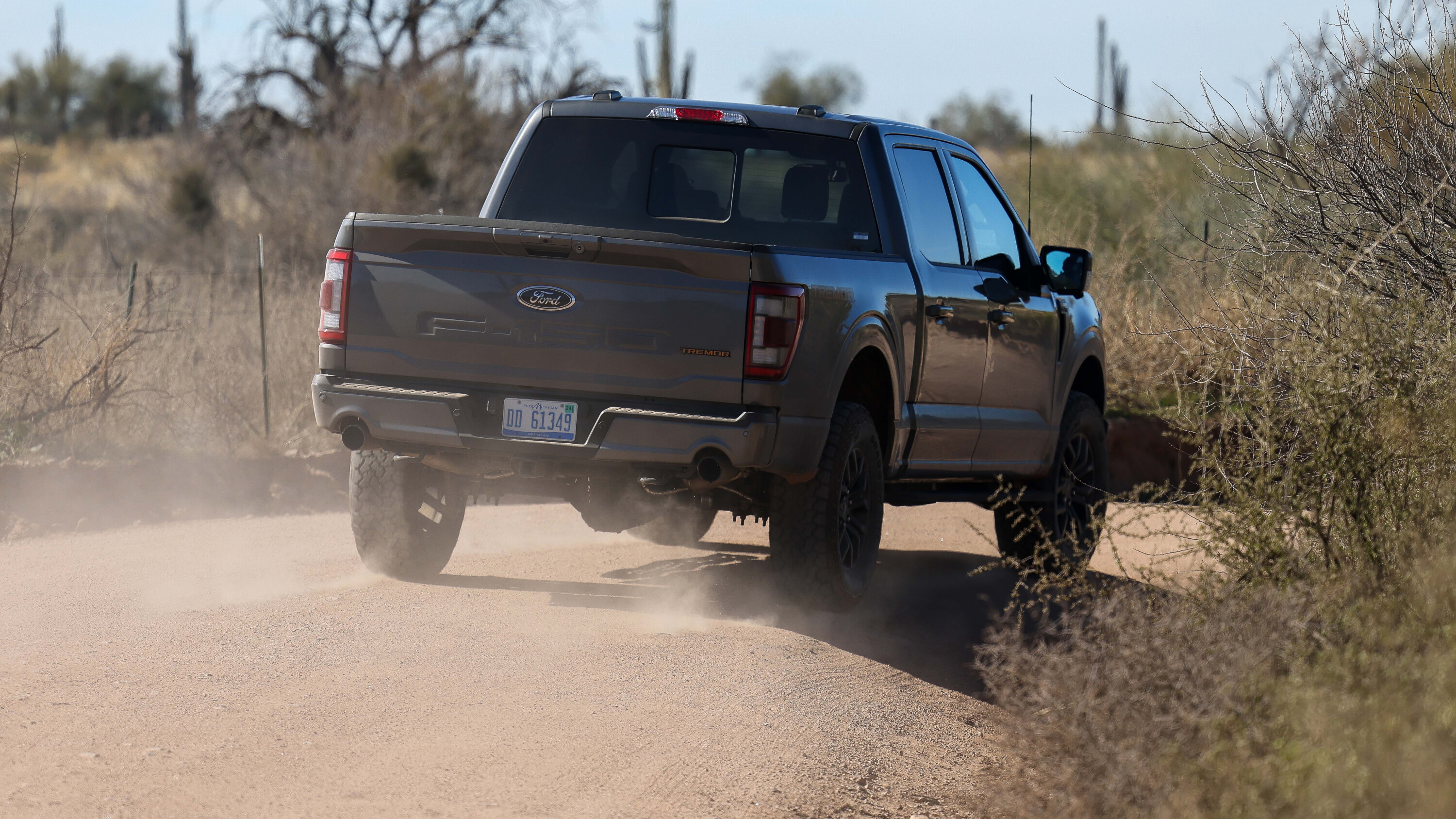
A smooth ride
With regards to the road trip itself, I’d be lying if I said I didn’t have the Tremor in Eco mode a lot of the time.
It’s quiet, smooth, way more efficient and is only a twist of the driving-modes knob away from Normal and Sport modes. That, in addition to the commonly found active cruise control and lane-departure assist, makes for a very comfortable and safe ride.
The interior is unique to this model and features the Tremor logo in multiple places around the cabin including the heated and air conditioned seats.
Like other models, however, the Tremor has a fold-out workstation and stowable shifter, not to mention an absolutely brilliant infotainment system with a whopping 15.5-inch screen and the option to upgrade to a B&O audio system.
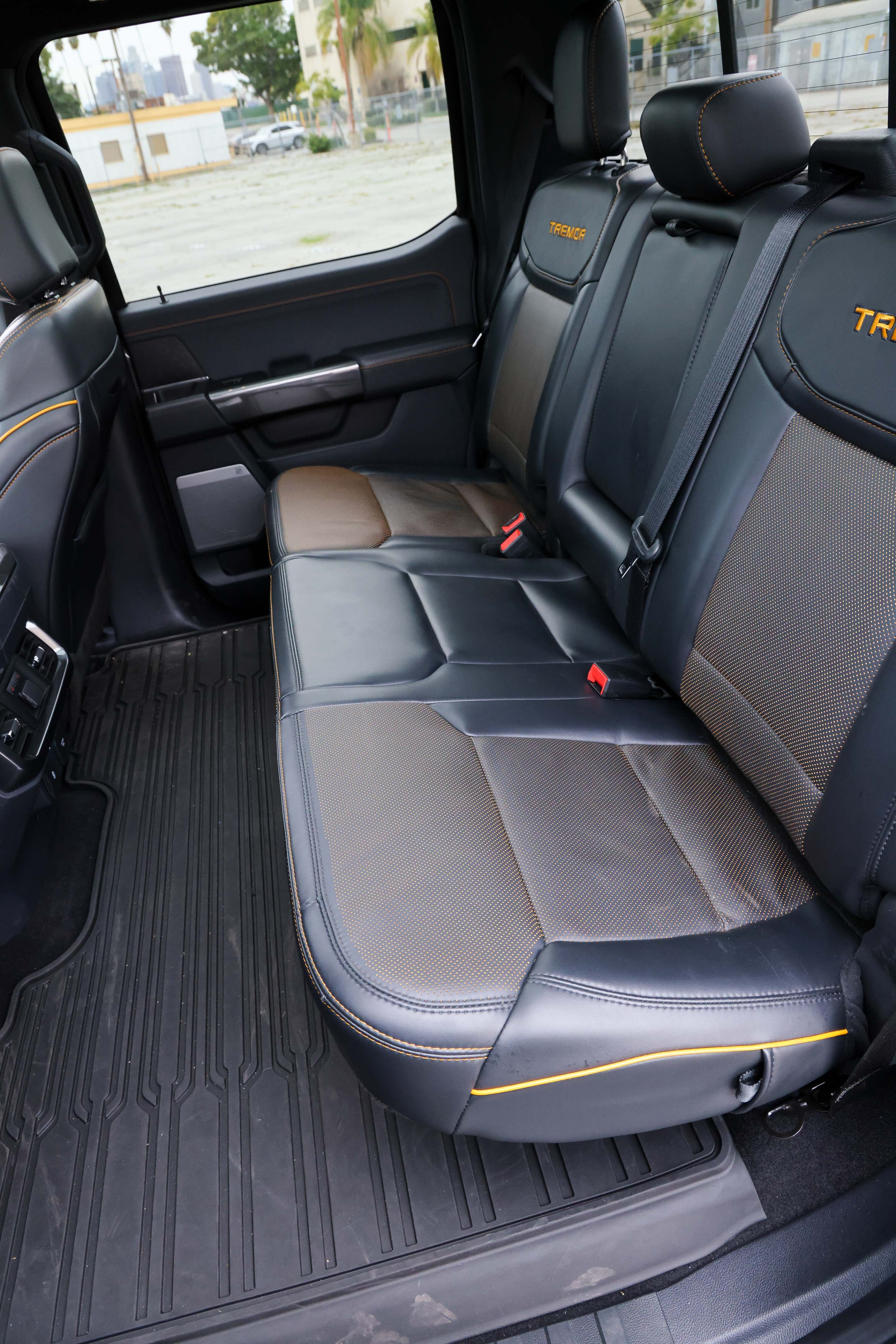
In the rear, there’s loads of legroom and passenger power outlet options, and the seat can be stowed when not in use, transforming the rear of the cabin into a large luggage space.
On the outside, while it doesn’t look as rugged and beefy as the Raptor, the Tremor still scores a unique look thanks to its grille, bonnet vents, side vents and decals, not to mention the big chunky side steps.
On more than a few occasions during our road trip, people commented along the lines of ‘Oh cool, that’s the Tremor package’, so Ford obviously did something right when it released this low-carb Raptor.
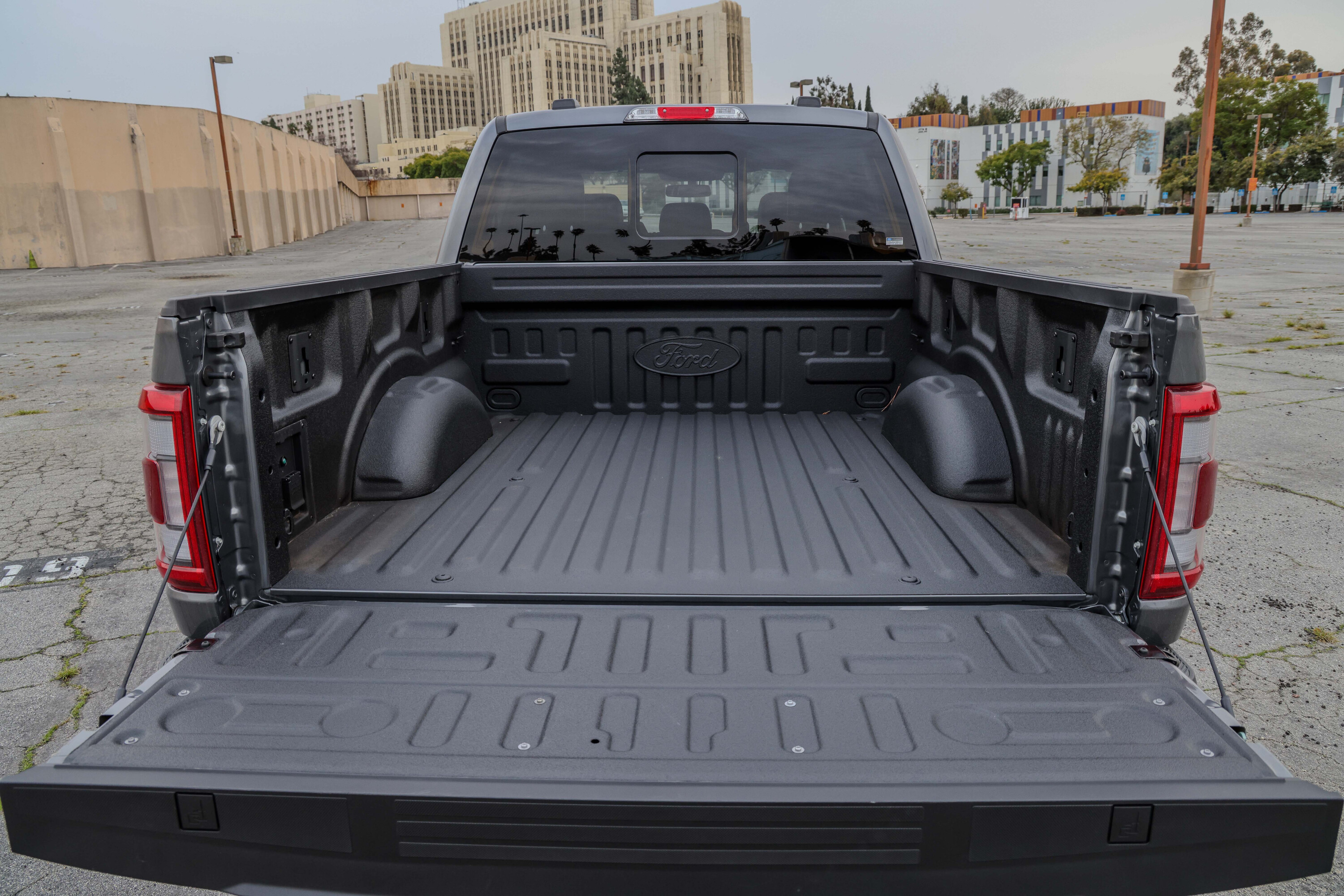
Aftershock
After doing more than 2000 miles (3200km) across three states in the F-150 Tremor, as we meandered back to the urban sprawl of Los Angeles to return it, a tinge of melancholy set in, knowing that this experience is one that, for now, remains beyond the reach of Aussie shores.
Ford’s commemoration of the F-Series truck’s 75th-year with the F-150 Tremor is a testament to the enduring legacy and continuous evolution of the Effie. Having built millions of these iconic vehicles to date, the F-150 Tremor adds a new layer to this rich tapestry, combining an iconic V8 engine with the finesse provided by modern engineering.
Yet despite the fact that neither the Tremor nor the V8 engine option is destined for the Australian market, the allure of this American marvel is undeniable.
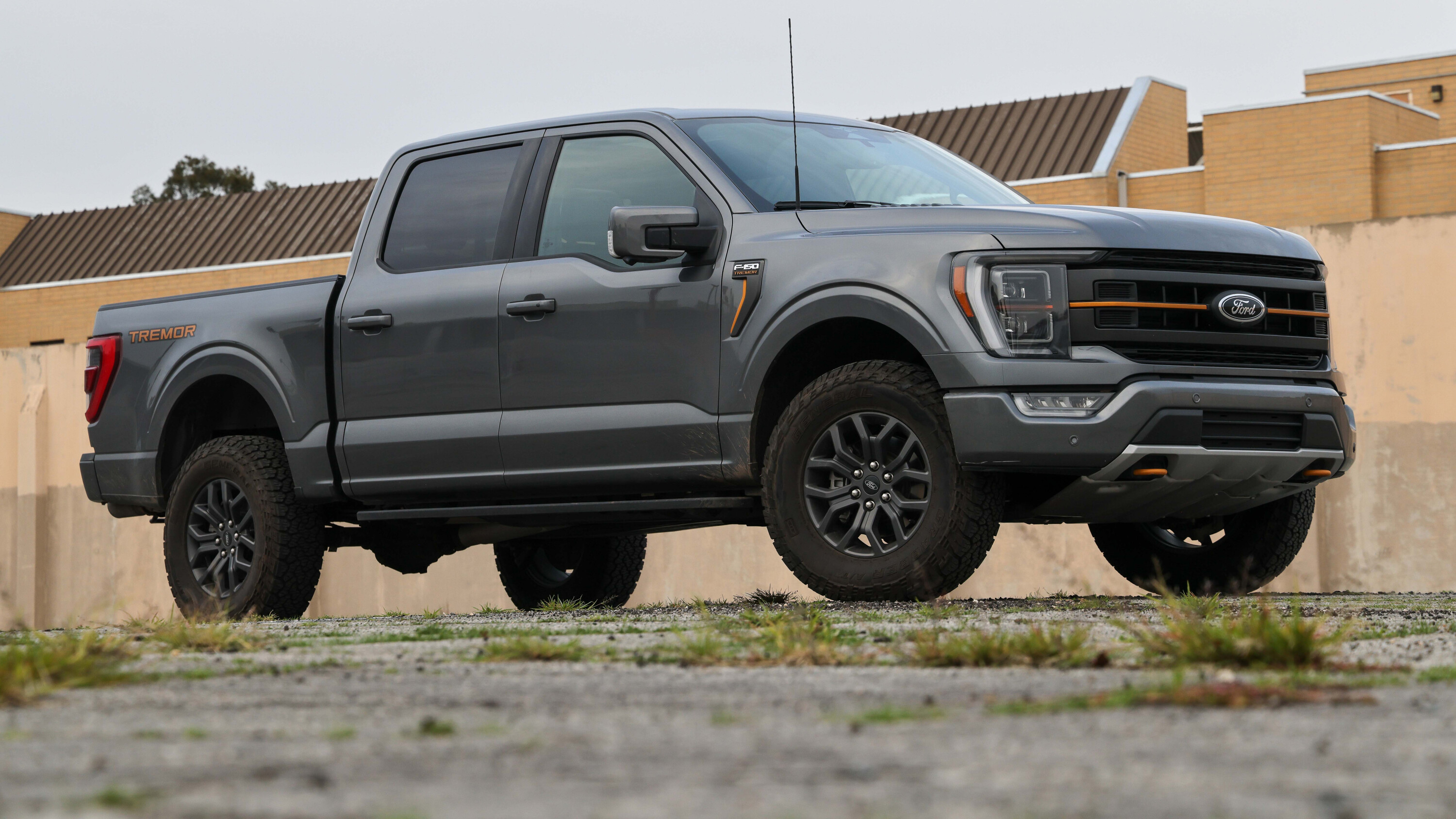
While only two models of the F-series have made their way to our shores through Ford, tales of people traversing the vast expanses of the American landscape in a vehicle as commanding as the F-150 Tremor are bound to ignite the wanderlust in us all.
As we mark another chapter in the history of the F-series, the 2023 Ford F-150 Tremor stands as a celebration of all that has come before and a tantalising glimpse of what the future holds… even if it’s one that we can only admire from afar.
The journey across Southern California, Las Vegas, Arizona and San Diego in the F-150 Tremor was more than just a road trip; it was an odyssey and a chance for two good mates to hit the road together, in the perfect rig for the trip.
Given that Ford has barely dipped its toes in the water here in Australia bringing in the EcoBoost XLT and Lariat models, there might still be a chance for the Tremor to see our shores… or maybe even the F-150 Raptor given the popularity of the Ranger version. Only popularity, sales and time will tell.
| 2023 Ford F-150 Tremor key features | |
|---|---|
| 33-inch all-terrain tyres | Integrated trailer brake controller |
| Two-speed four-wheel-drive system with neutral towing capability | Trailer Sway Control |
| Off-road shocks | Selectable Drive Modes (Normal, ECO, Sport, Tow/Haul, Slippery, Deep Snow/Sand, Mud/Rut, Rock Crawl) |
| Electronic-locking rear differential | Unique dual-exhaust outlet |
| Unique Tremor control arms | 4.10 front axle (opt) |
| Unique Tremor front knuckles | Hi-Lock transfer case (opt) |
| 9.75-inch gearset | Trail Control with Trail One-Pedal Drive and Trail Turn Assist (opt) |
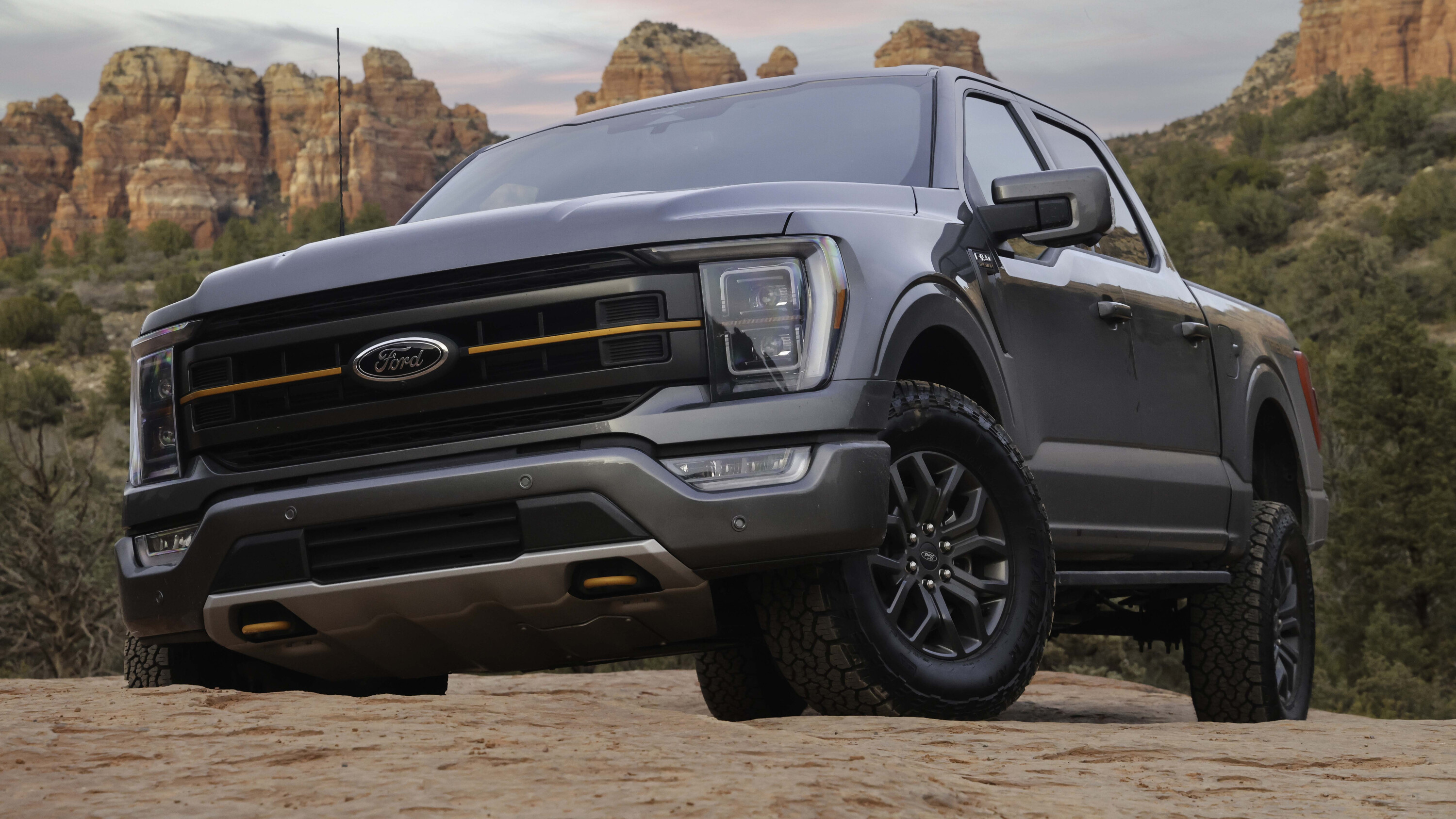
| 2023 Ford F-150 Tremor | |
|---|---|
| Price | From US$63,950 |
| Engine | V8 petrol |
| Capacity | 4942cc |
| Max power | 298kW at 6000 rpm |
| Max torque | 558Nm at 3000 rpm |
| Transmission | 10-speed autmatic |
| Transfer case | Selectable full-time 4×4 w/ low-range |
| Crawl ratio | NA |
| Construction | 4-door ute on a separate chassis |
| Front suspension | IFS, double wishbone w/ coil springs |
| Rear suspension | Live axle w/ leaf springs |
| Tyres | 275/70R18 General Grabber A/T |
| Kerb weight | 2323kg |
| GVM | 3276kg |
| GCM | 7121kg |
| Payload | 953kg |
| Towing capacity | 4500kg |
| Seats | 6 |
| Fuel tank capacity | 136L (extended range) |
| Claimed fuel consumption | 13.8L/100km combined |
| On-test fuel consumption | NA |
The team at Lightforce has been at it again, raising the bar for vehicle auxiliary lighting.
The newest product from the South Australian lighting manufacturer is the Beast, a 222mm round-ish driving light that uses 36 Osram LEDs to offer a light with multiple modes of beam to suit the conditions you are driving in.
Rather than having a specific lamp with a flood beam and another one for spot, the Beast allows you to select modes for each via a simple press of the dash button. Alternatively, hold the button in for a few seconds to engage Beast Mode which gives you both at once for maximum reach and spread of light.
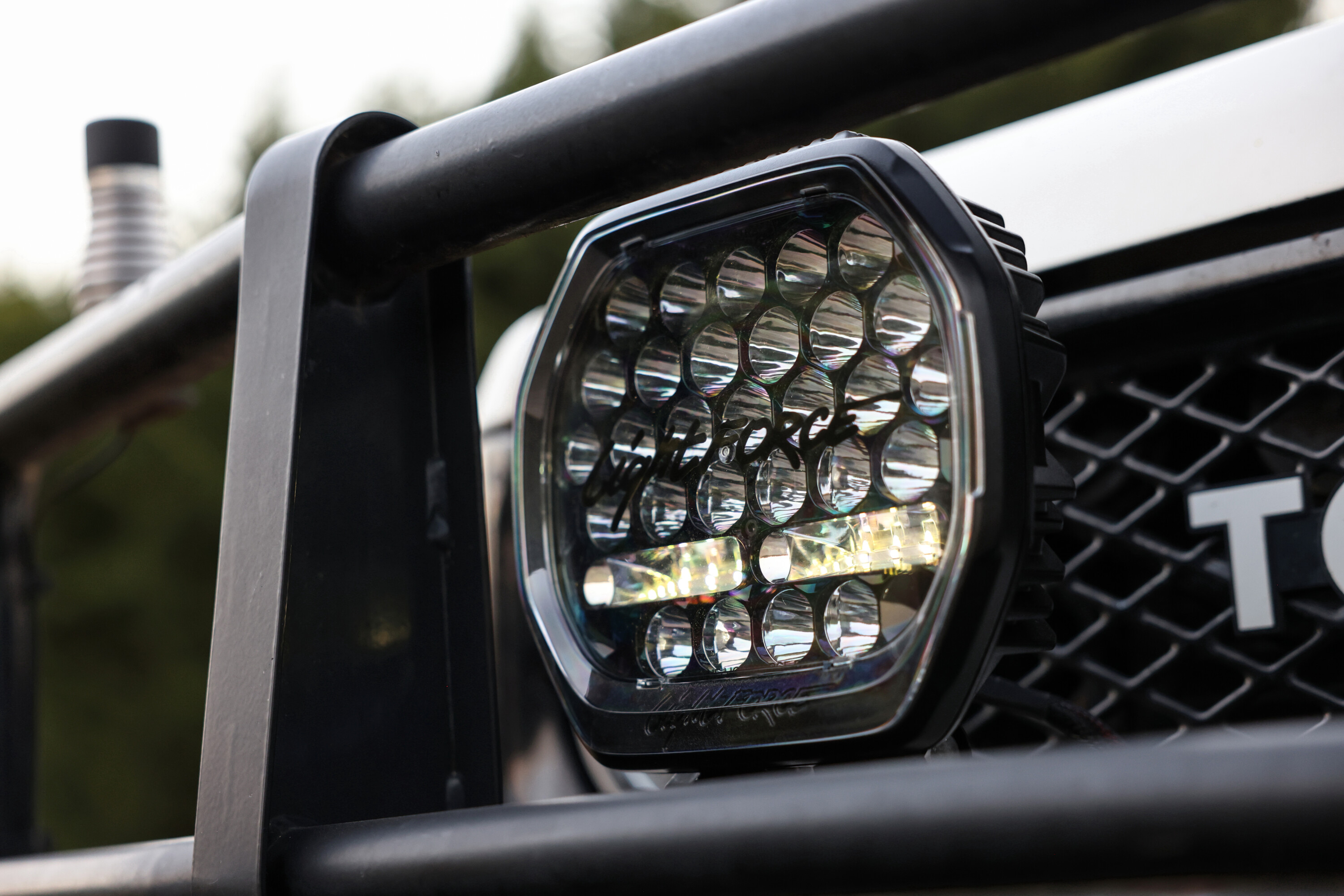
While the ability to offer multiple beam outputs from a single LED light is not new to the auxiliary lighting market, it’s new to Lightforce, and in this product it comes with the brand’s Australian-made solid design and construction. In fact, the team came up with a whole new light to implement the multi-beam feature.
The Beast features a lightweight diecast aluminium housing for optimal strength and heat dissipation, while the 36 LEDs sit in front of a black reflector for a unique look in the almost octagonal housing.
The lights are rated IP69K for dust and water ingress and use a Gore membrane on the breather, and Lightforce claims the Beast driving lights will operate at a depth of 1.5m under water for an hour without leaking; will run continuously between -40°C and 85°C; can survive temperature spikes up to 125°C; and will handle a 400g rock strike on the lens at 100km/h or a 1kg rock strike at 60km/h.
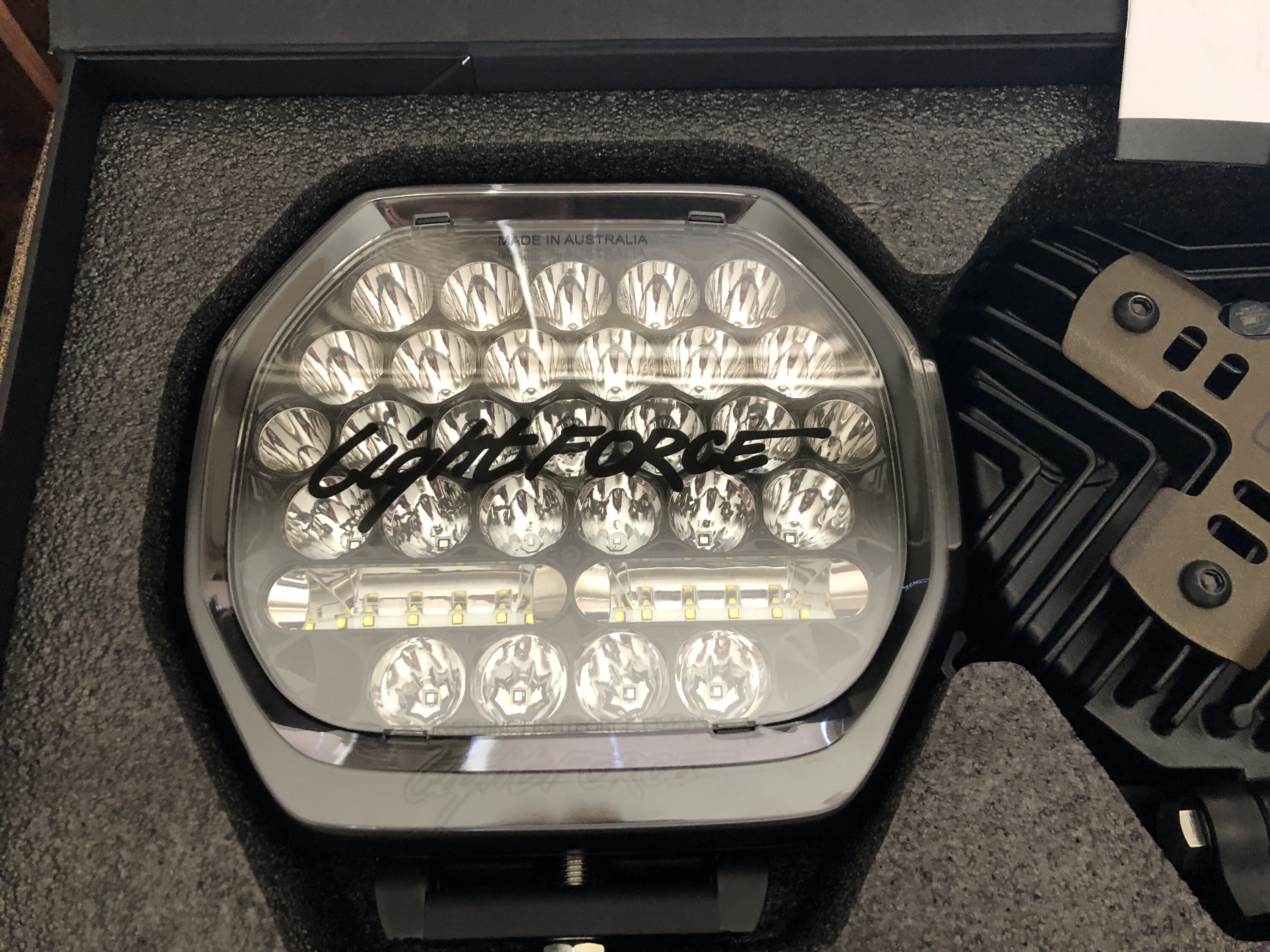
The lights are made to US Military standard MIL-STD-810H 514.4 for vibration and shock, and claimed to resist seven days of the IEC 60068-2-52 salt spray with no rust or damage to the coating, so they should be able to cope with the rigours of sitting up the front of your 4×4 for many years. Lightforce is confident enough in the Beast to offer a five-year warranty.
The wiring harness that’s supplied in two-light kits contains everything required for fitment and use of the Beast lights and the harness is easy to understand and install, featuring high quality plugs and components. Only a single wire needs to run through to the dash for the switch which is supplied with the harness.
The depth of the lights has been kept to a minimum to allow fitment between the grille and bull bar of most 4×4 vehicles. The solid mounting brackets are reversible for more mounting options, and anti-theft mounting bolts are available as an option.
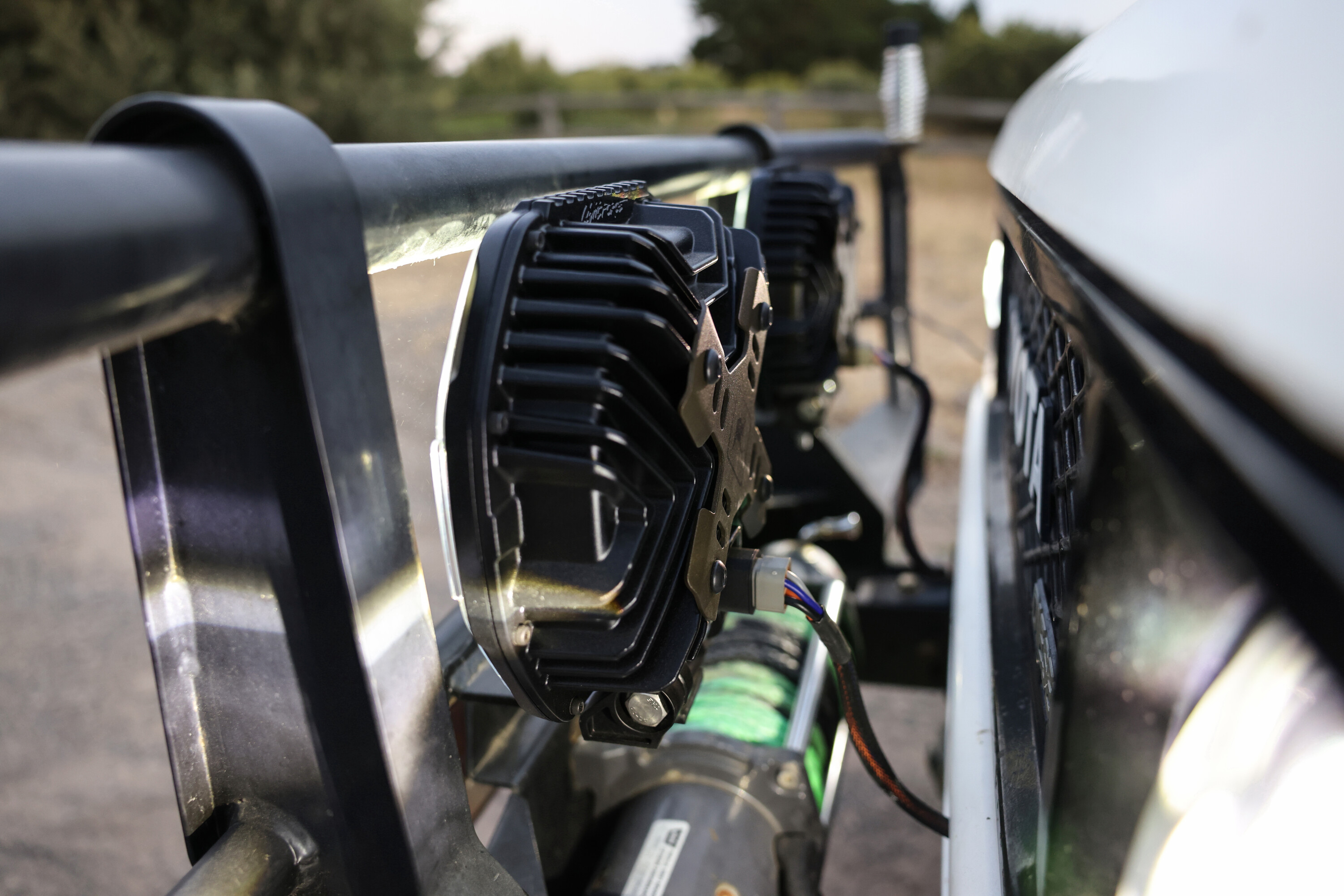
Modes
The Beast lights have four modes in total including the daytime running light (DRL) function which is designed to illuminate as soon as the ignition is switched on.
With the vehicle’s high beam on, a single tap of a dash button activates the long-range spot mode of the driving lights, punching out a claimed 1 LUX at 1497m with a beam width of 60m.
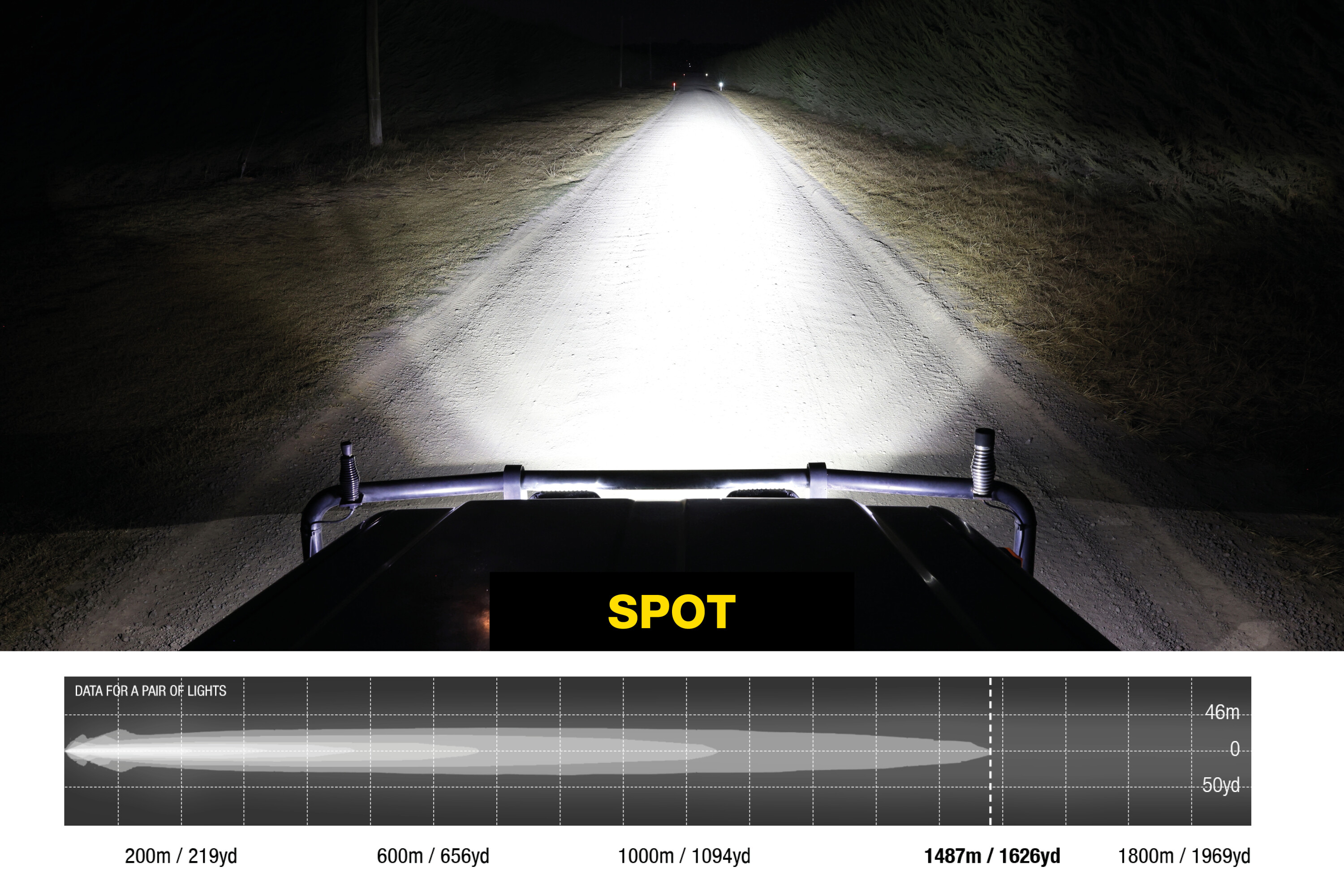
A second press of the button engaged flood or wide beam, projecting a claimed 1 LUX at 778m with a 140m beam width.
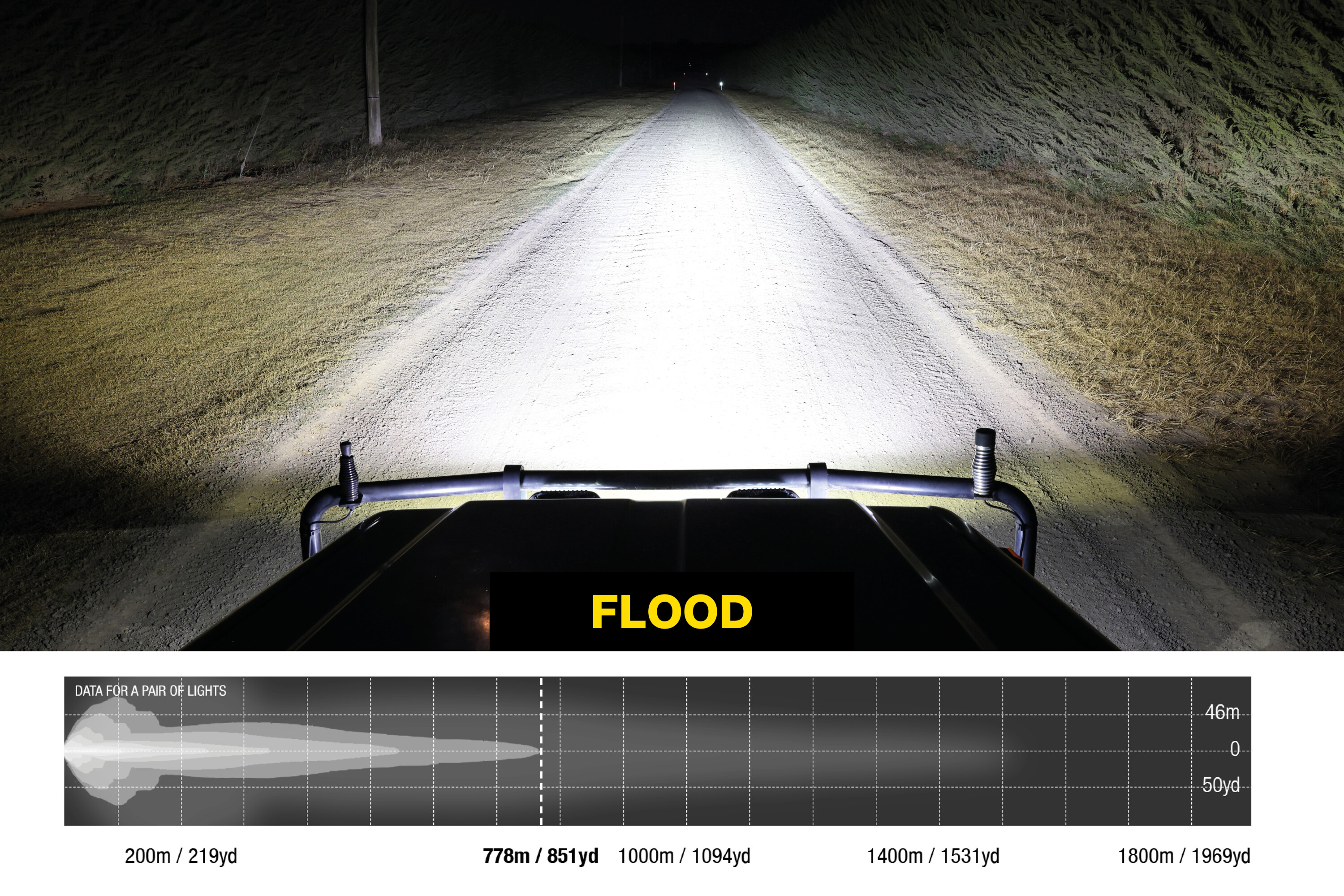
Holding down the button for a few seconds initiates Beast mode, resulting in a claimed 1 LUX at 1375m with a wide 140m beam width.
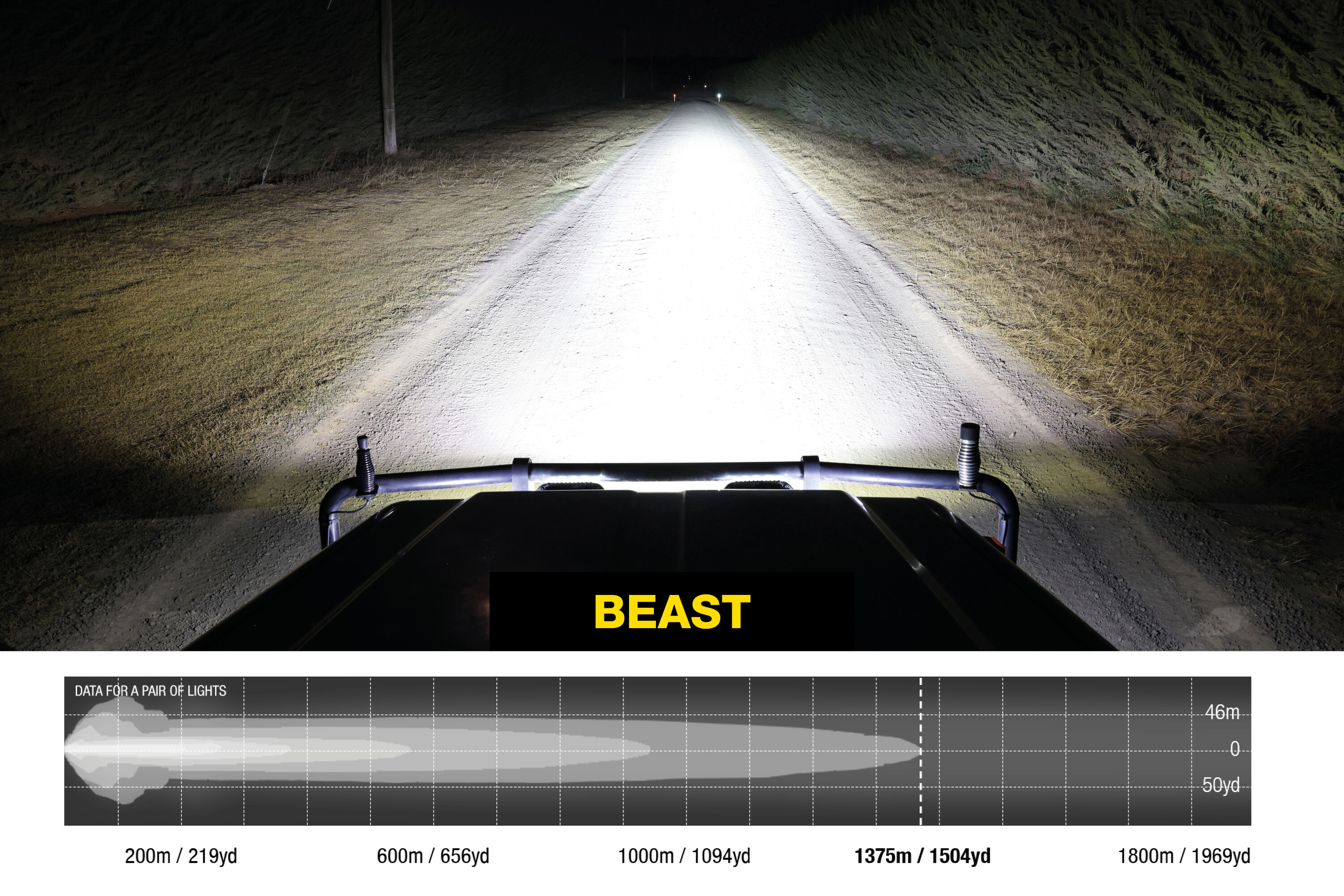
On the bushy Victorian tracks we’ve been driving lately in the LandCruiser, the flood mode has proved most suitable, while the long-range spot beam will no doubt come into its own out in wide-open spaces.
Verdict
These are the best driving lights I’ve had on the Cruiser since the original HTX lights from Lightforce, which combined older HID technology with LEDs. The improvements in LED technology and reflector design have made HID components redundant, and the Lightforce Beast offers even better lighting performance, all in a tough Australian made package.
The Beast is available in a single-lamp or two-lamp kit with harness. There’s a range of accessories available including black, tinted and clear filters/covers, and the aforementioned anti-theft lock nuts.
Australian-made quality doesn’t come cheap, but at $599.50 for a single Beast lamp or $1349 for the two-lamp kit, covers, harness and instructions that make installation simple, they are comparable to other products in terms of cost.
RRP
- One lamp: $599.50
- Two-lamp kit: $1349
From charging multiple power-tool batteries to cooking up toasted sandwiches and brewing coffees at smoko, Projecta has us covered for our power needs in our Triton tradie ute.
The importance of a reliable power source in a work ute can’t be overstated. Enter the Projecta 12V DC Power Management Board with 2000W Inverter, a comprehensive solution designed for work-related tasks and weekend activities that demand a dependable power supply.
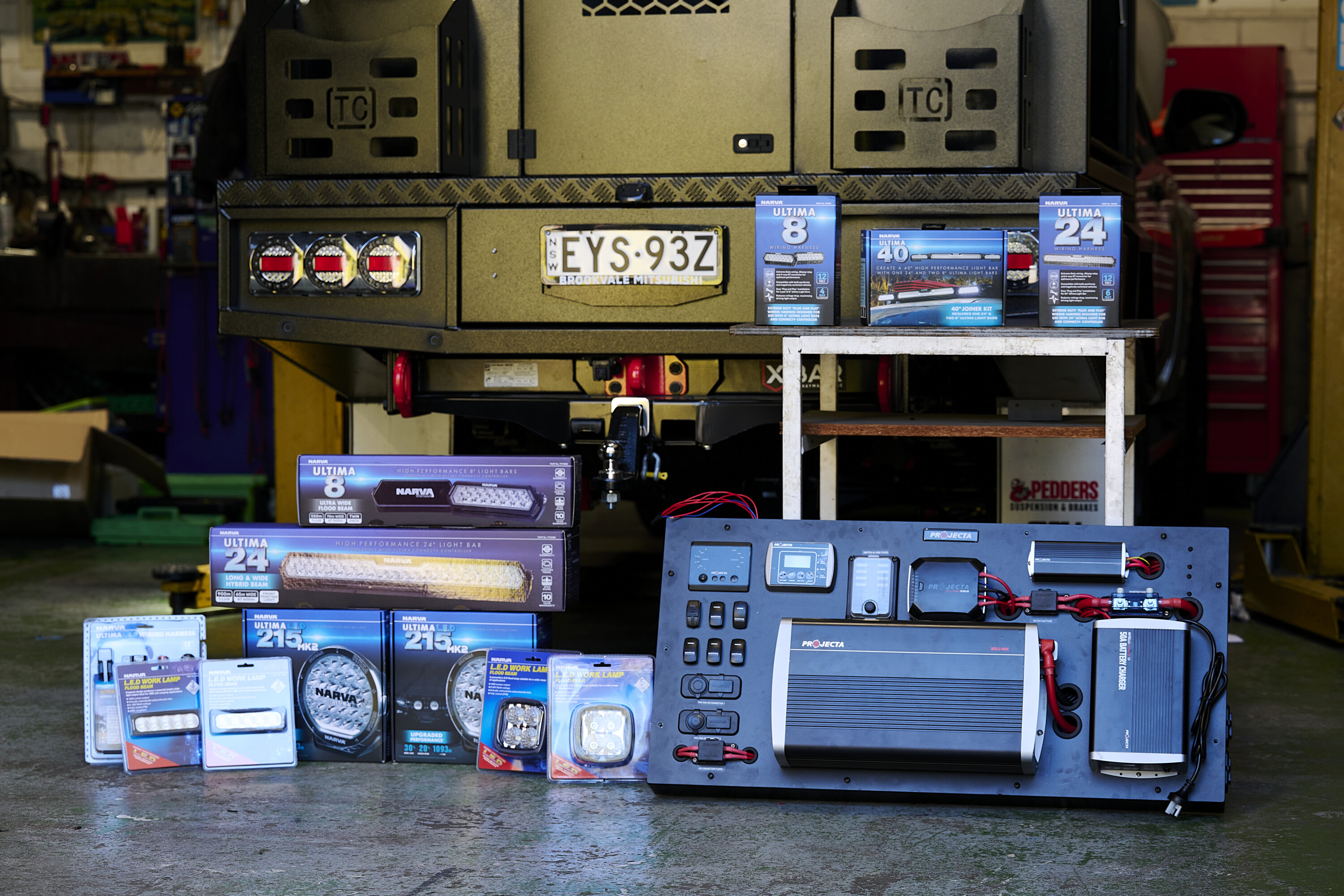
Having self-sufficient, on-location power is a game changer for tradies who have embraced the lithium battery revolution, and the Projecta setup allows you to even run 240v power tools when the battery tools are no longer cutting it on heavy-duty tasks.
It will even power items like fridges, lights and cooking equipment (think microwaves, toasted sandwich makers and coffee machines) – all the high-draw devices that tradies and campers require. And with everything built into the one system, it takes the hard work out of the installation.
JUMP AHEAD
-
Dometic CoolMatic CRX 50 upright fridge
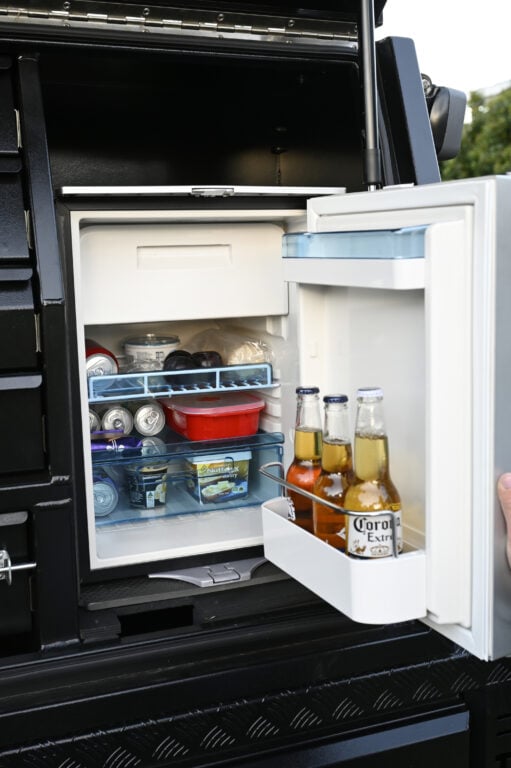
-
Cel-Fi GO mobile booster
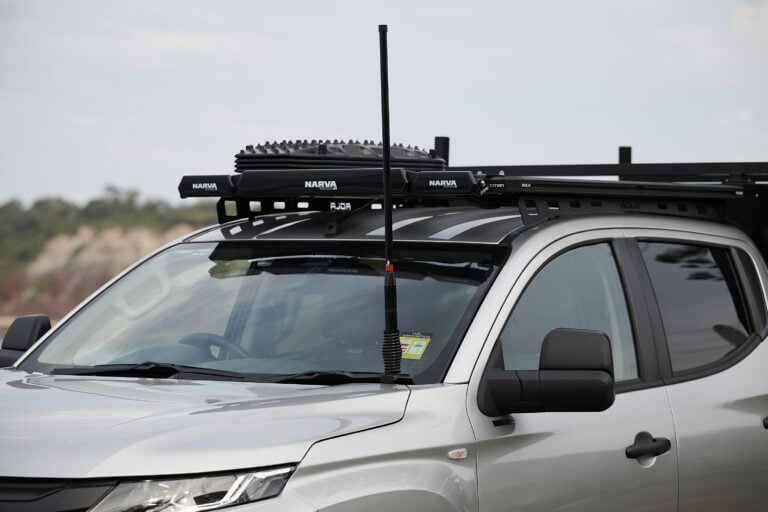
-
MSA 4×4 towing mirrors
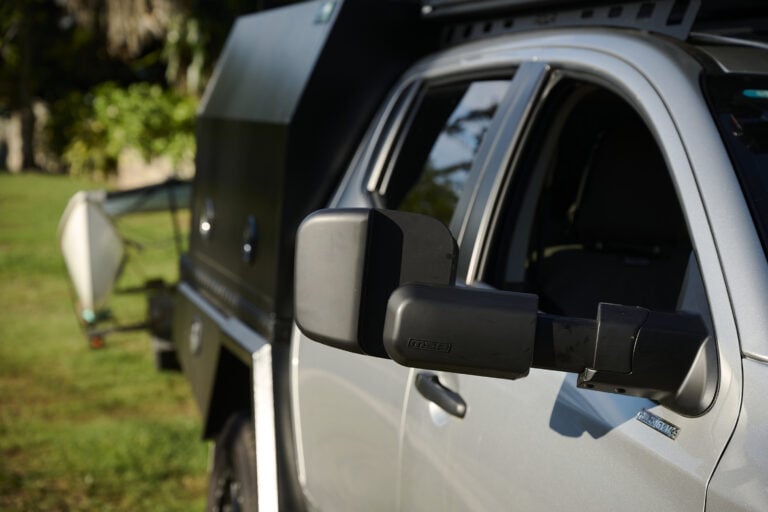
-
Projecta power management
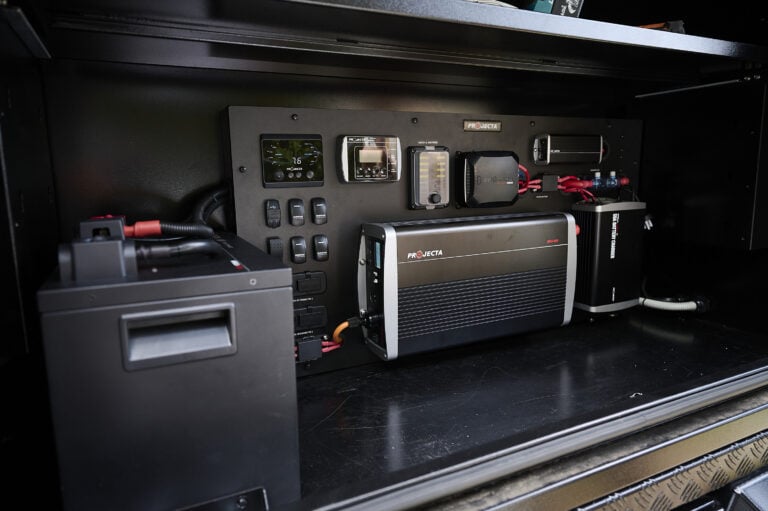
-
Narva LED lights
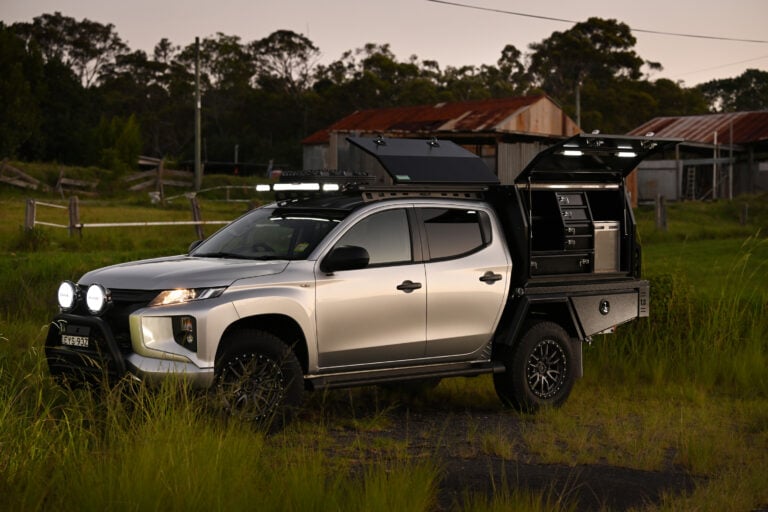
-
Pedders GVM and brake upgrade
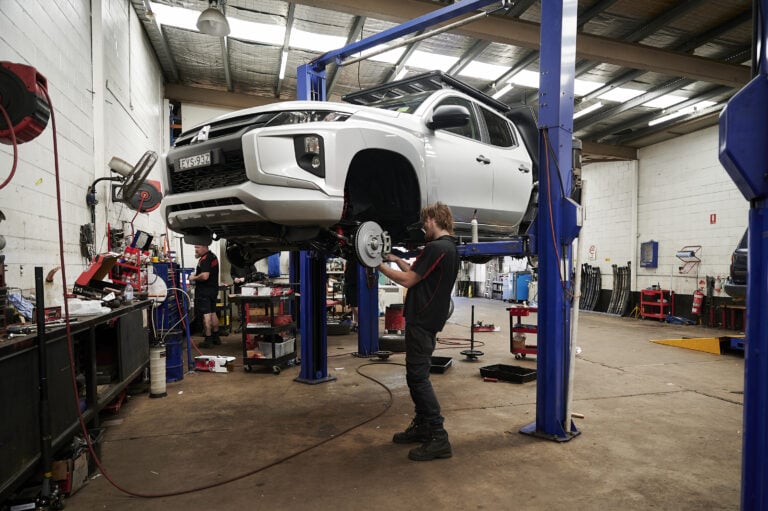
-
Maxtrax recovery kit
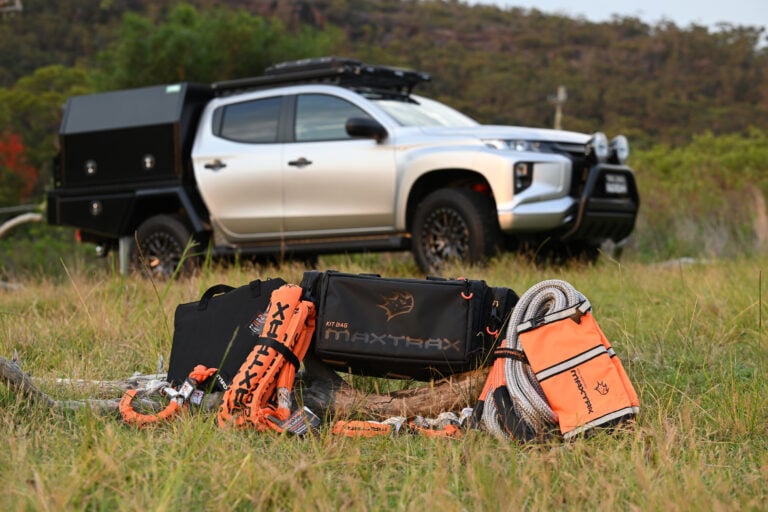
-
PIAK nudge bar
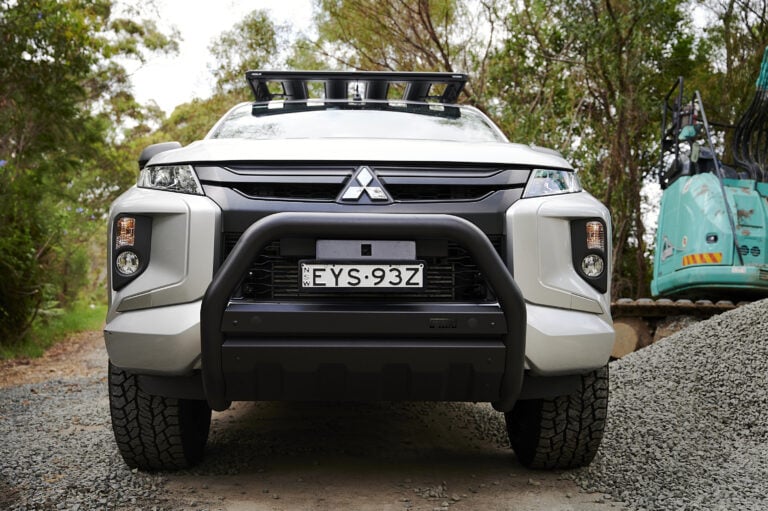
-
Hayman Reese X-Bar
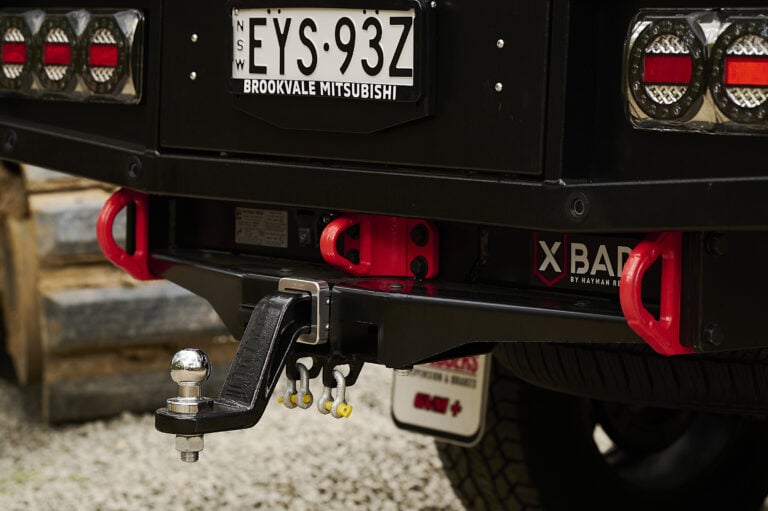
-
Rola MKIII Titan Tray
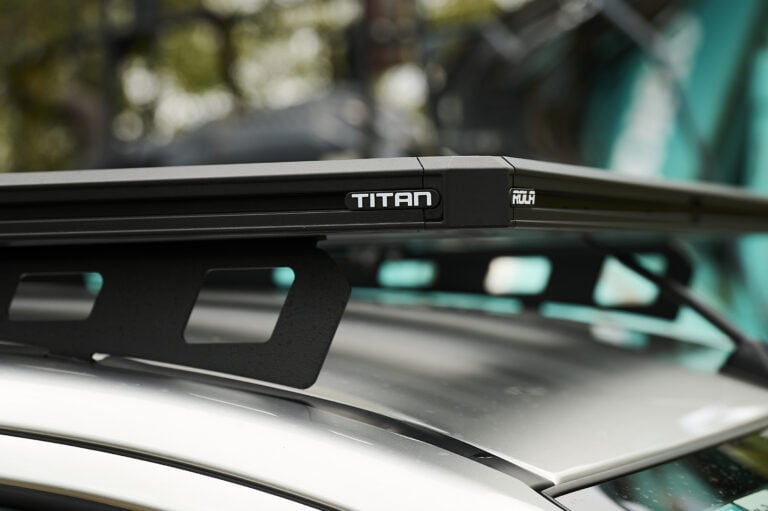
-
TruFit 3D mats
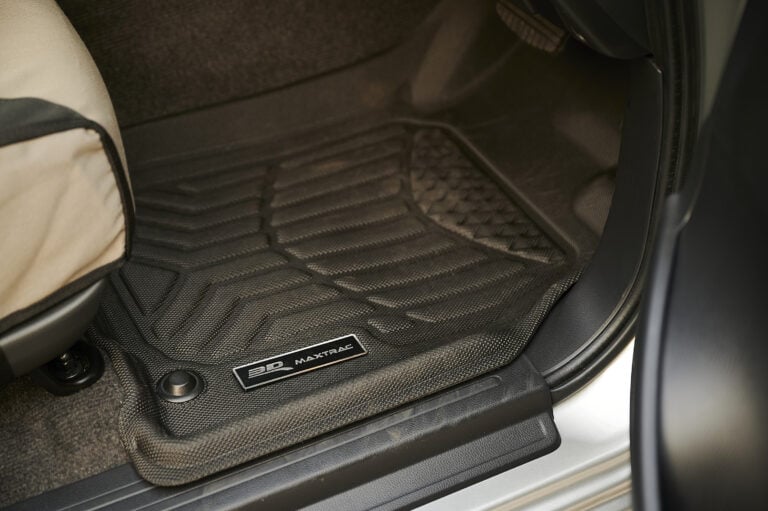
-
Fuel Rebel wheels
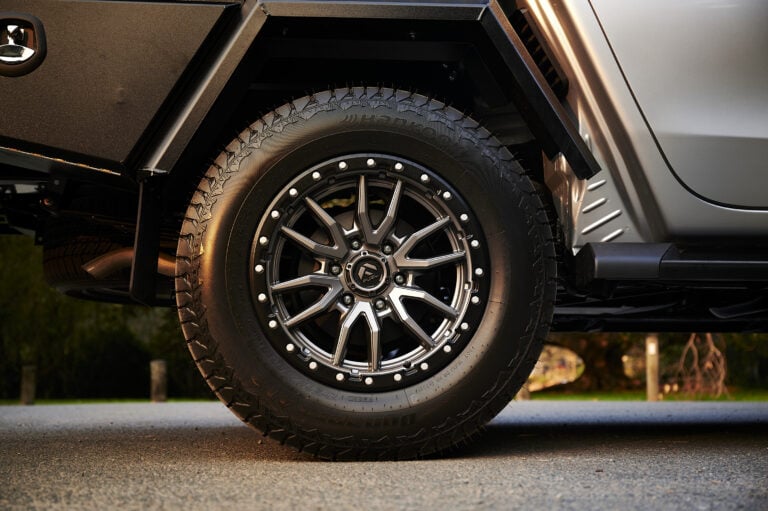
-
Hankook Dynapro AT2 tyres
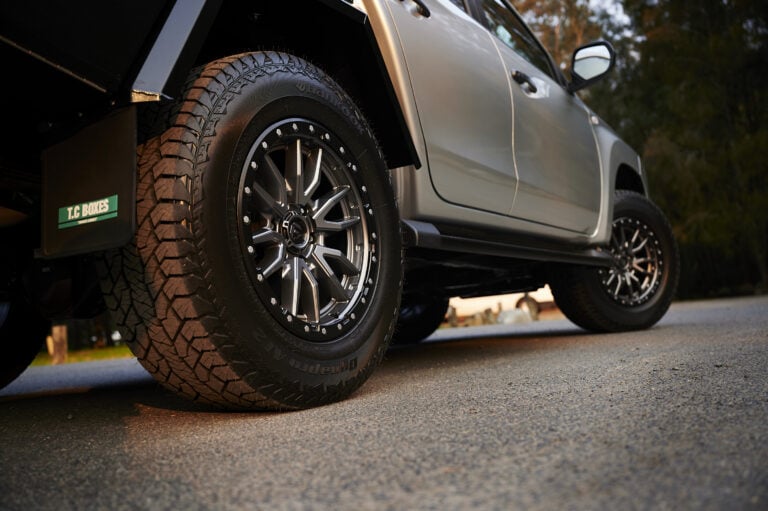
-
TC Boxes tray and toolbox
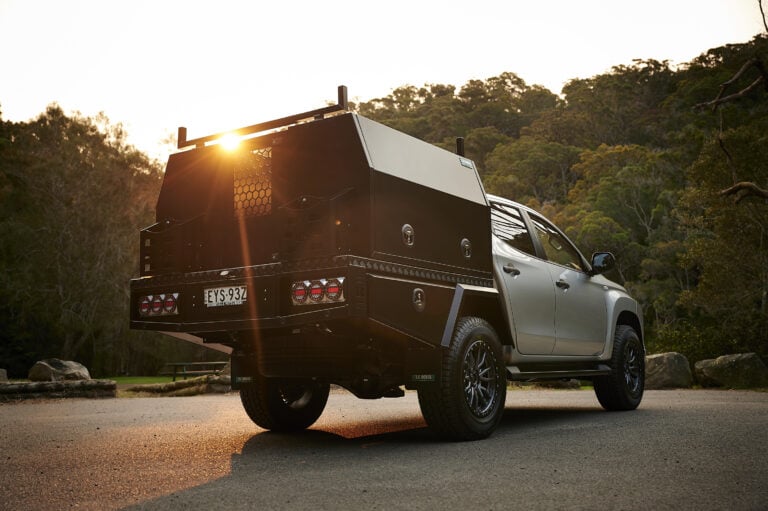
Charging and monitoring
There’s a 25A DC-DC dual-battery charger at the core of the power management board that simultaneously provides a three- or five-stage charge from solar and/or alternator inputs, to ensure you have a consistent and reliable power source.
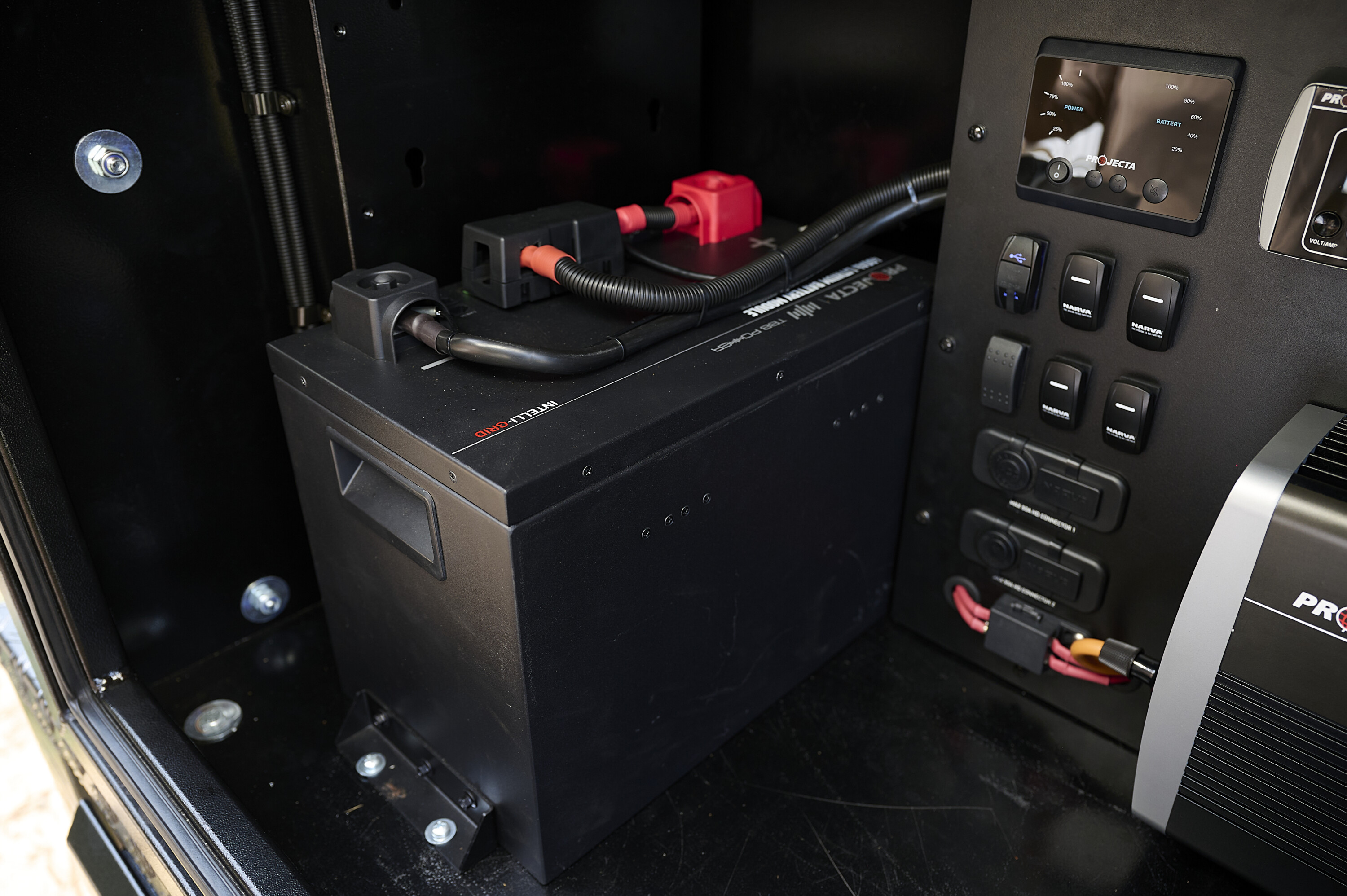
The board also incorporates a BM500-BT battery monitor that provides real-time state of charge (SOC%) data and offers insights into your battery’s overall health. Armed with this information, you can confidently plan your work day or weekend adventures as you’ll know exactly how much power you have available.
If you have multiple tradies charging batteries on the worksite or family grabbing drinks from the fridge and having a cook-up on the weekends, the battery monitor will let you know when it’s time to start charging the batteries, either by starting up the engine or setting up the solar panel.
Clean power
For convenience, the Power Management Board is equipped with 3.1A USB sockets, a merit socket, and an accessory socket.
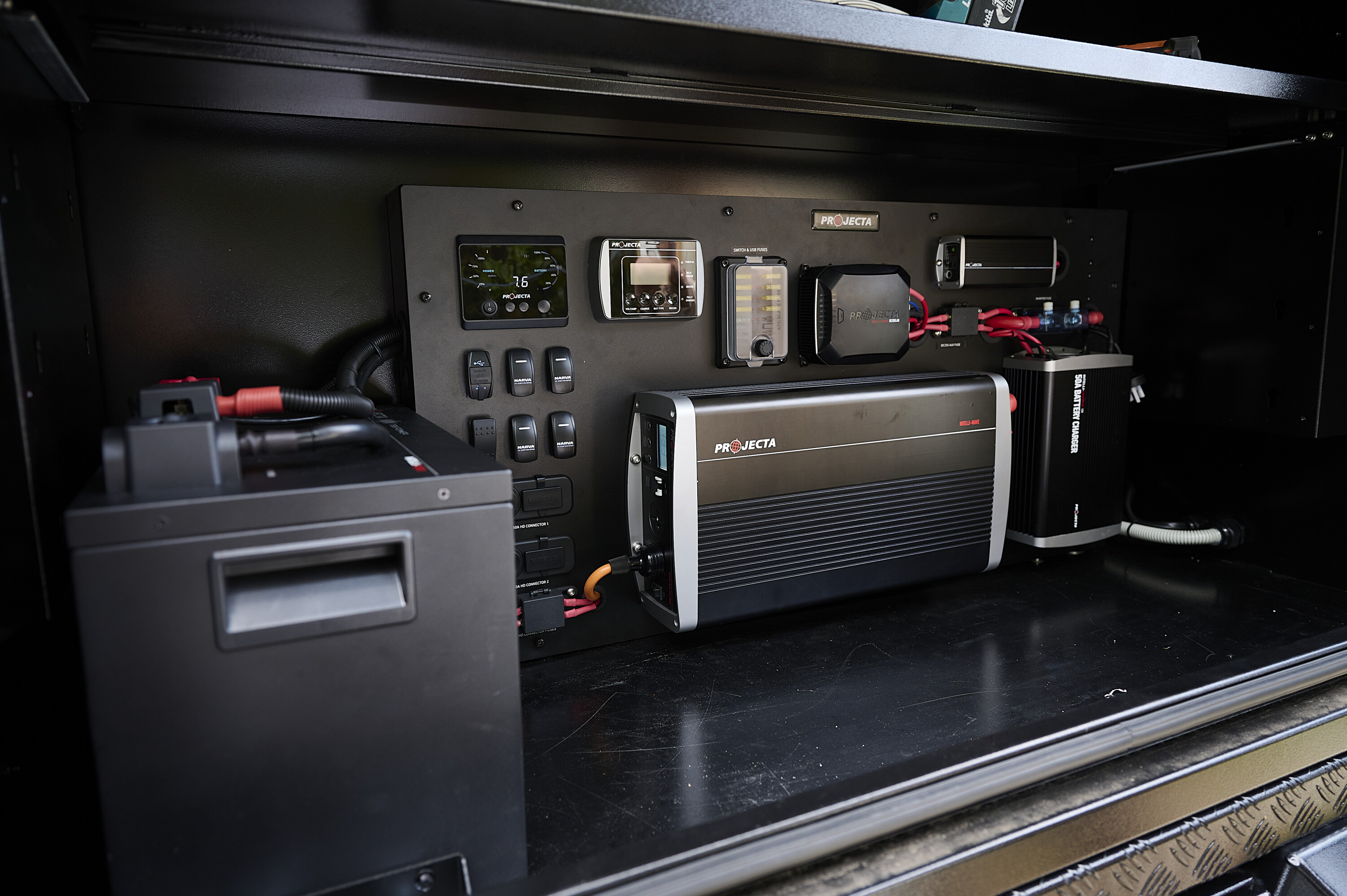
There are five switches on the panel that not only provide control but a level of customisation that caters to your specific needs. The setup is such that managing your power distribution is a simple and intuitive task.
The 2000W Pure Sine Wave Inverter (IP2000) that’s mounted to the power board takes 12V DC power and converts it into 240V AC power. The pure sine wave output is a clean and stable power supply, which means it’s suitable for powering a wide array of devices including sensitive equipment such as laptops or even a printer, transforming our Triton into a genuine mobile office.
Protection
A Low Voltage Disconnect feature adds a layer of protection for deep-cycle batteries, protecting them from damage that can be caused by over-discharge.
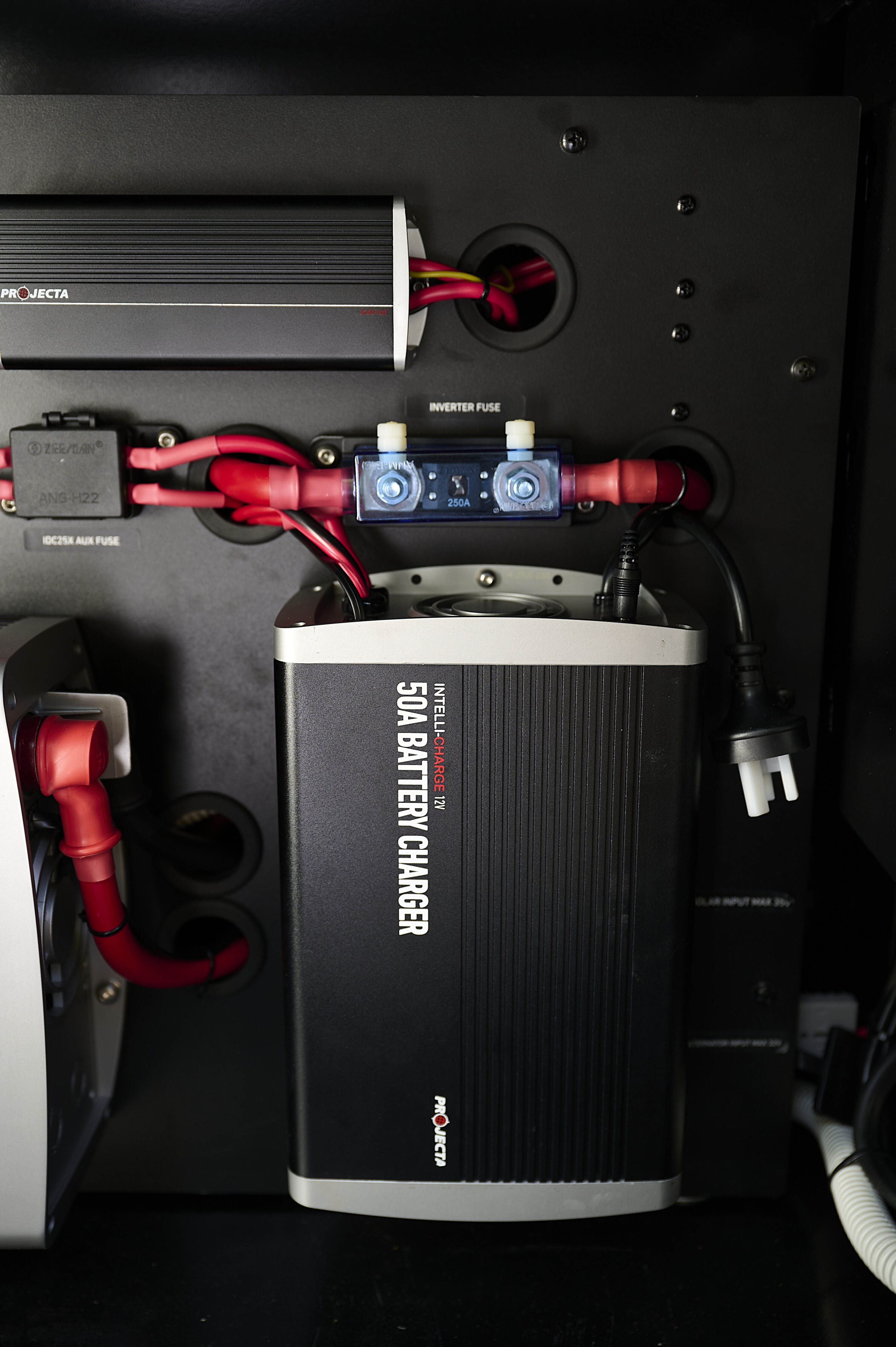
While Projecta offers a setup with a built-in 200Ah Lithium battery designed to work in conjunction with the power board’s 2000W inverter, we opted for the larger capacity 400Ah battery for the Triton’s system.
The 400Ah battery has overvoltage, undervoltage, overcurrent, high/low temperature and short circuit protection, while features include a top-mounted battery indicator and battery isolation switch. It also has communication ports that ensure compatibility with Projecta’s Intelli-RV and Intelli-Grid systems, displays and monitors, or additional batteries.
User-friendly design
Beyond its powerful features, the Projecta Power Management Board stands out for its user-friendly design.
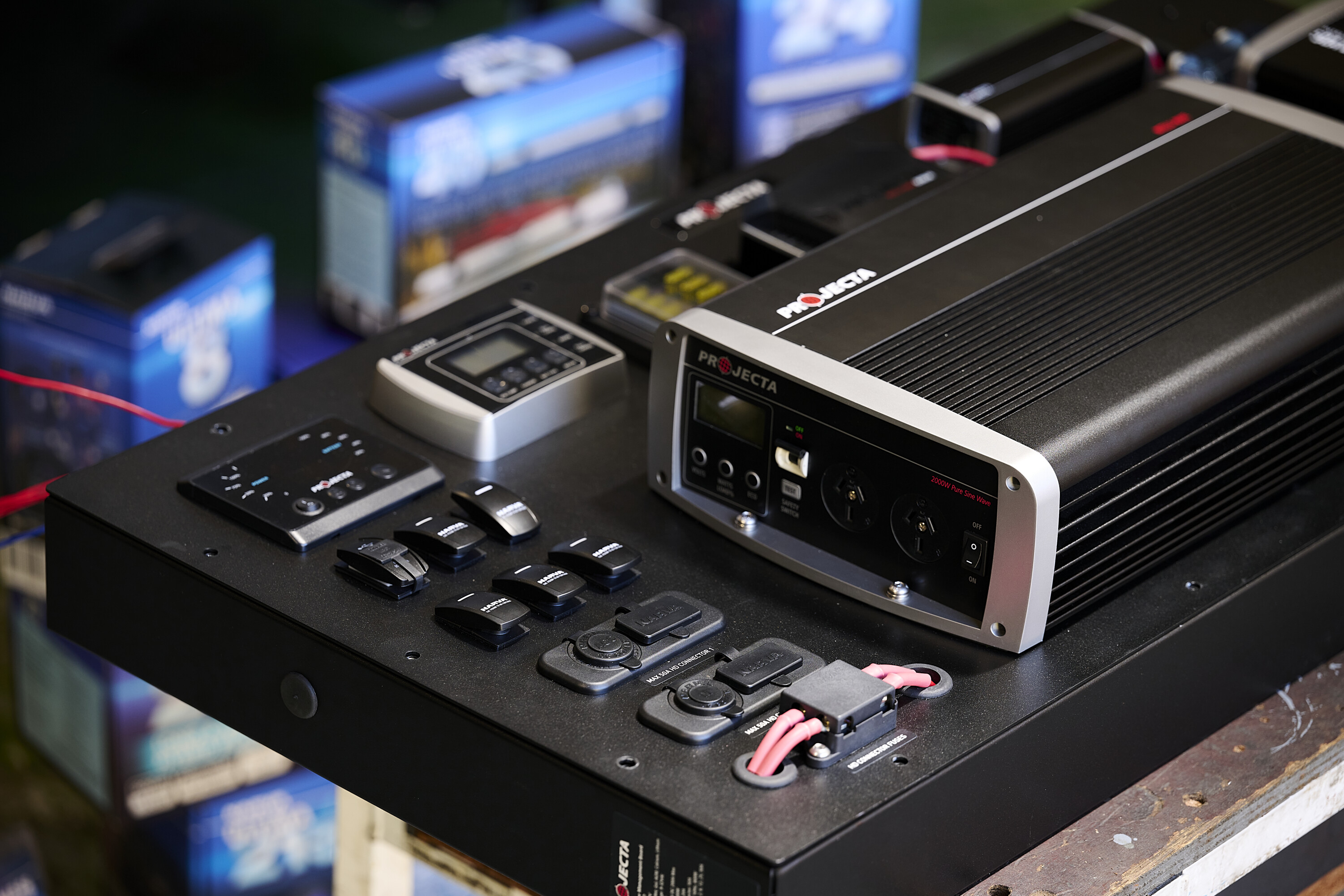
The pre-built, all-in-one unit simplifies installation, catering to seasoned tradespeople and weekend DIY enthusiasts. Despite the fact that setting the system up is quick and hassle-free, we opted to have Rhett and his team at Paul Bagnall Auto Electrical install the power board for us.
We reckon adding this Projecta power system to our Triton has significantly elevated its versatility, for both work and play.
Kia has officially confirmed what we all knew was coming — the brand’s all-new dual-cab ute will be called the Tasman.
SNAPSHOT
- Kia officially names its upcoming dual-cab as the 2025 Kia Tasman
- Arrival timing for the new ute locked in for next year
- Engine options and body styles are also beginning to firm
A new TV commercial published to Youtube has today confirmed the Tasman name to the public and also given us an official arrival date of 2025.
Like the first ad, the new commercial features a number of high-profile Aussie athletes and finishes with text on screen saying: “Kia Tasman ute. Arrival 2025.”
As well as bearing the name of the sea that stretches between Australia and New Zealand, the Kia Tasman Ute will benefit from some local testing and development as it strives to steal customers away from key rivals like the Toyota HiLux, Ford Ranger and Isuzu D-Max.
More than 100 Tasman utes are currently undergoing development testing around the globe.
What engines will power the 2025 Kia Tasman?
Kia is yet to reveal any official specs for the Tasman ute but just as its name was a poorly kept secret, it’s openly understood power will come from a 2.2-litre turbo diesel mated to an eight-speed automatic.
The engine is the same 2.2L ‘Smartstream’ unit currently used in the Hyundai Santa Fe, Hyundai Palisade and Kia Sorento where it makes 148kW/440Nm.
If those outputs are carried over to the Tasman, it will put Kia’s ute in the same ballpark as rivals like the Isuzu D-Max, Mazda BT-50 and Nissan Navara which all make 140kW/450Nm.
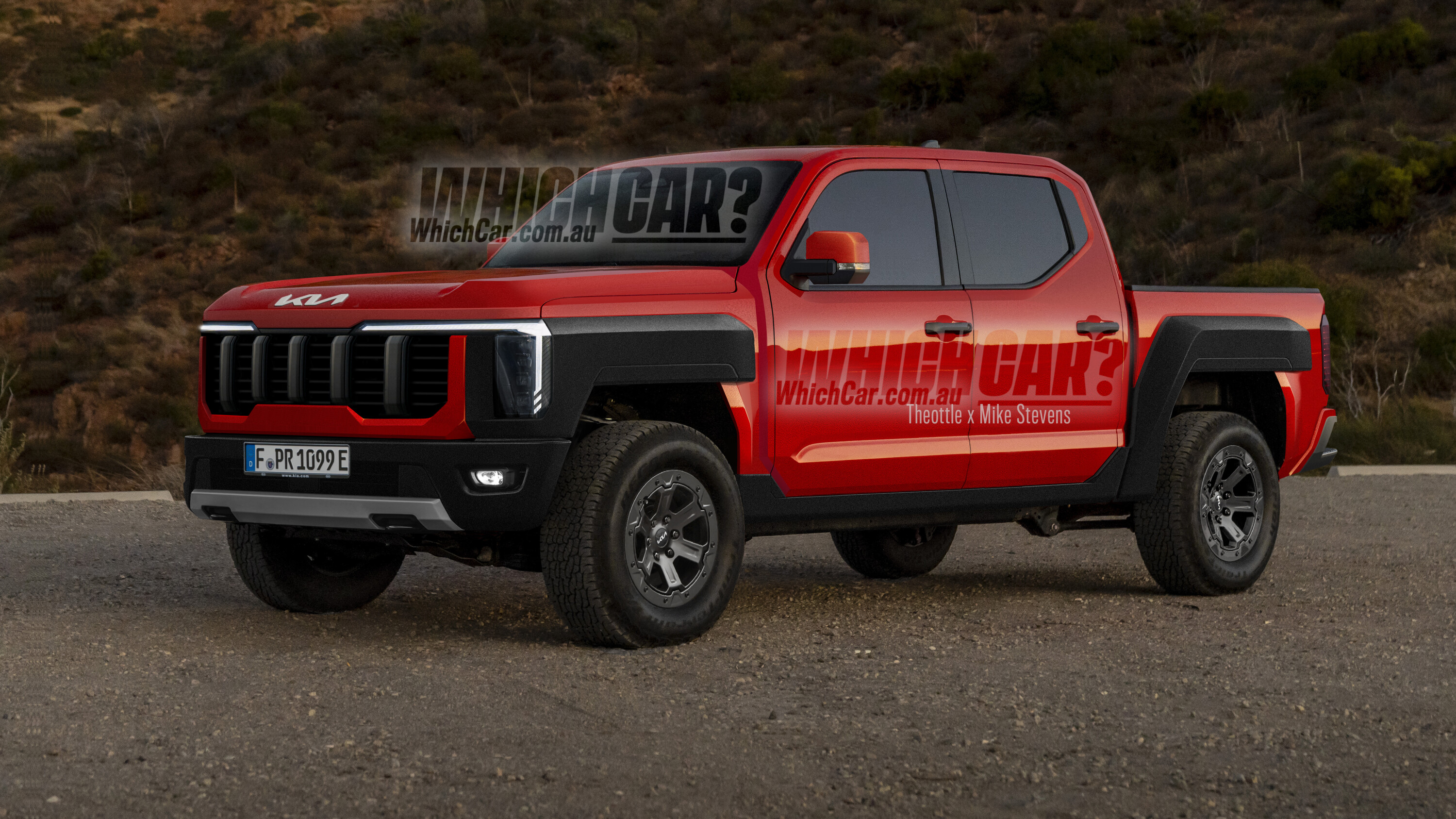
Another engine that could potentially slot into the Kia Tasman is the 3.0-litre inline six-cylinder turbo diesel currently found in the Genesis GV80 SUV.
In the Genesis, the big six-cylinder makes 204kW/588Nm which would give the Tasman a gutsy rival for V6-powered versions of the Ford Ranger and Volkswagen Amarok.
This engine could be deemed too expensive for the Tasman, however, or Hyundai/Kia might choose to reserve it for its premium marks as the GV80 is currently the only model to use that diesel.
What body styles will the Kia Tasman offer?
Just like its key rivals, the 2025 Kia Tasman will be available as a single or dual-cab and have the option of either a cab-chassis or pick-up tray.
An extra-cab body style is said to be off the cards, for now.
March: Tasman teased as new ad campaign launches
The 2025 Kia Tasman ute has inched closer to its full reveal with a new video officially confirming what it’ll be called.
To kick off its teaser campaign, Kia has enlisted the help of a star-studded cast to announce the Tasman ute is “set for Australia”, with expressions of interest now open on its consumer website.
The first commercial – which premiered during the 2024 NRL season opener – features a host of Australian sporting legends gathered in a pub debating over what it should be called.
The stars include Ash Barty (tennis), Lance ‘Buddy’ Franklin (AFL), Dylan Alcott (tennis), Mackenzie Arnold (soccer), Steve Waugh (cricket), Damien Oliver (horse racing) and Jessica Watson (sailing).
While it doesn’t explicitly reveal the name of the new ute, there are clever hints throughout the video, including a newspaper article stating “one [new ute] making its debut is The Tasman” and a scene where rugby legend Alfie Langer throws a dart that lands on the Tasman Sea between Australia and New Zealand on a map.
The video ends with a tightly-cropped shot that partially shows the pub’s exterior sign, suggesting its full name is ‘Hotel Tasman’.
This spot is the first in what’s expected to be an extensive teaser campaign ahead of the Kia Tasman’s full reveal later this year and its Australian launch sometime in 2025.
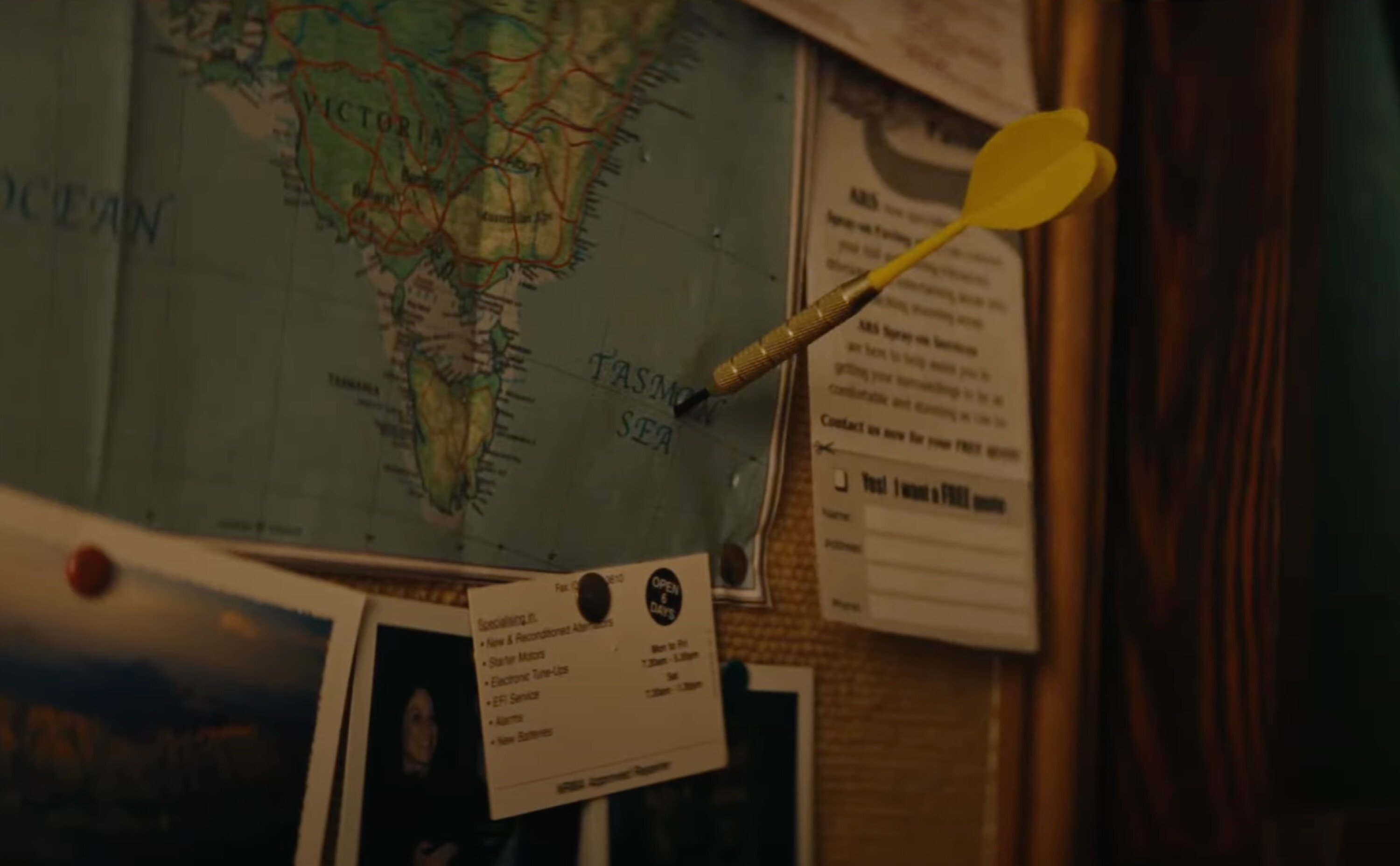
The Kia Tasman is based on a newly developed body-on-frame platform and will compete against the popular Ford Ranger, Toyota HiLux, Isuzu D-Max and Mitsubishi Triton.
Kia hopes to sell around 20,000 units annually, which would assist in its ambition to overtake Mazda, Ford and Hyundai to become Australia’s second-largest car brand behind Toyota.
Recent sightings of the Tasman in a South Korean carpark and during winter testing in Sweden against the Ford Ranger Raptor have provided insights into its design, which seems to align with Kia’s latest styling cues seen in models like the EV9 electric car and facelifted Sorento.
Inside, expect the Tasman to receive a similar look to Kia’s latest vehicles with a ‘panoramic curved’ display for the instrument cluster and infotainment system.
Visible components in the camouflaged vehicle include a traditional gear shifter, a selector for two-wheel-drive, manual four-wheel-drive, automatic four-wheel-drive and low-range, another control that appears to adjust the drive modes, and an engine start/stop button on the centre console. It also has mesh front headrests similar to the EV9.
The Tasman will feature a built-in step within the rear bumper to access the tub, like the Ranger.
While the Tasman will also be sold in the Middle East and South Africa, Australia has played a dominant role in forming the base specifications of the new ute range.
“A substantial amount,” said Kia Australia’s GM of product planning, Roland Rivero, when asked how much input Australia will have.
“A lot of work’s being done to, as much as possible, influence the development to suit our market. Australia’s position is being seen as a very important one.”
Muscle memory is an interesting function of the human body.
After driving 70 Series LandCruisers on and off over 30 years, and owning one myself, the action of opening the driver’s door and pulling myself up into the cabin instinctively includes my left boot reaching for the clutch pedal as I land on the slim seat. It took three or four days of living with the new LC79 with its automatic transmission behind a four-cylinder diesel engine before the old habit faded.
Getting into a 70 Series is like pulling on a pair of favourite old work boots, and even though this 2024 updated model brings plenty of changes, the familiarity is still there. Like those old boots, the LC70 remains a favourite workhorse.
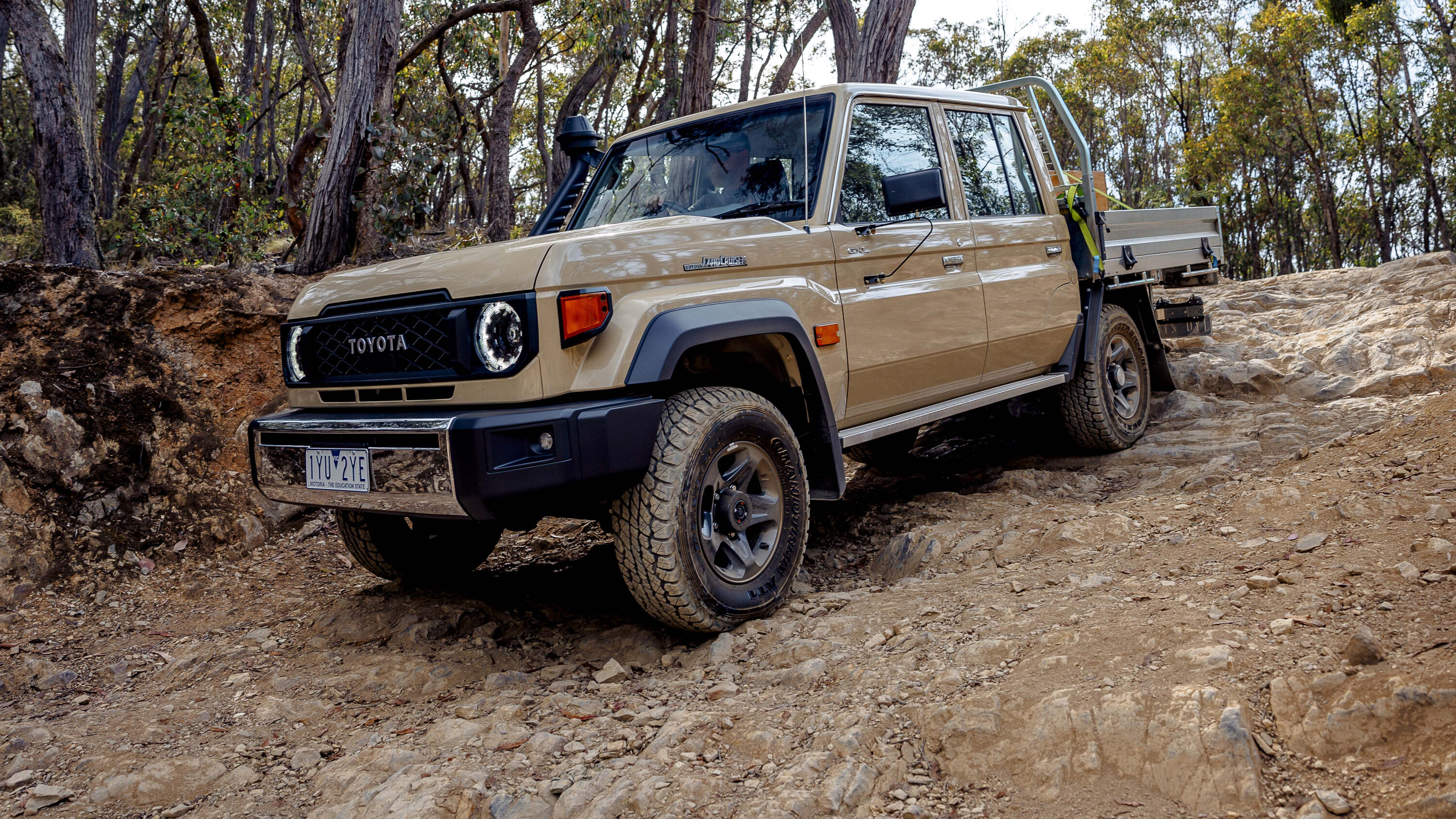
JUMP AHEAD
What’s new
Toyota hasn’t messed with its 40-year-old formula when revising the 70 Series for 2024.
It retains a basic commercial body mounted on a heavy duty chassis, with live axles at each end suspended by coil springs under the front and load-lugging leaf springs at the back.
The front sheet-metal has copped a minor update with a blockier style and reverting back to traditional round headlights, albeit with LED halo rings, but the look remains unmistakably 70 Series. There’s even a nod to the old 40 Series in the new grille vent.
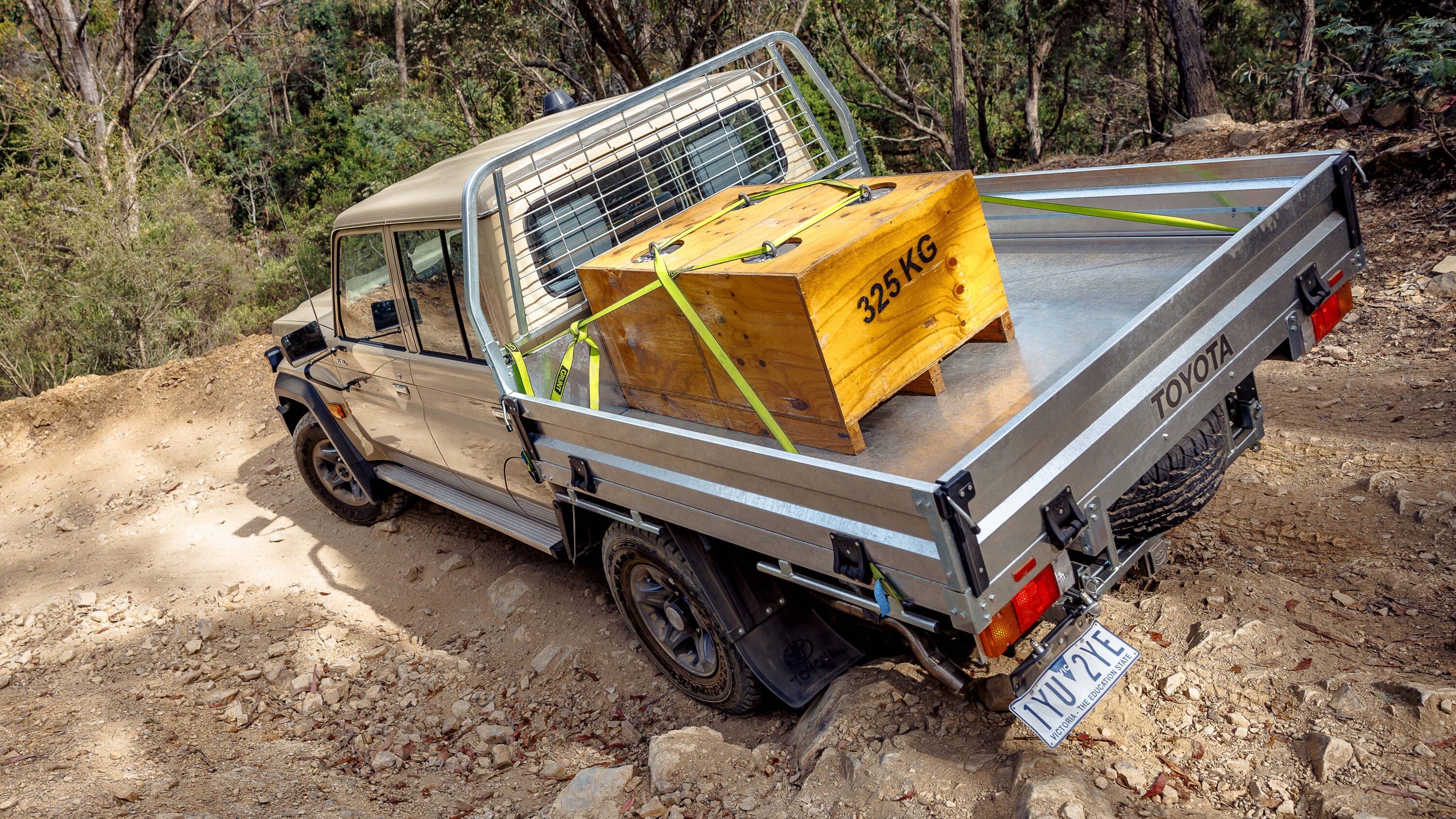
The big changes for 2024 have happened behind the grille and in the transmission tunnel, where the 1GD-FTV 2.8-litre four-cylinder diesel engine and Aisin six-speed automatic transmission form the new powertrain.
This engine and transmission are well proven from the Toyota Prado, HiLux and other models, but this is the first time they have been fitted to the 70 Series range. They join the existing 1VD-FTV V8 diesel and five-speed manual driveline combination; although, models fitted with that powertrain will be harder to source from your dealer.
There’s been plenty of consternation about a four-cylinder engine taking the place of a V8 in Toyota’s workhorse 4×4, but with more torque than the standard V8, a similar power figure, the promise of lower fuel consumption, and the improved driveability of an automatic transmission, this new powertrain will appeal to many buyers.
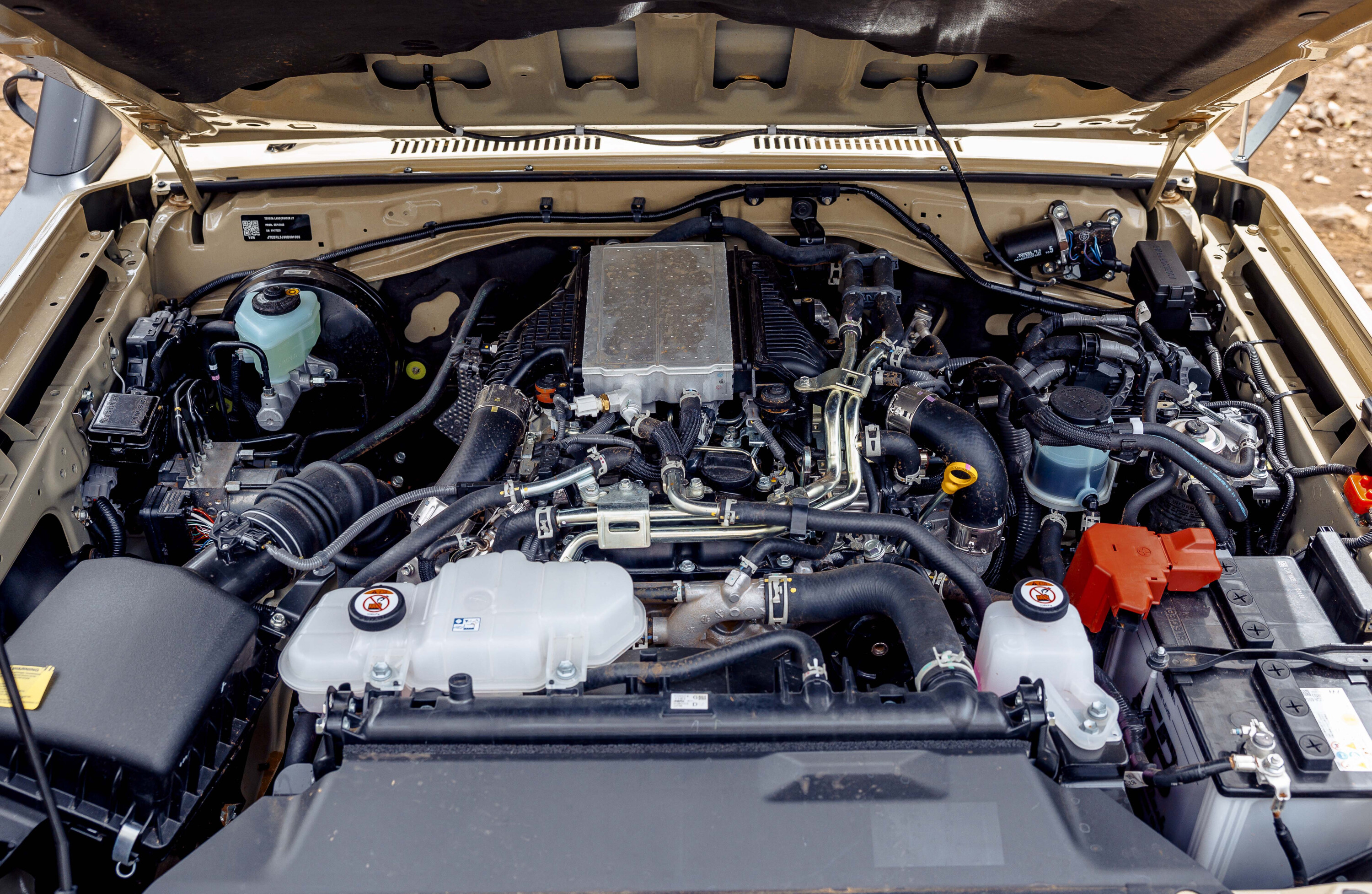
For the record, Toyota quotes the 1GD-powered double cab as using 9.6L/100km on the combined test cycle against 10.7L/100km for the V8 in the same vehicle.
We heard rumours Toyota was testing such a powertrain in the 70 up to four years ago; and while the company was always tight-lipped on it, they have now confirmed there were four such equipped prototypes testing in Australia back then.
To test it for ourselves we took an LC79 GXL double cab with the 2.8/auto combination, loaded it up with 650kg on the tray and hit the tracks.
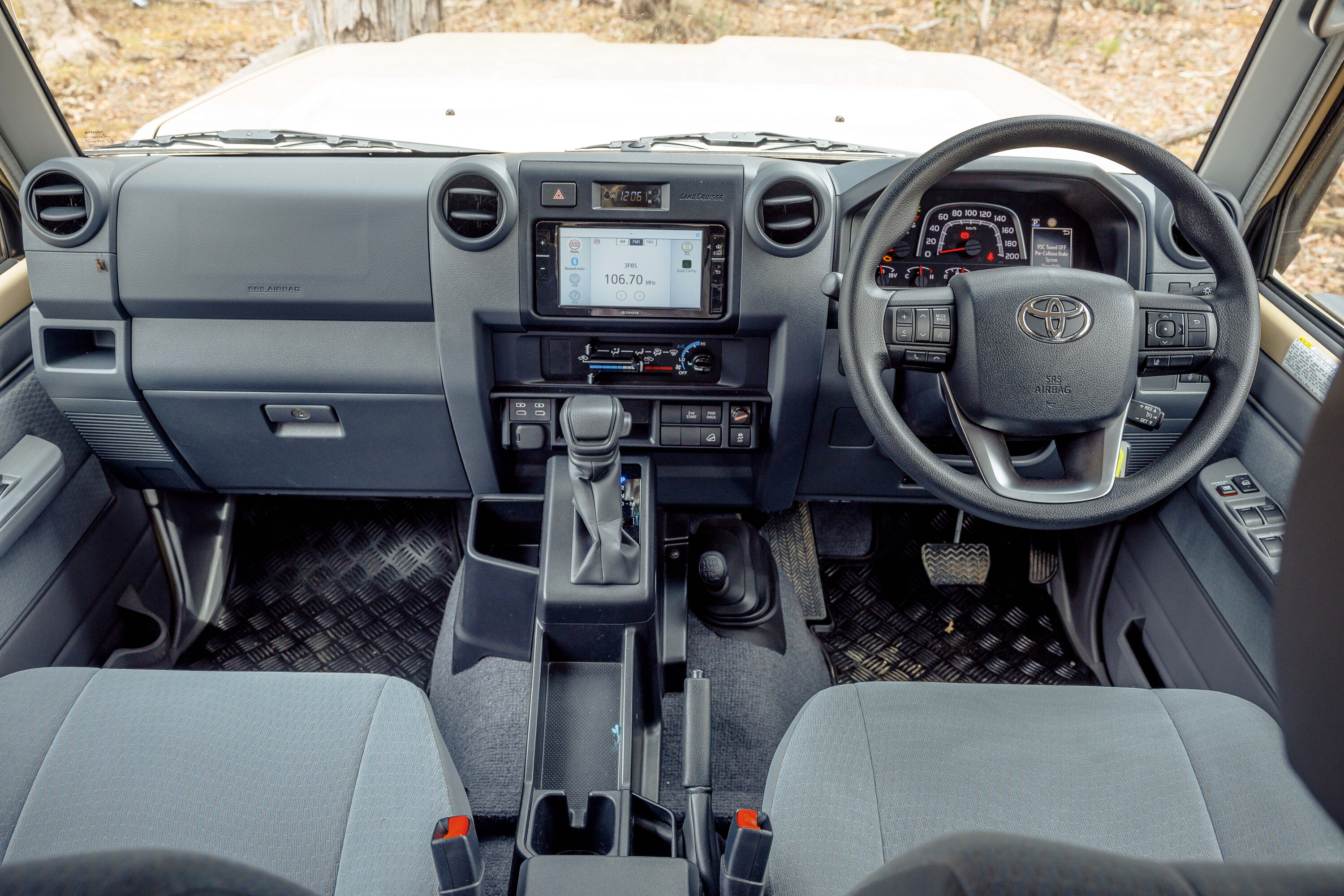
Capacities
Thanks to the lighter weight of the four-cylinder engine compared to the V8, the four-pot has a higher payload. On the LC79 DC GXL tested here the payload is 1325kg compared to 1250kg for the equivalent V8 model.
All grades and engines have a 3510kg GVM. You also need to take the weight of the tray off that payload as the LandCruiser doesn’t come with one; it’s extra and your payload will depend on what you put on the back, so we reckon our 650kg load was respectable considering we were heading for some steep off-road tracks.
We had a weekend with the Cruiser before we loaded it up and unladen it feels almost sprightly with the 1GD/auto combo, certainly more so than with the V8. The 2.8 gets on with the job and the auto transmission gives nothing to complain about.
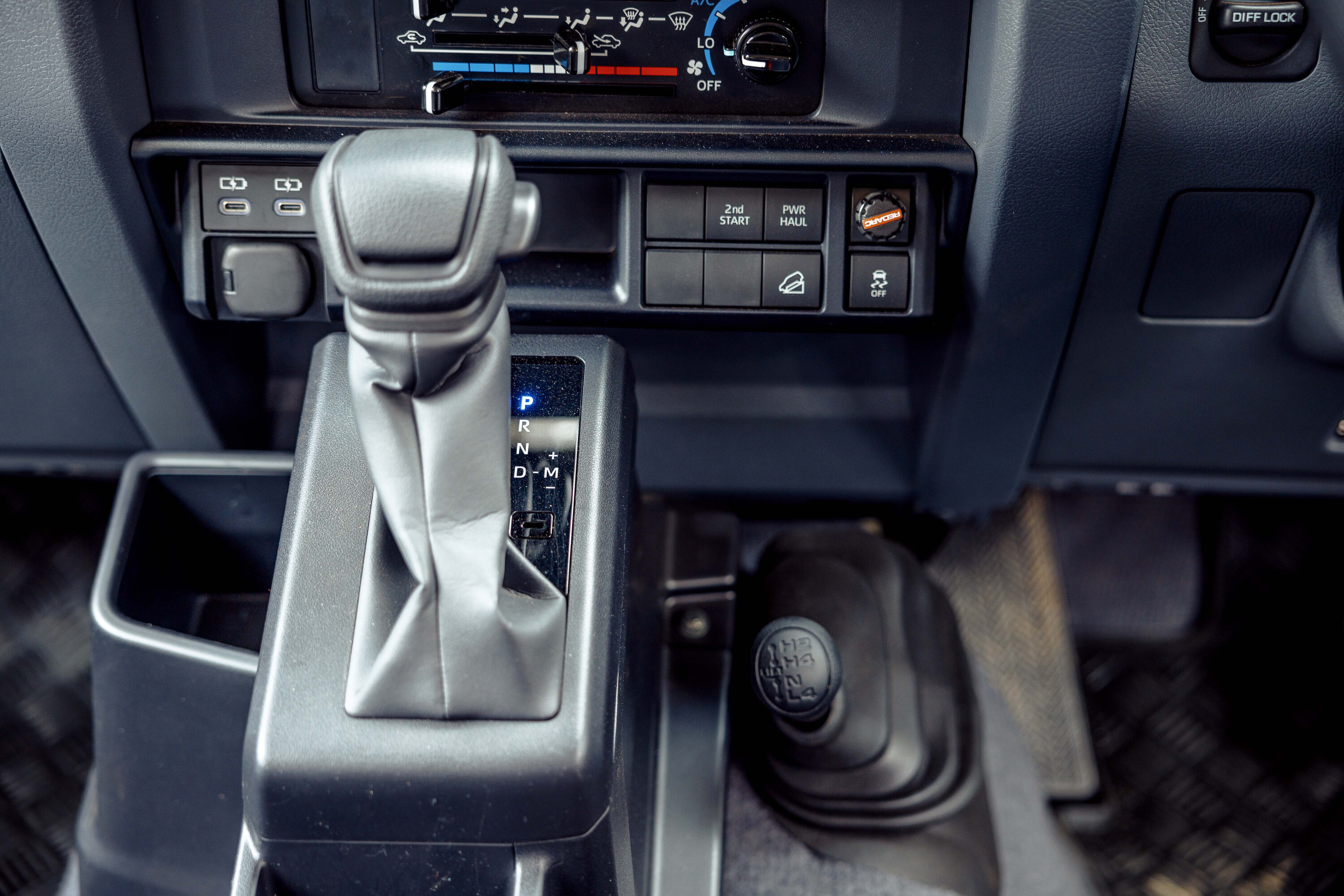
We’ve always liked this Aisin six-speed auto in various vehicles from Toyota and other manufacturers.
With the 650kg load on the back and out on the open road, the engine certainly feels the weight. It is less responsive and requires foot-to-the-floor application to maintain the 110km/h speed limit on hills. That said, the V8 was never much good in this regard and we feel the four-cylinder does a better job of it.
Our previous back-to-back testing with a 3100kg caravan behind each powertrain showed this to be the case.
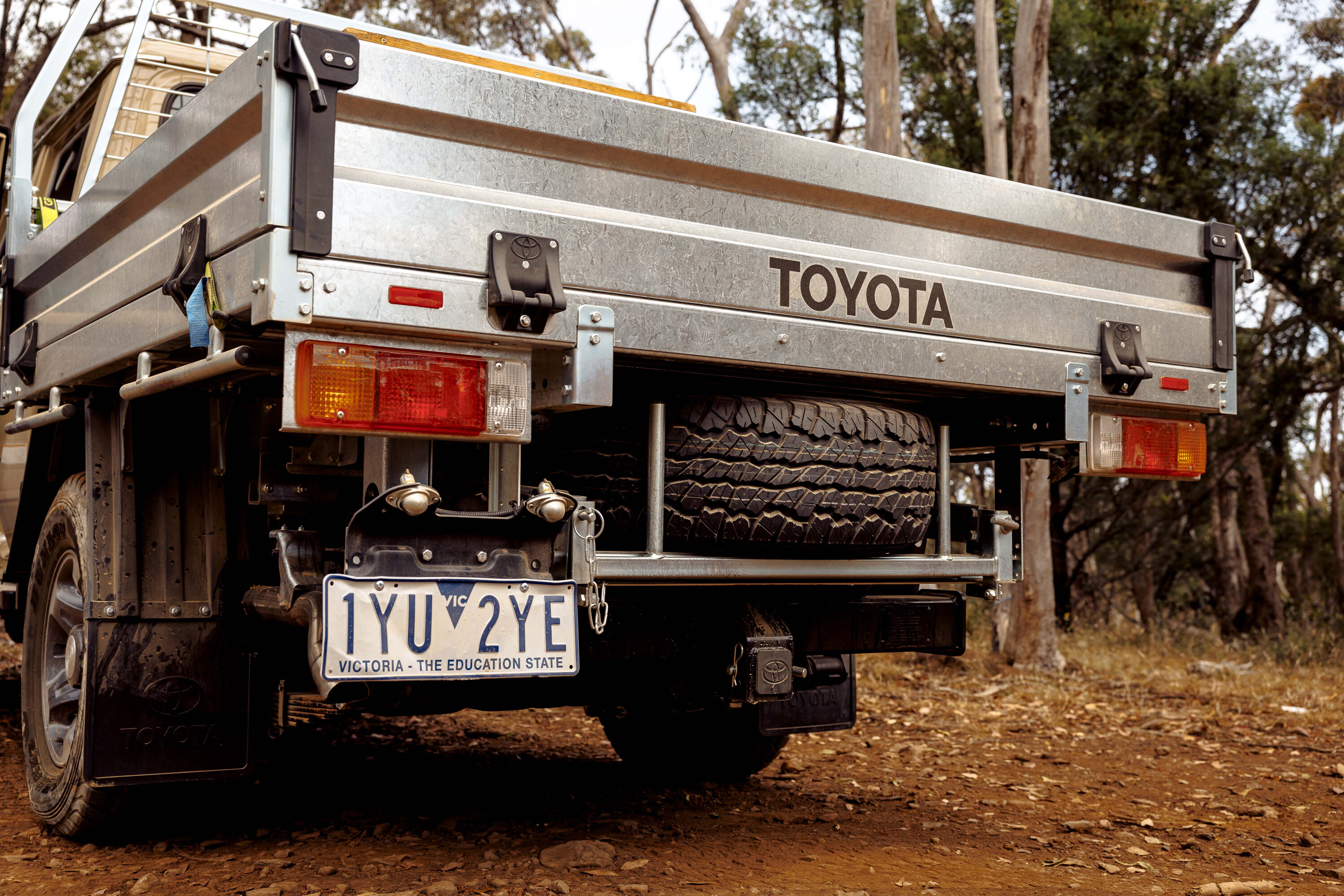
It will be interesting to see how the engine and auto cope with a load on board, and when riding on bigger tyres such as the 33- and 35-inch rubber that many users will fit to their Cruisers.
The rear suspension dropped considerably when the load was added in the tray, but this took some of the jitteriness out of the ride as the vehicle is sprung very stiffly. The ride quality was better with the weight on despite the bum-down, nose-up stance of the laden Cruiser. There was no noticeable lightness of the steering.
The old ball and nut steering box means the 79 has the turning circle of the Queen Mary (15m) but you soon get used to it and learn your limits.
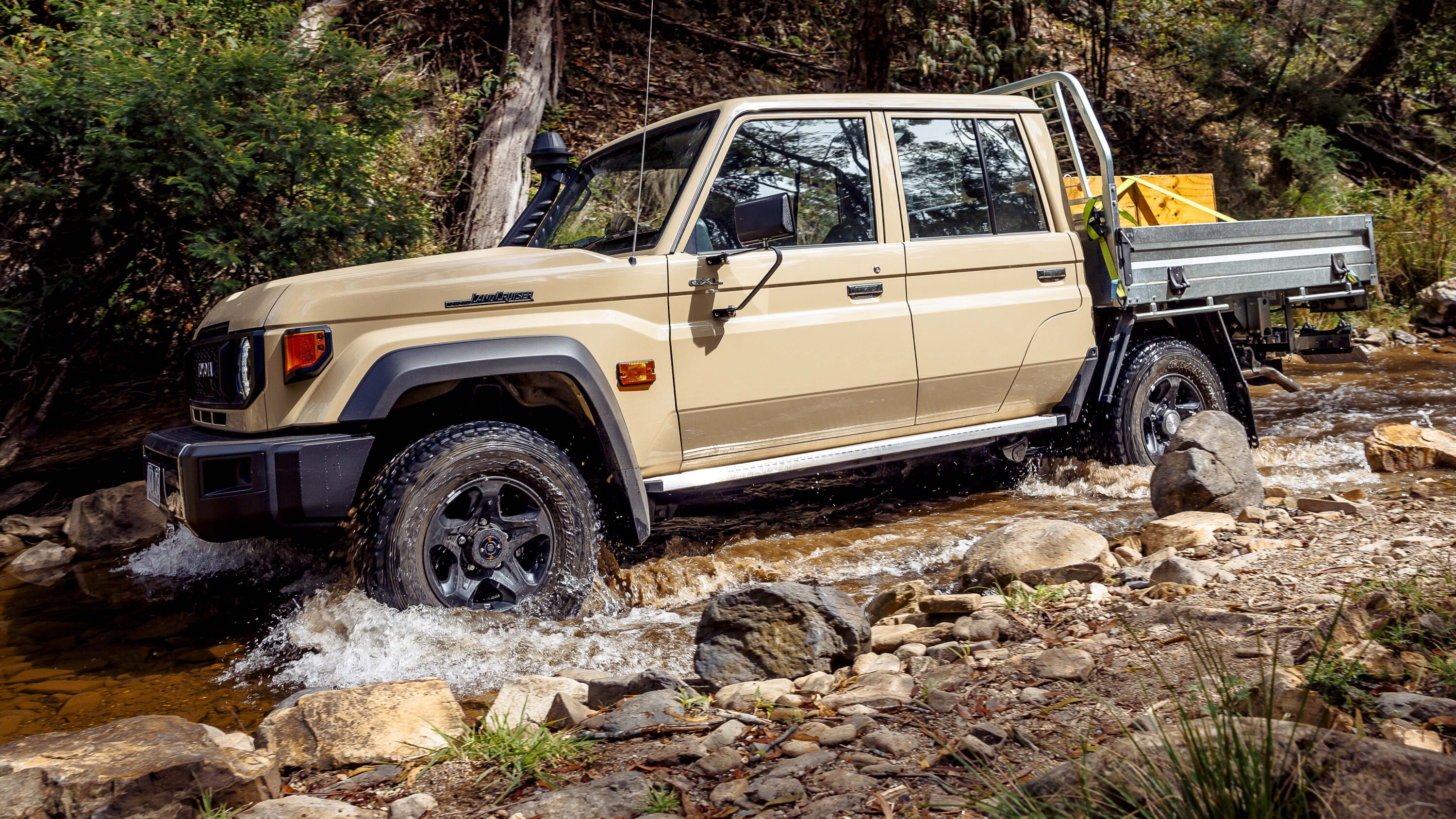
Off-road
A key strength of the 70 Series has always been its ability to haul loads in any conditions, on- and off-road. All 70 variants have a part-time, dual range transfer case for four-wheel drive, and being a GXL model this example has front and rear locking differentials fitted as standard.
LandCruiser 70s with the 1GD/auto powertrain also get downhill assist control that automatically maintains a set speed and manages wheel slip on steep descents. The automatic gives this combo taller overall gearing than the V8 manual, so the electronic assistance comes in handy in steep country.
Less handy is the hill start assistance that holds the brake when you release it to aid hill starts, but is effectively redundant on a vehicle with an automatic transmission.
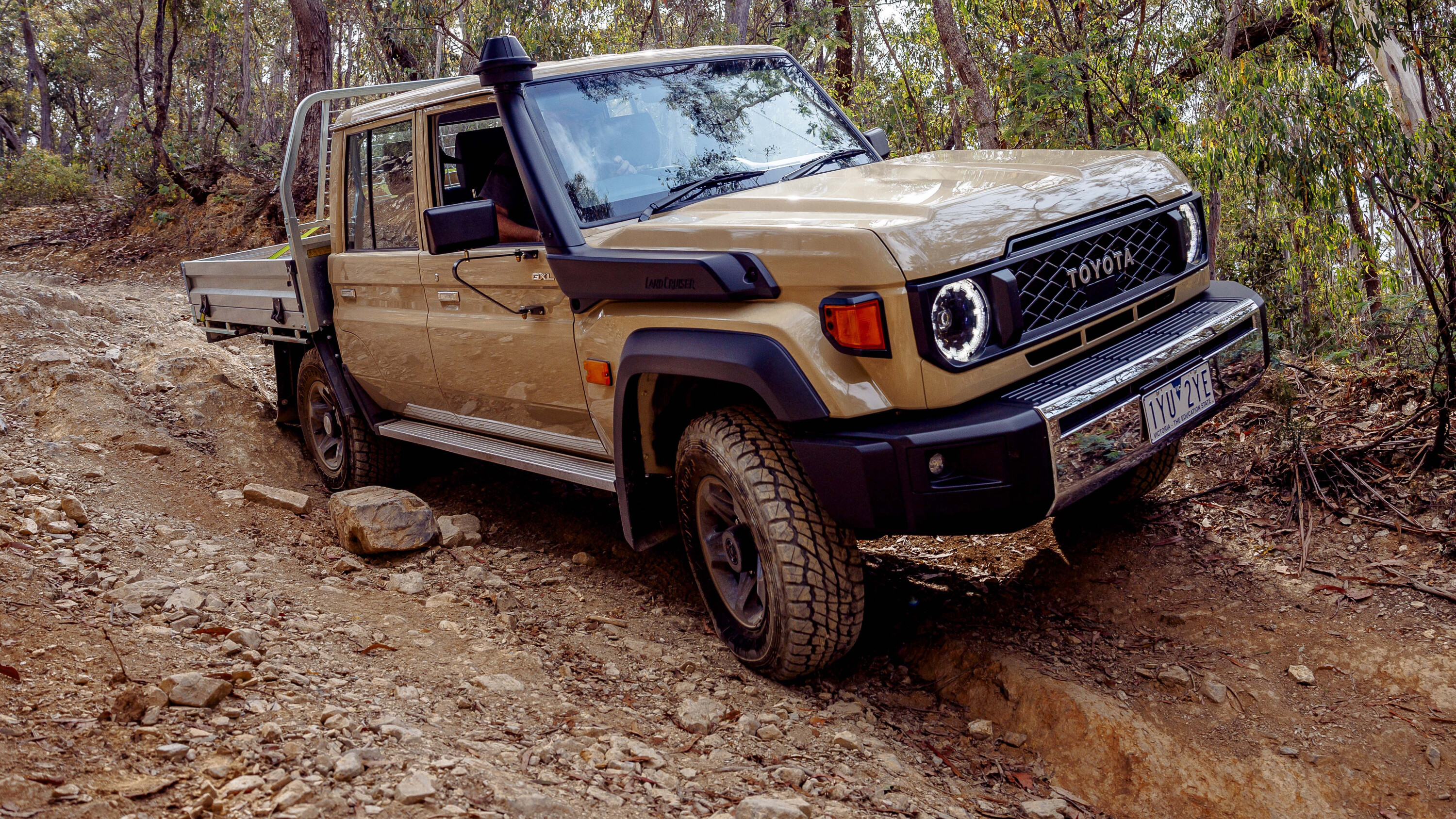
The load in the Cruiser was again a benefit to the ride quality once we hit unsealed tracks, and the suspension did a good job of soaking up the bumps and potholes.
It’s still a relatively stiff setup and the chassis doesn’t give much flex so the 79 easily picks up wheels in uneven terrain. This is where the differential locks and ETC come in handy.
The auto transmission shifter has a tap-to-the-left gate for manual gear selection and low-range first gear was sufficient for the steep descents on this drive, with the occasional tap on the brakes to steady the ship.
The tall cabin with its large flat windows makes negotiating tracks relatively easy as it gives the driver plenty of visibility for wheel placement. Less accommodating is the location of the rear number plate which hangs low under the tray. This has always been a problem on these factory Toyota trays as the number plate scrapes the ground easily and we’ve lost a few over the years.
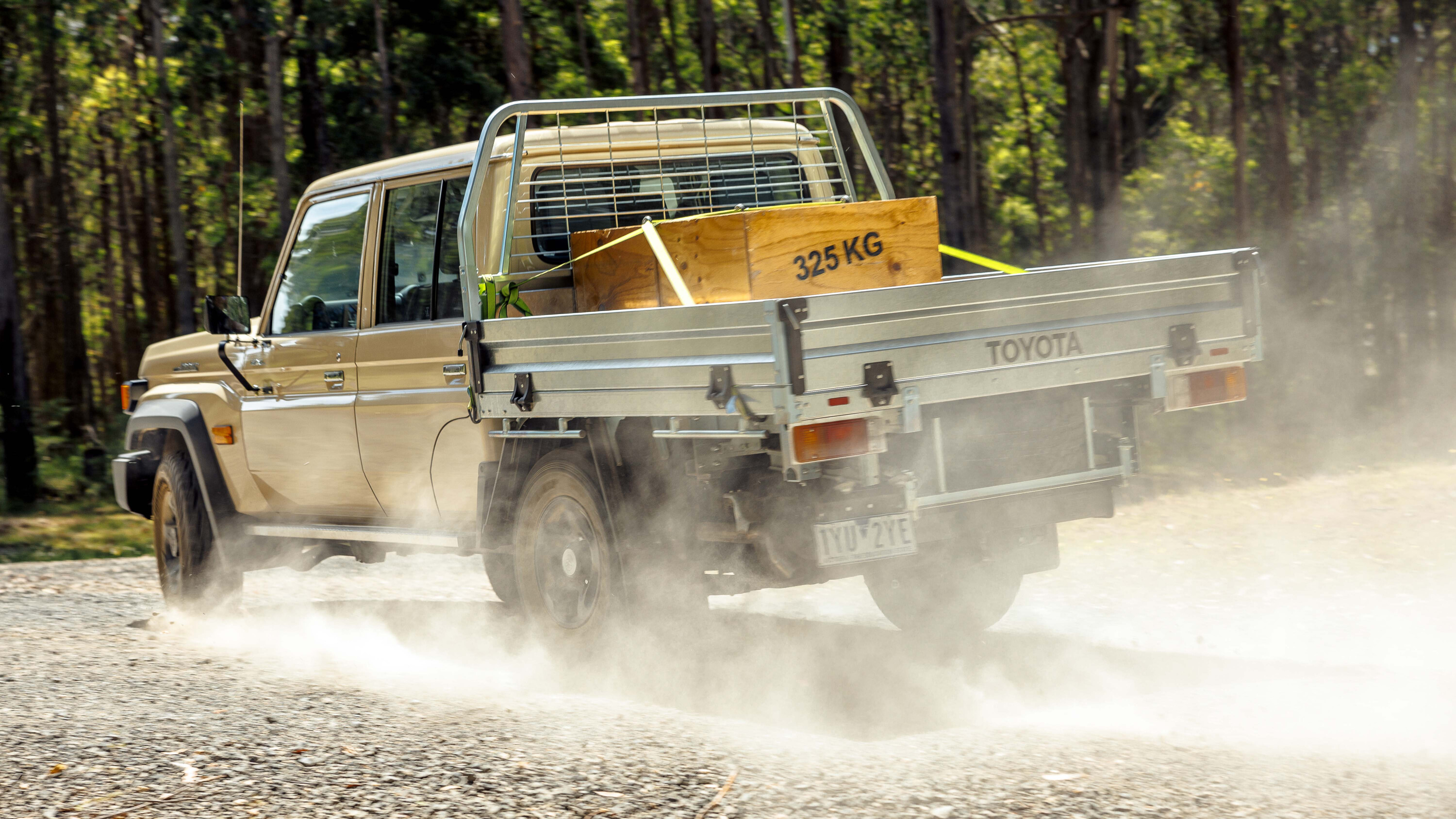
Thankfully we didn’t lose this one and were able to bend it back into shape. There has to be a way to mount it higher up on the tray.
While we’re talking about the tray, the absence of any internal tie-down points makes securing loads harder than it should be; we had to run straps under the side boards and find somewhere on the frame to attach them.
The hooks on the straps we used were too narrow to grip around the external load rails, so securing our load wasn’t as easy as it could have been.
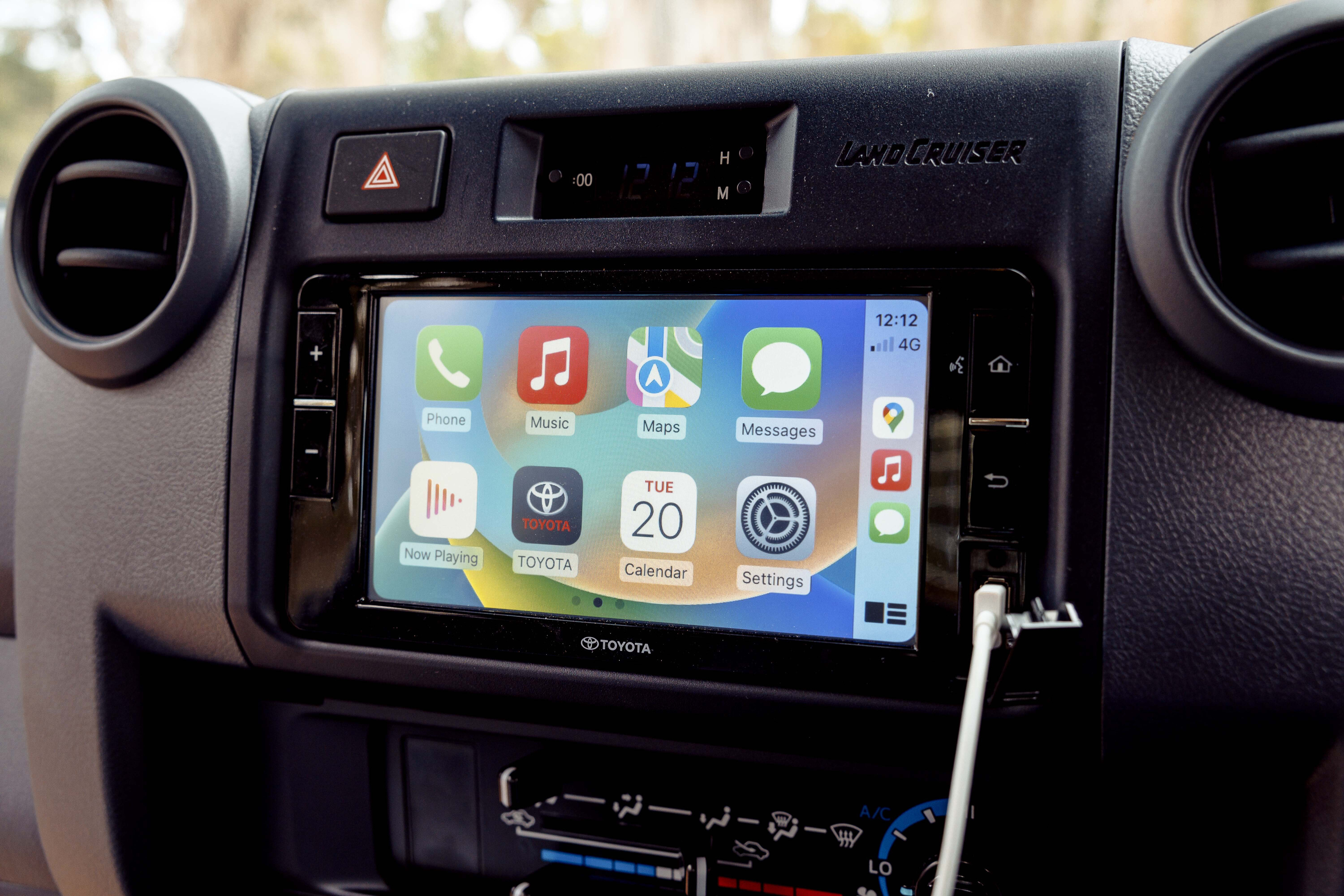
We reckon the flat steel floor of this OE tray will also show its use worse than the chequer-plate floor found in many aftermarket trays.
The 2.8 and auto made light work of climbing out of steep gorges in low range. It was keen to pick up a front wheel when climbing out of ruts, but the standard ETC did such a good job we didn’t need to engage the lockers.
Even in standard trim on the stock tyres, the LandCruiser is an excellent off-road workhorse and you can see why it’s relied upon by so many farmers and industries in the outback and the bush. There really is nothing else like it on the market … yet.
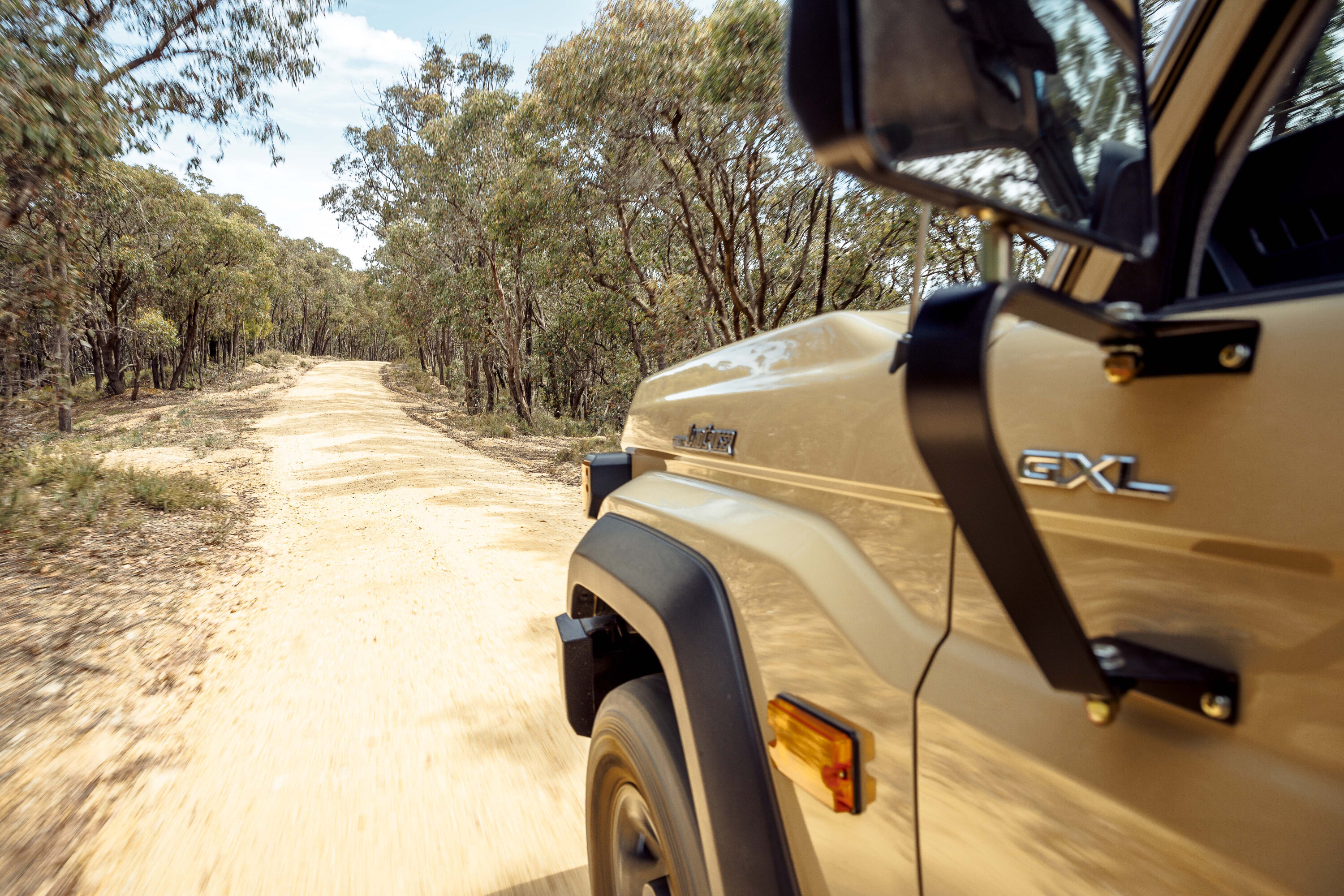
Interior
The LC79 cabin remains a big tin box. Relatively uninsulated when compared to more modern vehicles, it’s tinny and noisy, transmitting road noise through the chassis and plenty of wind noise around the A-pillars and raised air intake. It really lets you know that the 70 is a commercial vehicle.
The GXL gets some concessions such as power windows and cloth seats, and there’s a new infotainment screen that is small by modern standards but it allows you to hook up your phone for Apple CarPlay and Android Auto.
The sound from it is shocking, as it still pumps out through a pair of paltry four-inch speakers mounted in the dash panel. It’s no wonder aftermarket sound-deadening kits and audio-system upgrades are big business for these Cruisers.
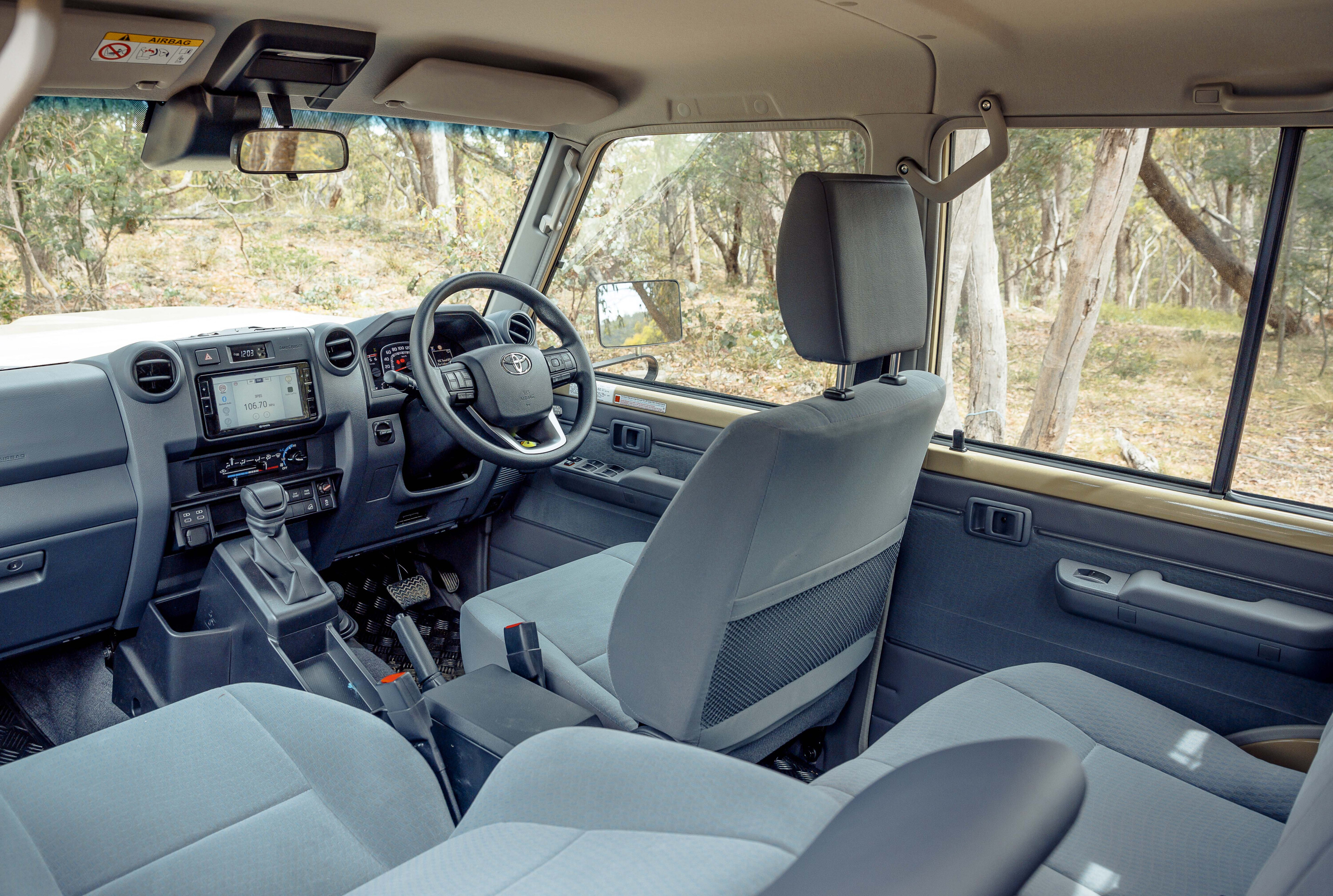
New for the 2024 70 Series range is a fresh gauge cluster that is another nod to the 40 Series with its retro electronic gauges.
This is one of my favourite parts of the new 70 as I love the look, and having a digital speed readout in the 4.2-inch display is always a plus when driving in Victoria. Speed sign recognition in the same panel is also welcome.
The seats are slim but comfortable enough, but again you can see why many owners choose to fit aftermarket options. The rear seat has plenty of room for three passengers but adults will be shoulder-to-shoulder back there.
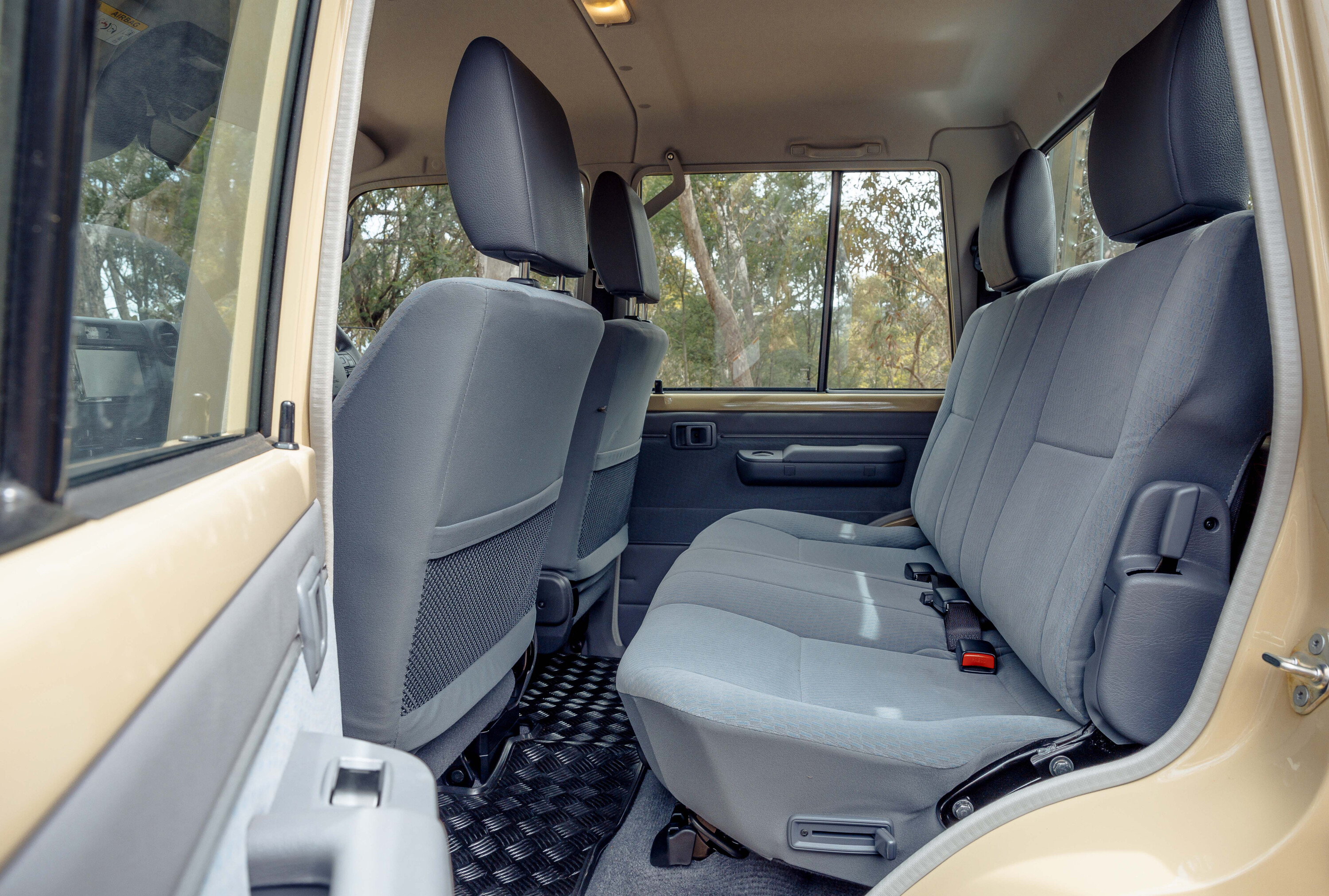
Safety
Safety-wise the new features include lane departure warning, pre-collision system with pedestrian and daytime cyclist detection and intersection assistance, stability control, brake assist, and electronic brake force distribution.
It’s small steps forward in terms of safety when compared to newer vehicles but when you consider Toyota is building on a 40-year-old platform, any advance is a step forward.
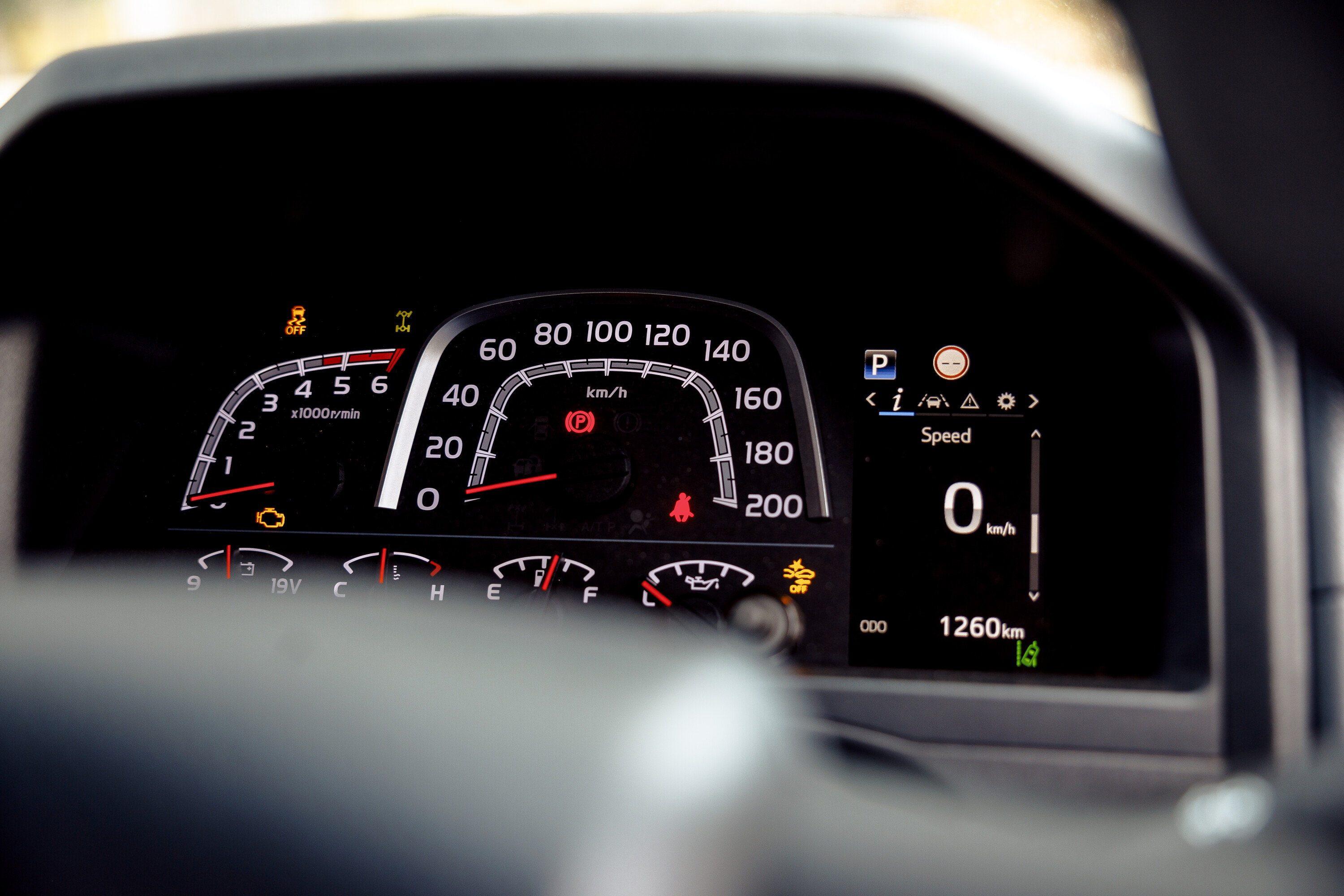
Verdict
The LandCruiser 70 Series isn’t about the latest safety, comfort and convenience features; many of these features have been forced upon it just so it can be sold in modern times.
Likewise the introduction of the 1GD 2.8 engine is future proofing the iconic workhorse against possible changes to emissions regulations which might soon rule out the 1VD V8 engine from Australian sales, while at the same time introducing an automatic transmission to fill that hole in the market.
Of course, there will still be those who call out for an auto behind the V8, whereas I feel the best combo would be a six-speed manual behind the 2.8; everyone wants something different, which is why the 70 Series remains one of the most customised 4x4s on the market.
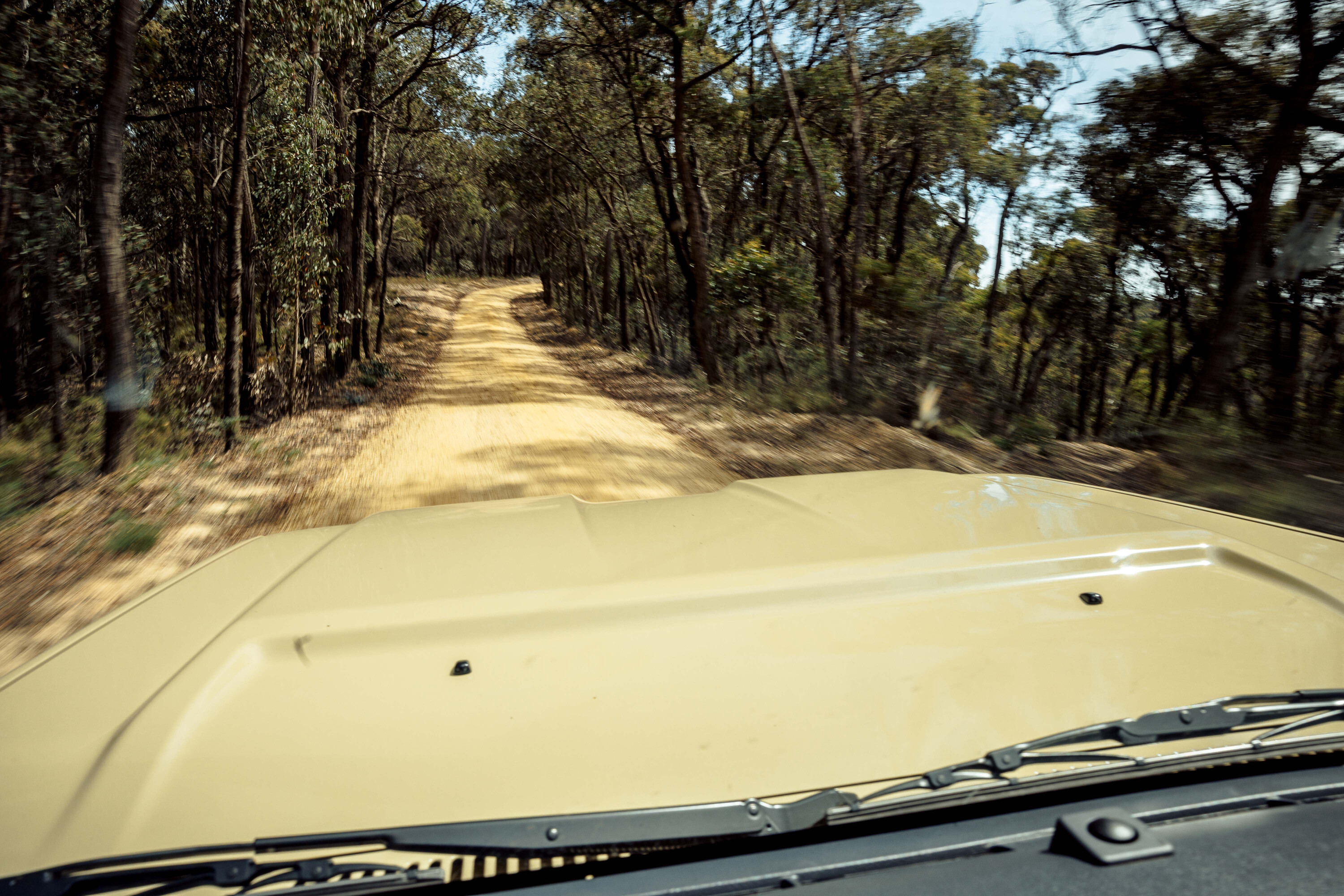
The 2.8/auto powertrain brings the 70 back to being more of a workhorse than a hot rod, as some treat the V8 these days.
With this new drivetrain the 70 is a better-working truck suited to more industries and drivers which is what it was originally designed to be more than 40 years ago.
The 70 Series Cruiser, no matter what model you choose, remains a unique vehicle in the market and we should appreciate what has been done to keep it available to us. There is nothing else like the LC79; ever since Nissan stopped building its Patrol ute and Land Rover its Defender pick-up, the LC79 has been in a class of its own.
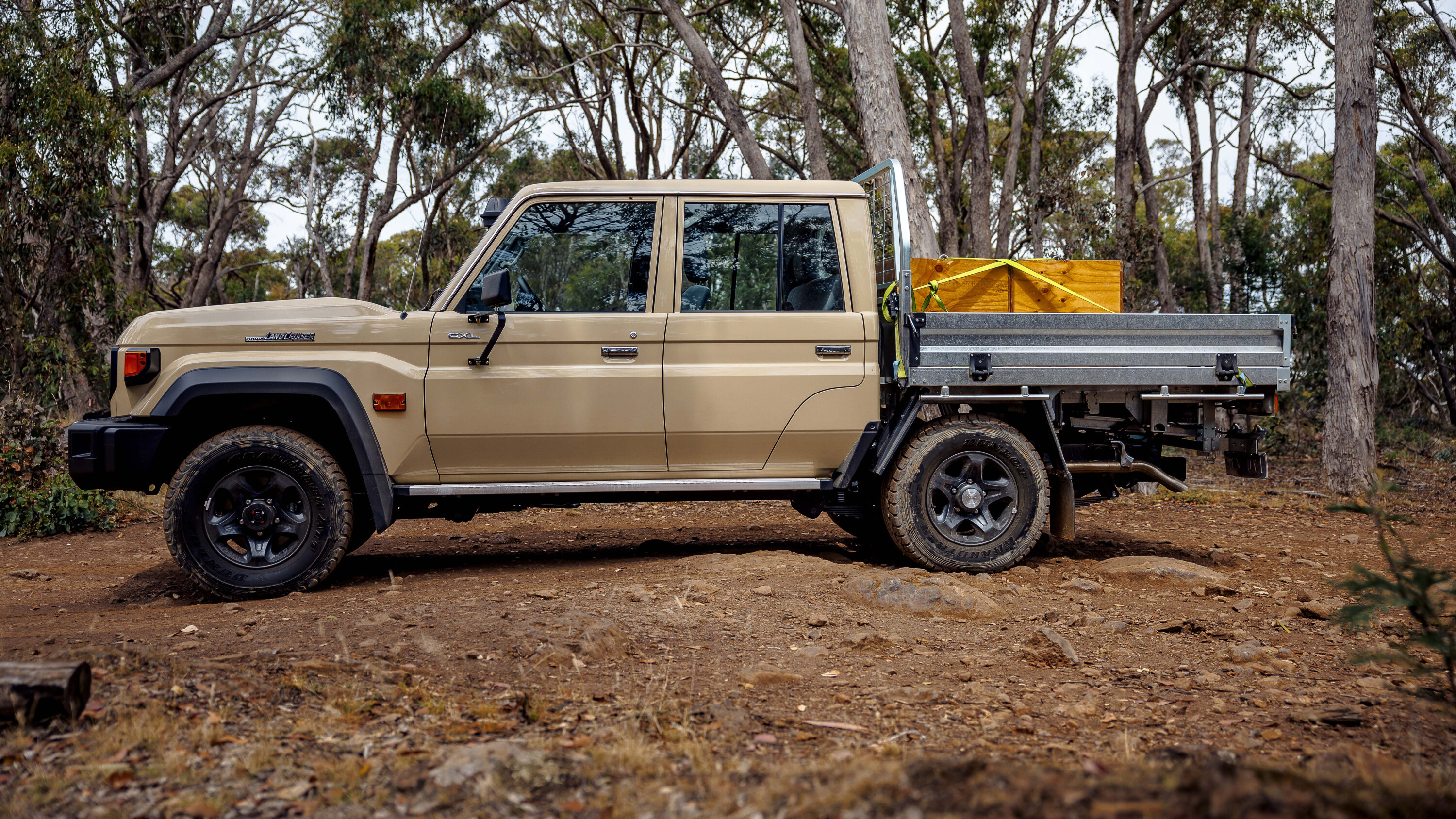
Big American pick-ups don’t come near the 70 for off-road ability and rugged durability.
It’s made to carry loads over rough tracks all day, every day. Likewise, no midsize 4×4 ute can match the capabilities of the 70 when the going gets tough. It will be interesting to see how the Ineos Quartermaster compares to the 79 when it is released later this year but it has four decades of glacier-paced development to catch up on.
While there are plenty criticise the 70 for its basic design and high price, I reckon we should be grateful that it is still with us.
Specs
| 2024 LandCruiser GXL 79 Double Cab 2.8 specifications | |
|---|---|
| Price | $83,500 |
| Engine | Inline 4 diesel |
| Capacity | 2755cc |
| Max power | 150kW@3000-3400rpm |
| Max torque | 500Nm@1600-2800rpm |
| Transmission | 6-speed automatic |
| 4×4 system | Part-time 4WD, dual-range, front and rear lockers |
| Crawl ratio | 38.51:1 |
| Construction | 4 door ute body on ladder frame chassis |
| Front suspension | Live axle with radius arms and coil springs |
| Rear suspension | Live axle on leaf springs |
| Tyres | 265/70RR16 on alloys |
| Kerb weight | 2185kg |
| GVM | 3510kg |
| GCM | 7010kg |
| Towing capacity | 3500kg |
| Payload | 1325kg |
| Seats | 5 |
| Fuel tank | 130L |
| ADR fuel consumption | 9.6L/100km combined |
| On-test fuel consumption | 14.01L/100k |
